

18 Top Attractions & Places to Visit in Death Valley, CA
Written by Lana Law Updated May 3, 2023 We may earn a commission from affiliate links ( )
Author Lana Law has visited Death Valley many times and in different seasons to enjoy photography, hikes, and to see the wildflowers in bloom.
Despite the forbidding name, Death Valley is a beautiful area of desert wonders and one of the best national parks in the United States . Sand dunes, salt flats, mountains, craters, and the lowest lake in North America make for some of the most spectacular scenery in the Southwest.
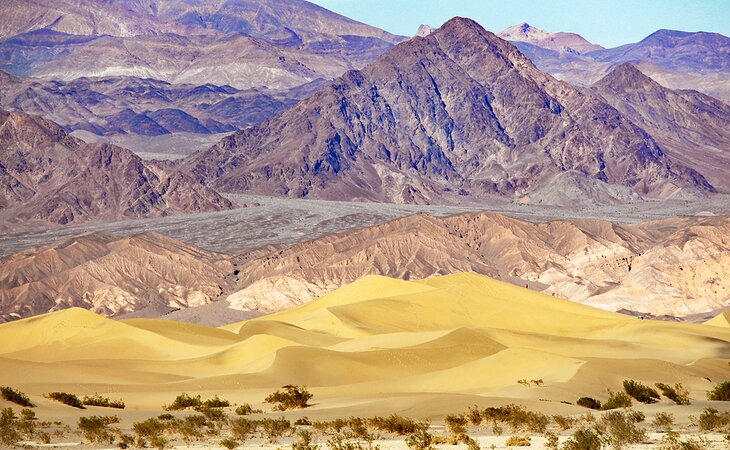
The valley, protected as a national park, covers 3,000 square miles and is known for being the hottest, driest, and lowest point in North America . Roadside lookouts offer stunning panoramas, and hiking trails allow easy access to the terrain.
Many people visit the park on a day trip from Las Vegas . The centrally located Furnace Creek is the main service center in the park and is about a two-hour drive from Las Vegas. This is also where you'll find the park visitor center, campgrounds, restaurants, a store, a gas station, and The Ranch at Death Valley .
On the west side of the park, is Panamint Springs , with a restaurant, gas station, and some limited accommodation. This is a convenient stop if you are entering the park from the west side and a good lunch option if you are visiting Father Crowley Point and Darwin Falls, the two main tourist attractions on this side of the valley.
Determine what you want to see with this list of attractions and places to visit in Death Valley .
Note: Death Valley's roads, trails, and some attractions were badly damaged in August and September by torrential rains. Work is ongoing, and most things should be back up and running by mid-2023.
Also on This Page:
1. sand dunes near stovepipe wells, 2. badwater basin, 3. the racetrack, 4. zabriskie point, 5. dantes view, 6. artist's drive and artist's palette, 7. devil's golf course and artist's drive, 8. harmony borax works and the sand dunes near stove pipe wells, 9. twenty mule team canyon, 10. keane wonder mine, 11. father crowley point, 12. ubehebe crater, 13. rhyolite ghost town, 14. natural bridge, 15. spring wildflowers, 16. devil's cornfield, 17. darwin falls, 18. wild rose charcoal kilns, map of attractions & things to do in death valley, ca, driving routes through death valley national park.
- Organized Tour of Death Valley
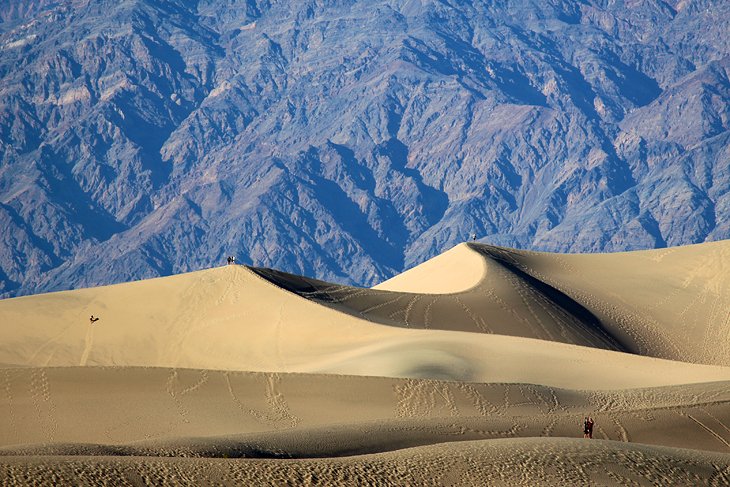
One of the most beautiful sites and most photographed landscapes in Death Valley is the Mesquite Flat Sand Dunes , just east of Stovepipe Wells . In the morning and late afternoon, when the sun hits the sculpted dunes, creating long curving shadows, the views are fantastic. Mountains rise up on the horizon providing the perfect backdrop. For photographers, it's pure magic.
You can walk in the dunes, climb to the highest points, or set up a lawn chair and soak up the desert scenery. On busy days in the spring, there is rarely a dune without a person climbing up or running down, but on quiet days, particularly in January or February, you will likely have the dunes to yourself. If you arrive at the dunes after a windy spell, they will be untracked.
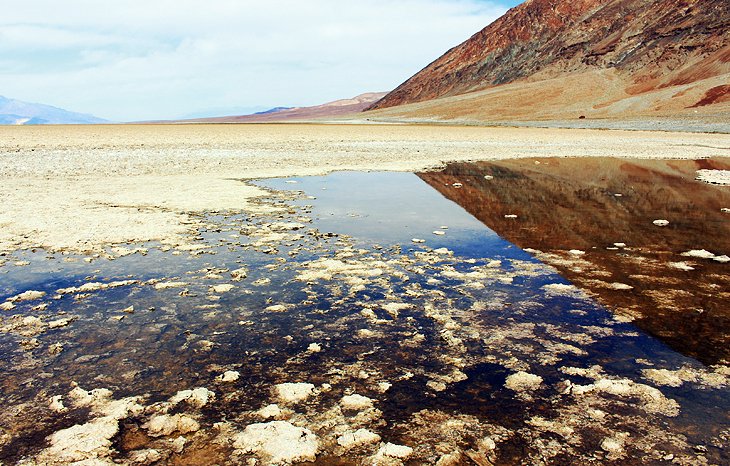
At the south end of Death Valley National Park, Badwater Basin is the lowest point of land in the western hemisphere , at 277 feet below sea level. Needless to say, this area is very hot, even in the winter.
Badwater Lake is a shallow lake surrounded by mountains and rimmed with salt, but you may not always see water here. Depending on the conditions or the time of year, Badwater may be quite full or have very little water. In either case, the area is interesting and there are a number of things to do.
When there is almost no visible water from the shore, you can walk out, seemingly endlessly, across the white salt flat. When there is water, and if the air is still, which it often is in the morning and early evening, the mountains across the valley reflect in the water, and the scene is stunning. This can be a wonderful area for photography. If there is enough water, it's even possible to paddle out on the lake.
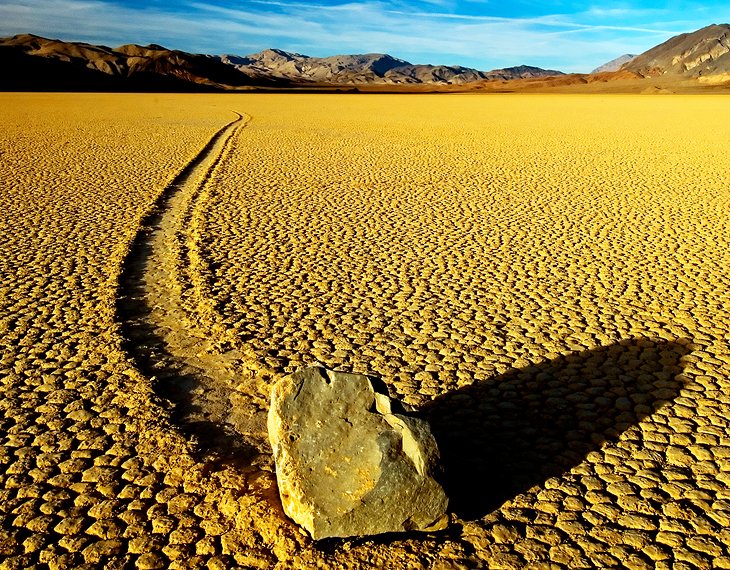
With a four-wheel-drive vehicle , you can take a rugged road that leads to one of Death Valley's most mysterious sights, known as The Racetrack. This area is a huge dried mud bed, where stones of various sizes can be seen with long tracks trailing behind them, as if they have been pushed through the mud.
Speculation existed for years about how the stones were moved. Many thought the stones were pushed along by the wind after rains. However, more recently, with the help of time-lapse photography, it is thought that the stones are actually moved by floating ice pushing the rocks. Regardless of the method, the result is a most interesting sight.
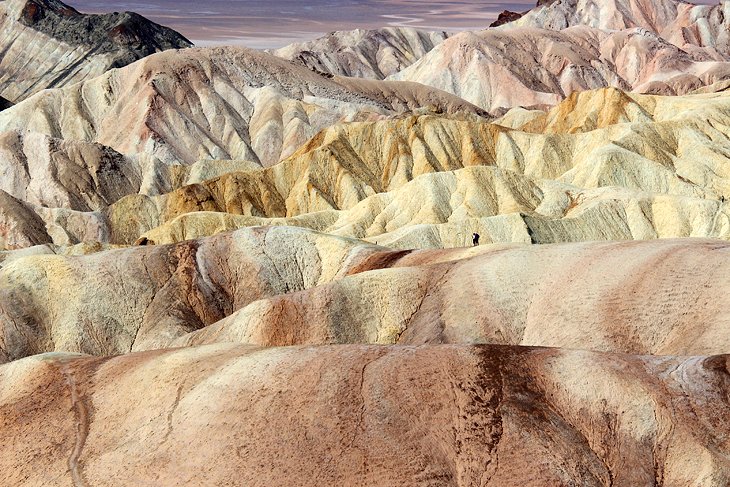
Zabriskie Point looks out over a surreal landscape of undulating, hard-packed ridges of gold, orange, and brown earth. Sweeping views from the lookout extend over this unique formation and beyond to the valley behind and the Panamint Mountains in the distance. The colors are particularly spectacular in the morning or late afternoon.
You can drive to the lookout at Zabriskie Point. A 7.8-mile hiking trail leads out from Zabriskie point, but if you want to get out on the ridges and immerse yourself in the scenery without undertaking a long hike, just wander out a short distance and return on the same track.
You can reach Zabriskie Point by heading east from Furnace Creek on highway 190 for four miles. If you are coming into the park from Las Vegas on the route described above, this is one of the stops on your way to Furnace Creek.
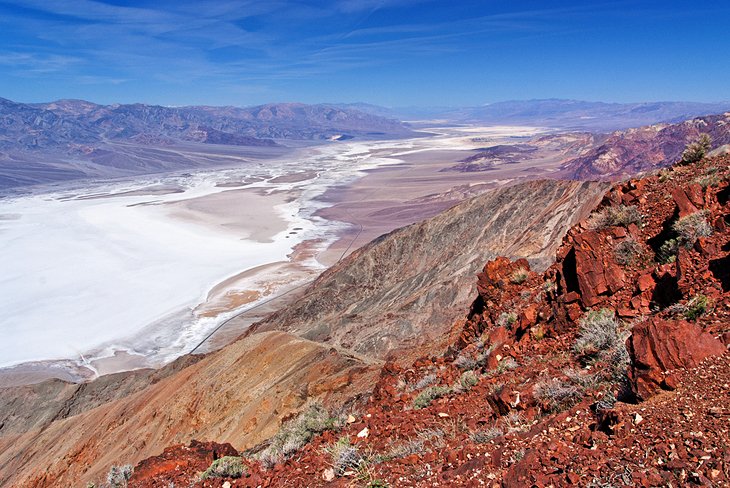
Dante's View offers one of the best overall perspectives of Death Valley. The view from the top looks out over the valley floor, as far as the eye can see, and across to the mountains that line the far side of the valley.
This lookout is a little out of the way but worth the effort. From Zabriskie Point head east on Highway 190 to the sign-posted turn for Dante's View. From the highway, it is a 16-mile drive along a twisty, paved road to the top , which stands at 5,478 feet above sea level. Vehicles on this road must be less than 25 feet in length.
The temperature up here is much cooler than on the valley floor, which can be a refreshing treat on hot days.
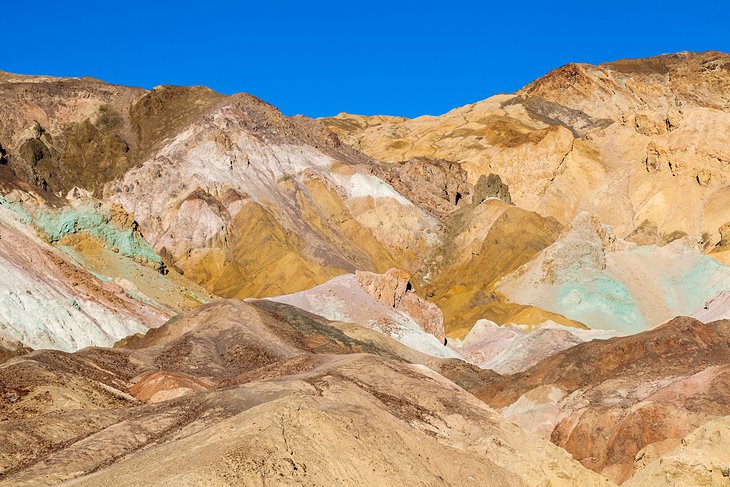
Artist's Palette is an area located along Artist's Drive, a short scenic road that takes you up close to a section of the Black Mountains. Artist's Palette is a colorful section of hillside, with shades that range from orange, pink, and brown to green and turquoise, created by metals in the rock.
Artist's Drive is a one-way, nine-mile paved loop , accessible to vehicles under 25 feet in length. This is a worthwhile side trip and a popular thing to do on the way from Furnace Creek to Badwater, located right off Badwater Road. If possible, try to do this drive in the late afternoon, when the colors are at their best.
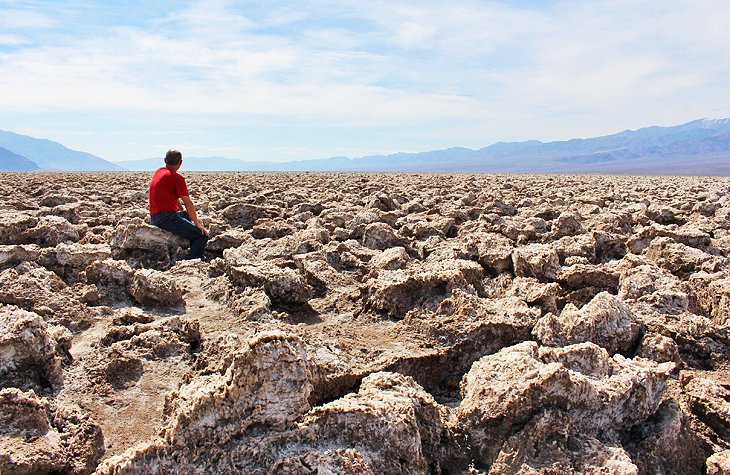
Devil's Golf Course is a flat expanse of sharp salt crystals that form a huge field of jagged salt boulders . It may seem like there isn't much to see here, but the vastness, solitude, and quietness, along with the unusual sight, create a unique experience.
Located south of Furnace Creek, just off the main road heading towards Badwater (Badwater Road) this is an easy stop. From the parking area, you can walk right out onto the field, if you choose.
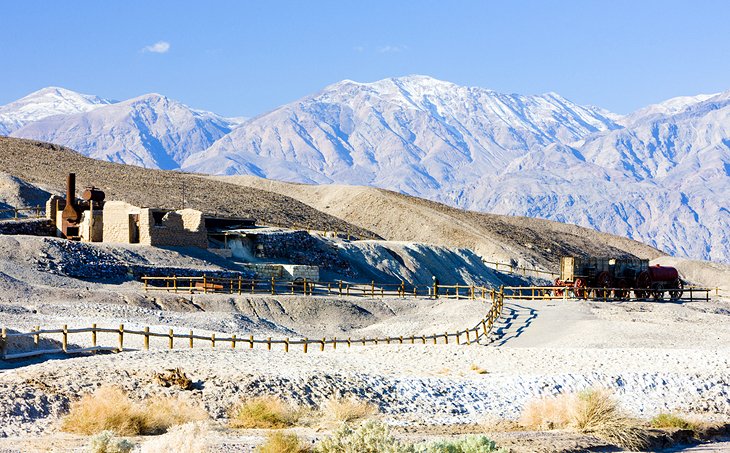
Aaron Winters found borax in Death Valley in 1881. He soon sold his claims to William T. Coleman, builder of the Harmony Borax Works, where borate-bearing muds were refined until 1888. The site of the former operation is located just north of Furnace Creek.
You can wander around the crumbling adobe walls and see the old broiler and some of the vats. Also located here are wagons once used for transporting goods out of the valley. Closed in 1888, this was the first successful borax works in the history of borax mining in Death Valley.
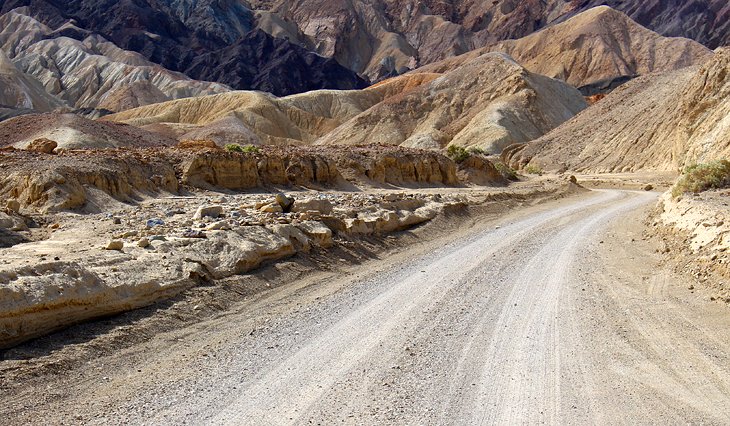
Twenty Mule Team Canyon is a 2.7-mile one-way dirt road that runs through some fantastic scenery. The road is bounded in some areas by rock walls on either side, barren flats, and colorful hills, similar to those found just down the road at Zabriskie Point. The terrain here is different from other parts of the park and reveals the ruggedness of the region.
During the borax days, twenty mule teams were used to haul the borax-filled wagons out of Death Valley, and this road offers some perspective on the type of landscape these vehicles were forced to contend with in the 1880s. However, there is no indication that this specific route was used in this fashion.
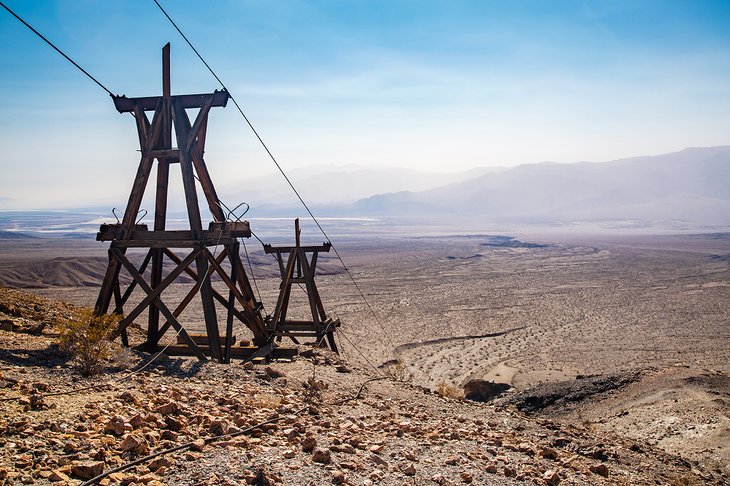
The remains of this historic gold mine can be difficult to get to but worth the effort if you are interested in this type of attraction. You can see the old aerial tramway , which is still intact, along with other structures. The mine is set on a hillside, and views extend across the valley.
Getting to the site involves a drive down a rough dirt road, which is usually passable in a regular vehicle, and a short but moderately strenuous hike from the parking area. The road is just under three miles, and the hike is a quarter of a mile to the lowest section of the tram.
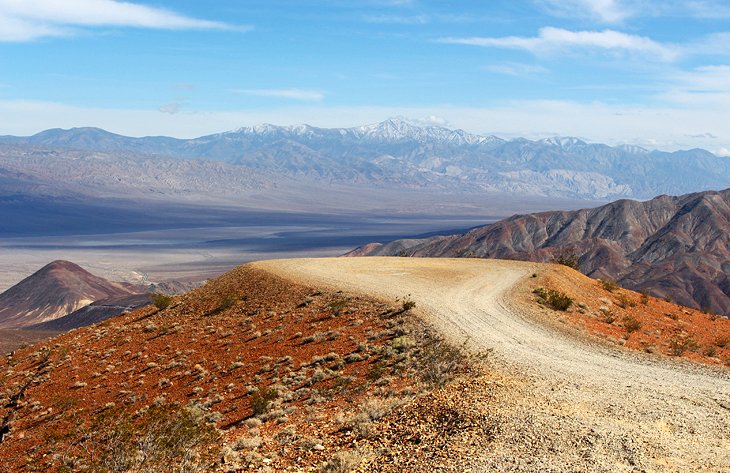
Father Crowley Point is a high lookout on the west side of the park that offers a different perspective than viewing areas on the busier east side of the park. If you are entering Death Valley from the west, Father Crowley Point should be your first stop before the long descent towards Panamint Springs.
There are two parking areas: one right at the overlook and another further back, closer to the highway. The first parking lot is easily accessed right off the main highway, and many people choose to walk the short distance out to the lookout point. The road to the lookout is not paved, quite bumpy, and may require high clearance.
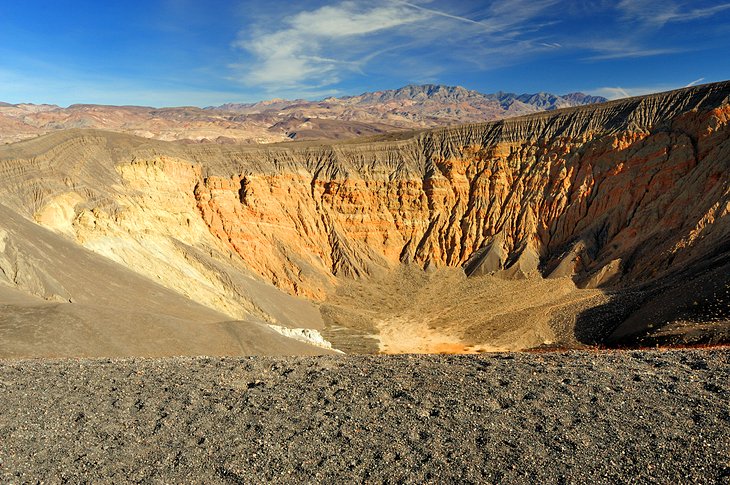
The Ubehebe Crater measures about a half-mile wide and 400 feet deep, and it is the only crater in the area that resulted from a volcanic explosion . It is located at the north end of Death Valley, in the general vicinity of Scotty's Castle, which is closed due to flooding.
The landscape here is different from other areas of the park. The ground is dark, with lava flows and cinders. If you are feeling up for a walk, trails lead down into the crater.
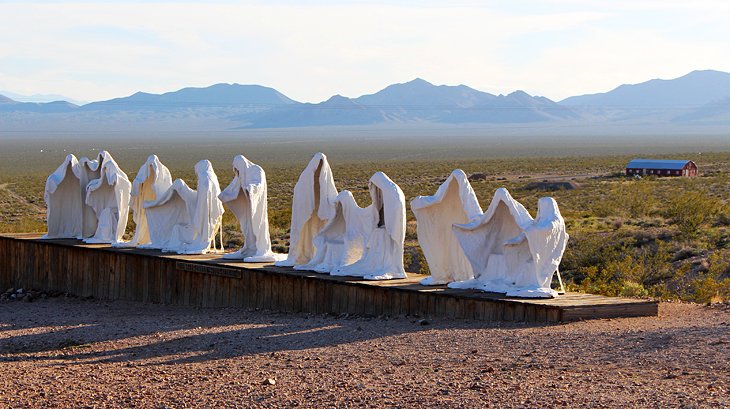
Rhyolite is an abandoned mining town, with remnants of its glory days visible in the crumbling and decaying old buildings. One of the highlights of this ghost town is a unique art installation of ghostly figures erected on the edge of the town. One large piece, standing before a vast expanse of desert, displays ghosts arranged in the form of The Last Supper .
Other pieces are also found here, in what is now called the Goldwell Open Air Museum , including a giant pink lady made of blocks, called "Lady Desert: The Venus of Nevada."
Rhyolite is a good stop on your way out of the park. It is located off Daylight Pass Road (highway 374) just outside the park boundary, on the way to Beatty.
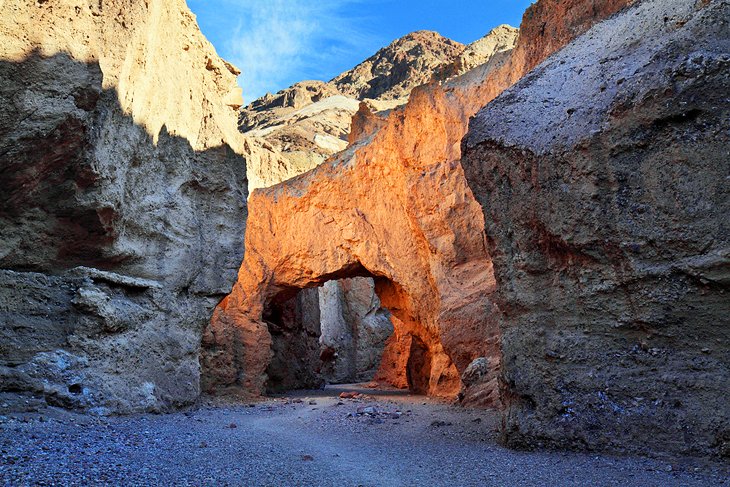
Natural Bridge is, as the name suggests, a large natural bridge set in a canyon, not far from Badwater.
An easy two-mile round-trip hike leads to the end of the canyon, but if you only want to see the bridge, it is located about half a mile from the parking area . In the midday heat, this can still feel like quite a journey, and it may be something you want to tackle earlier in the day. The parking area is located 1.5 miles along a dirt road off Badwater Road.
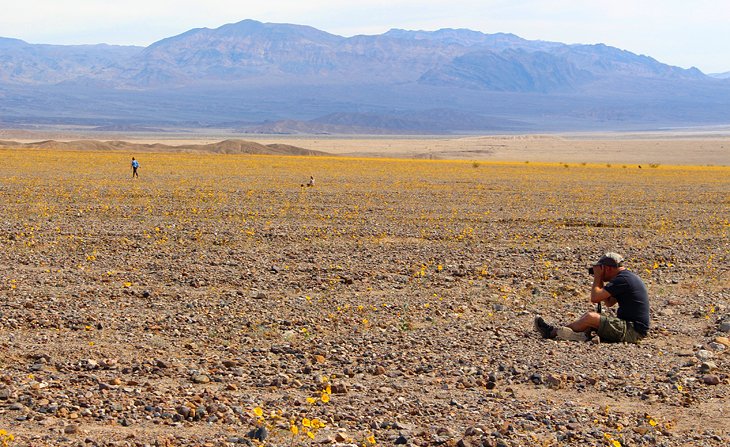
One of the park's biggest attractions is the spring wildflower bloom, which usually peaks in March . Depending on the year, the conditions, and the extent of the bloom, this event can draw thousands of people to the park. To anyone unfamiliar with deserts, it might seem amazing that anything can grow in these hot dry conditions.
On weekends during the bloom, it's not uncommon to see people pulled off to the side of the road all over the park, picnicking on the bare ground, meditating among the flowers, or walking through the fields. Despite the fact that people do this, you should not walk out in the fields and trample the flowers.
One of the best places to visit to see this beautiful display is in the south part of the park around Badwater and up towards Furnace Creek , where a carpet of yellow spreads across the valley floor. Areas further north also see a good display of flowers, usually with a mix of colors that range from white and yellow to orange and purple.
The park visitor center can point you in the right direction and offer information on what is blooming while you are in the park.
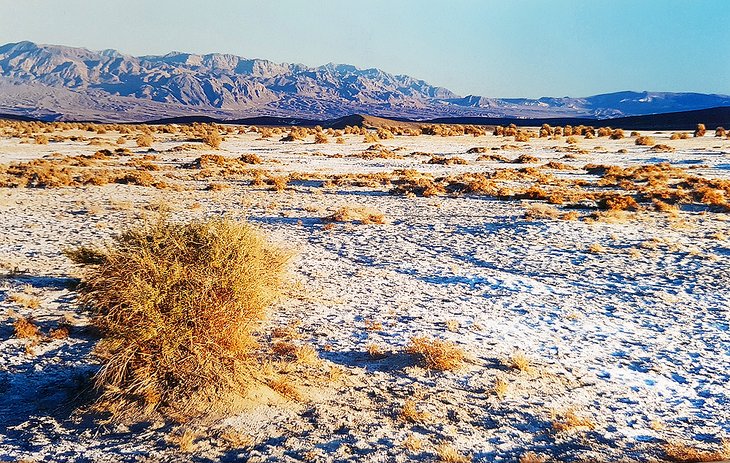
Compared to the rest of the sights in Death Valley, Devil's Cornfield is not necessarily worth going out of your way to see, but it's a sight you will pass if you are driving from the east to Stovepipe Wells and the sand dunes.
Clumps of vegetation that look like tumbleweeds dot the landscape as it stretches out to the distant hills and mountains. Depending on the time of year, the shrubs may be green or dried out to an amber color. Photographers can have some fun in this area, particularly in the late afternoon.
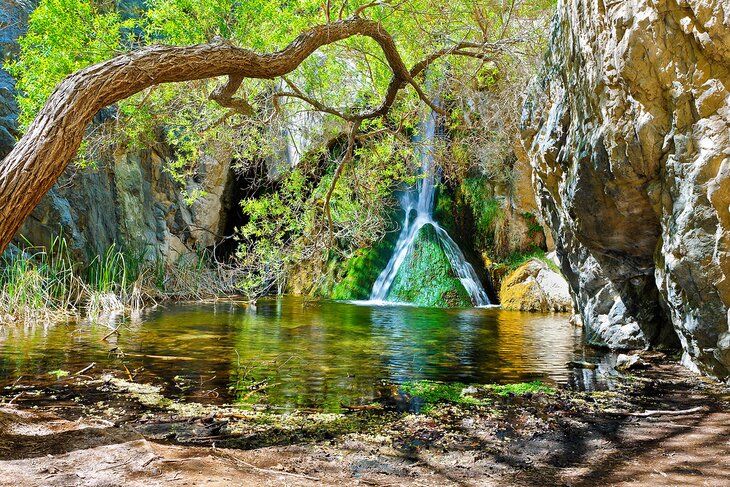
After your trip, when you tell your friends about your experiences in Death Valley and include the fact that you visited a waterfall, they may think you are trying to play a joke on them. However, break out the photos and show them that this amazing natural wonder actually exists.
The trail is 1.9 miles long and with an elevation gain of only 275 feet , most people consider it fairly easy and suitable for all abilities. You'll start out at a valley entrance and as the trail progresses, it gets increasingly narrow. You'll hear the falls before you see them. Although not overly high, the flowing water with a pool below is a very welcome sight in the desert.
Note the trail was damaged during the August 2022 floods. It is still passable but caution is advised.
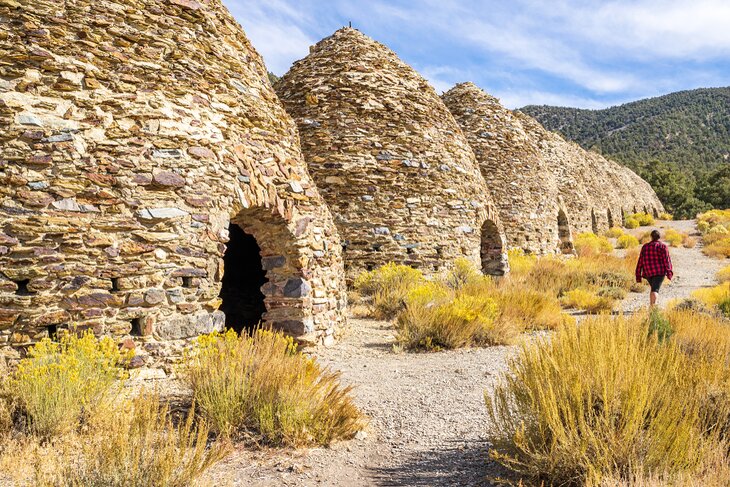
An off-the-beaten-track attraction that, if you have the right vehicle, is worth visiting is the Wild Rose Charcoal Kilns. These beehive-shaped stone structures are in remarkably good shape considering that they were used back to make charcoal when the park area was a mining hot spot at the turn of the 20th century.
The Wild Rose Charcoal Kilns have doors that are open, and you can wander freely in and out of the structures. It's more than likely that you'll have this remote spot to yourself — the road is notoriously bad and suitable for high-clearance 4WD vehicles , only.
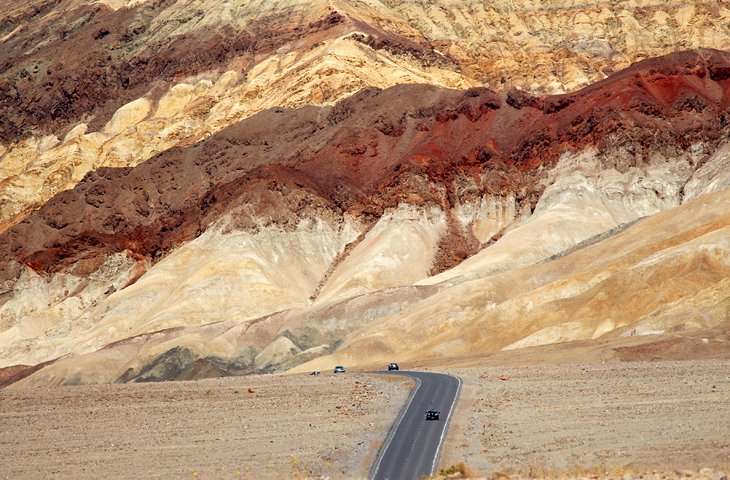
Most visitors come either from California, entering from the west off Highway 395 onto Highway 190, through Panamint Springs, or from Las Vegas, where there are a couple of routing options.
From Las Vegas: You can easily visit Death Valley on a day trip from Las Vegas . The best way to do this is to head out on Highway 160 (leaving from the south end of Las Vegas) to Death Valley Junction, where the road becomes Highway 190, entering the park. This road runs past the turnoff for Dante's View , Twenty Mule Canyon, and Zabriskie Point, and on to Furnace Creek with a park visitor center and some amenities.
From Furnace Creek you can head south to Badwater , passing the pullouts for Desolation Canyon, Artist's Drive (Artist's Palette), Devil's Golf Course , and Natural Bridge . When you have visited Badwater, backtrack via Furnace Creek and beyond to the Harmony Borax Interpretive Trail, Mustard Canyon, and the Sand Dunes near Stovepipe Wells .
If you started early in the day and still have plenty of time, you may want to continue on. It's a little over a half-hour to Panamint Springs and another 20 minutes to Father Crowley Point . After this, you can turn around and head back to Stovepipe Wells, and out of the park on the Daylight Pass Road (374) that leads to Beatty.
Before getting to Beatty, stop at the Rhyolite ghost town to see the ruins of this old mining town and some creative art installations. From Beatty take Highway 95 back to Las Vegas.
If you have time for a second day in Death Valley , you can spend the night in the park or in Beatty. With two days, you'll be able to add on a visit to the Race Track and a few more stops for hiking and sightseeing.

More on California
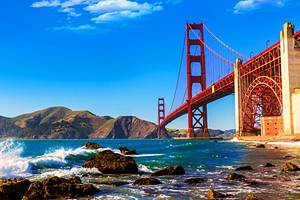
Things to Do in Death Valley National Park, CA - Death Valley National Park Attractions
Things to do in death valley national park, explore popular experiences, ways to tour death valley national park.

Death Valley Sunset and Starry Night Tour from Las Vegas

Death Valley Small Group Day Tour from Las Vegas

Death Valley Explorer Tour by Tour Trekker

Small-Group Death Valley National Park Day Tour from Las Vegas

Death Valley Sightseeing Tour with Stargazing and Wine Tasting

Death Valley National Park Self-Guided Audio Driving Tour

Death Valley Day Trip from Las Vegas

Small Group Tour at the Death Valley from Las Vegas + LUNCH

- Death Valley National Park Audio Guided Driving Tour

Death Valley Sunrise & Stargazing Day Tour Group Discount for 2 More People
Tours & sightseeing.

Top Attractions in Death Valley National Park
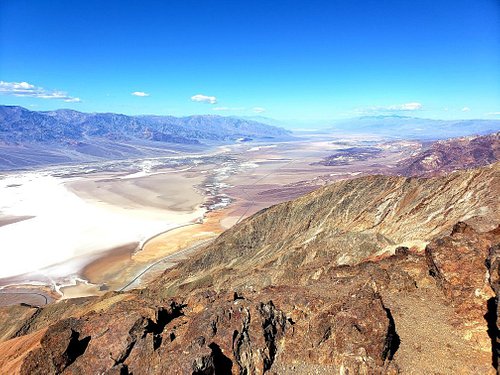
Other Top Attractions around Death Valley National Park
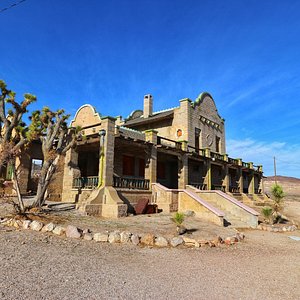
Outdoor Activities

Private & Custom Tours
Walking tours, what travelers are saying.
- Zabriskie Point
- Dante's View
- Artist's Drive
- Artists Palette
- Titus Canyon
- Ubehebe Crater
- Death Valley Sunset & Starry Night Tour from Las Vegas
- Death Valley Small Group Day Adventure From Las Vegas
- Small-Group Death Valley National Park Day Trip from Las Vegas
- Death Valley Self Guided Audio Driving Tour
THE 15 BEST Things to Do in Death Valley National Park
Things to do in death valley national park, explore popular experiences, ways to tour death valley national park.

Death Valley Sunset and Starry Night Tour from Las Vegas

Death Valley Small Group Day Tour from Las Vegas

Death Valley Explorer Tour by Tour Trekker

Small-Group Death Valley National Park Day Tour from Las Vegas

Death Valley Sightseeing Tour with Stargazing and Wine Tasting

Death Valley National Park Self-Guided Audio Driving Tour

Death Valley Day Trip from Las Vegas

Small Group Tour at the Death Valley from Las Vegas + LUNCH

- Death Valley National Park Audio Guided Driving Tour

Death Valley Sunrise & Stargazing Day Tour Group Discount for 2 More People

Top Attractions in Death Valley National Park

Other Top Attractions around Death Valley National Park

Nature and Wildlife Tours
Private sightseeing tours.

Walking Tours
Hiking tours.

Tours & Sightseeing
What travellers are saying.
- Zabriskie Point
- Dante's View
- Artist's Drive
- Artists Palette
- Titus Canyon
- Ubehebe Crater
- Death Valley Sunset & Starry Night Tour from Las Vegas
- Death Valley Small Group Day Adventure From Las Vegas
- Small-Group Death Valley National Park Day Trip from Las Vegas
- Death Valley Self Guided Audio Driving Tour

21 Best Things to do in Death Valley National Park
Written By: ThePlanetD Team
United States
Updated On: April 17, 2023
Planning to visit Death Valley? Get ready! Death Valley is the largest US national park outside of Alaska . It is the hottest and driest place in North America, and Badwater Basin is the lowest spot on the continent. Whew, Death Valley National Park has a lot going on, but that’s not all! Located in both California and Nevada, Death Valley National Park was established in 1994 after holding the title of Death Valley National Monument for five decades. And in 2013, it was fittingly designated as a Dark Sky Preserve.
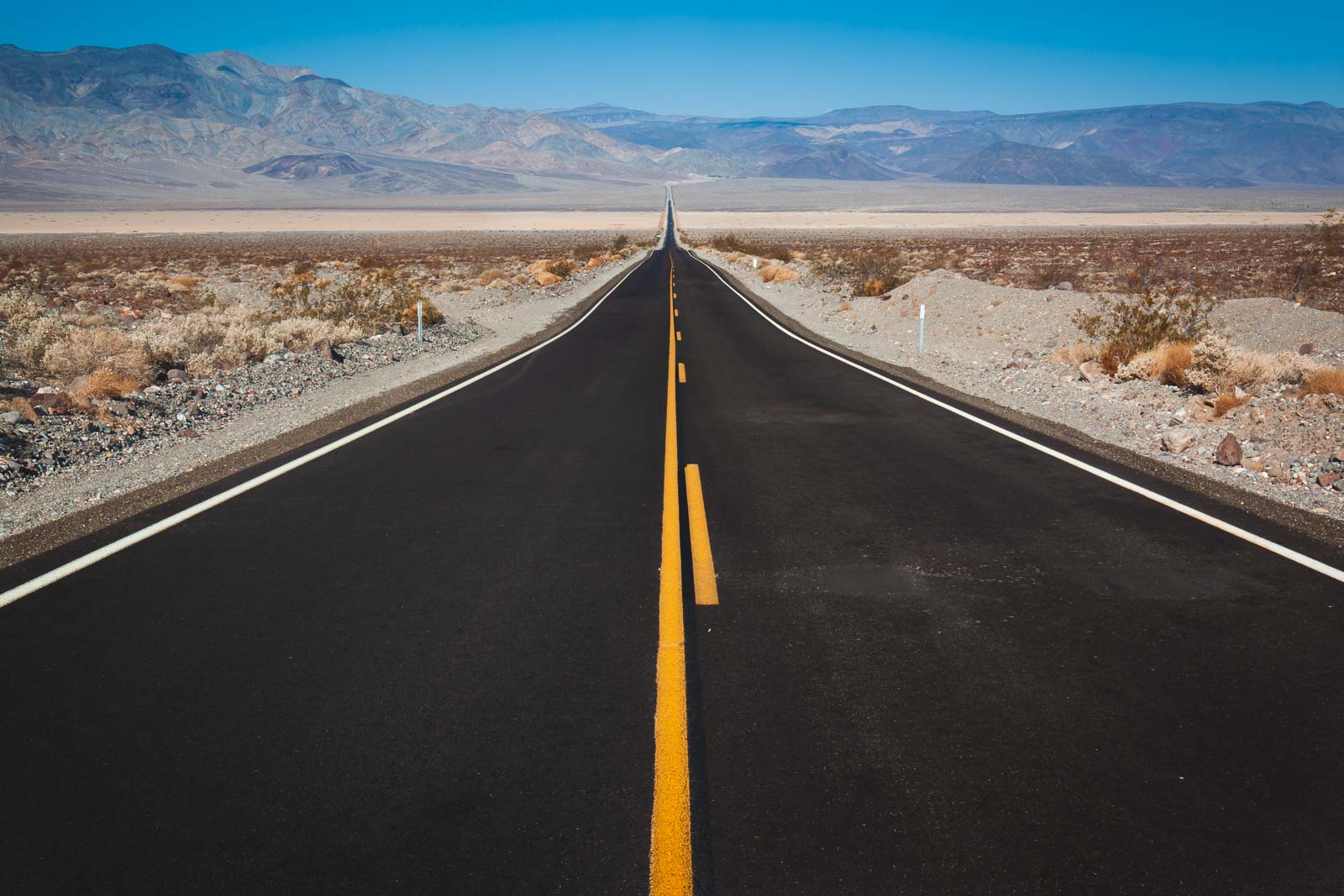
It is easily one of the most memorable places to visit for unique scenery. And as an added bonus, there are many amazing things to do in Death Valley National Park.
Table of Contents
Top things to do in Death Valley National Park
Note: The area has been dealing with extreme weather conditions and some roads are closed in Death Valley due to flood damage. At the time of publishing, many roads are closed including CA 190 west of Stovepipe and Badwater Road and Daylight Pass and Towne Pass are closed. See the National Parks Services Website for up-to-date information.
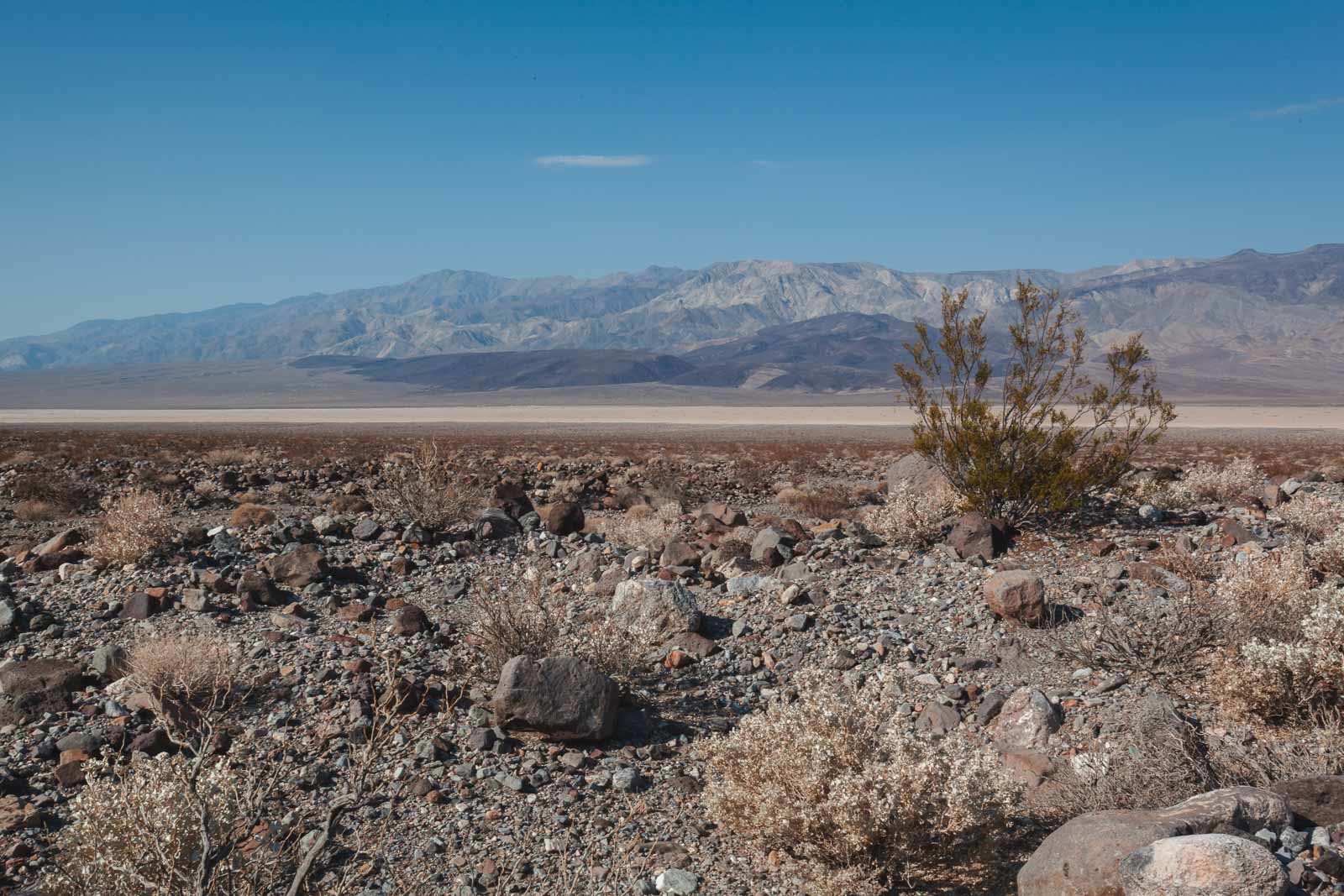
This guide will focus on the best things to do in Death Valley National Park. We’ll cover everything from Natural Bridge to hiking trails along the valley floor. Prepare yourself for some inspiring, exciting things to do in this California national park. If you are doing a self-drive through Death Valley, pick up this GPS driving tour . It highlights many of the top Death Valley attractions.
- make sure to have an ample supply of water before visiting
- stay on paved roads, and let people know where you are going and when you plan to return.
- If you plan on visiting any remote places in Death Valley, consider conveying with two or more vehicles should a breakdown occur.
- Make sure you have a full tank of gas and carry a paper map along with your GPS and cell phone.
1. Mesquite Flat Sand Dunes
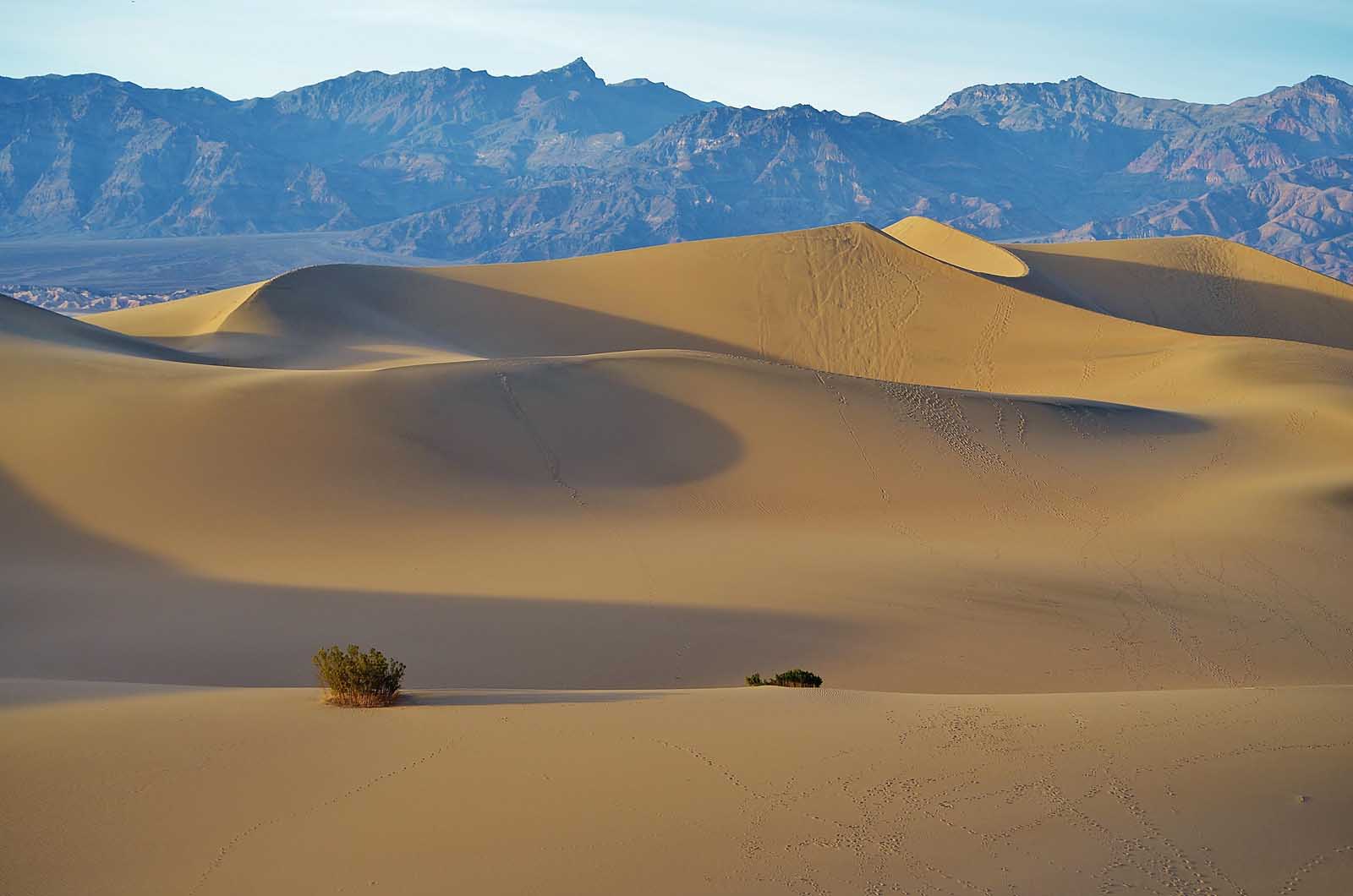
If you are looking for fun things to do in Death Valley National Park, sandboarding at Mesquite Flat Sand Dunes is easily one of the best. Mesquite Flat Sand Dunes are Death Valley’s most popular and easily accessible sand dunes, and some dunes tower as high as 100 feet. Even if you don’t fancy sandboarding, Mesquite Flat Sand Dunes are a great place to release your inner child and attempt to run down the sandy slopes.
Mesquite Sand Dunes are easily reached off the 190, and a reasonably large parking lot is just off the roadside. We suggest getting there early, so the sand dunes are still cool underfoot. There is no sandboarding rentals in the park, so you need to bring your own equipment.
2. Artist’s Palette
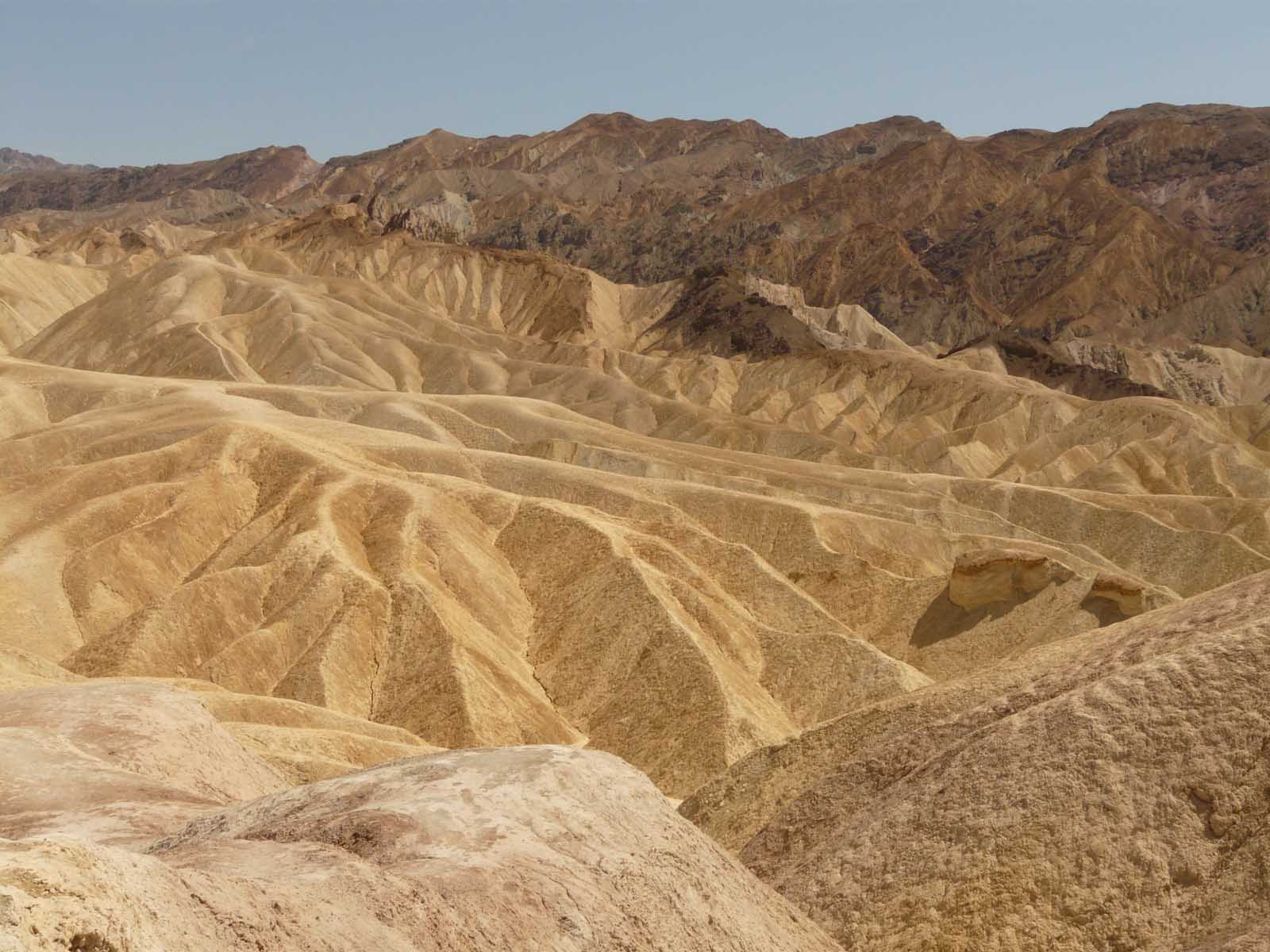
Artist’s Palette is a stunning viewpoint overlooking a collection of pastel-hued hills. The hills turned their unique color after millions of years of oxidation and weathering, and now visitors flock to come to view the phenomenon. The viewpoint gets its name, the ‘Artist’s Palette,’ from the blend of colors.
Artist’s Palette is located on Artist’s Drive loop located, just off Badwater Road. There is a tiny trail from the parking and toilet facilities to the viewpoint itself, and it is very easily reached if you are short on time. The attraction sits along the 9-mile Artist’s Drive loop, which is an attraction in its own right. It is worth allowing extra time to enjoy driving Artist’s Drive at leisure.
Check out this highly rated tour departs from Las Vegas in the early hours of the morning to reach the desert for stargazing and sunrise.
3. Natural Bridge
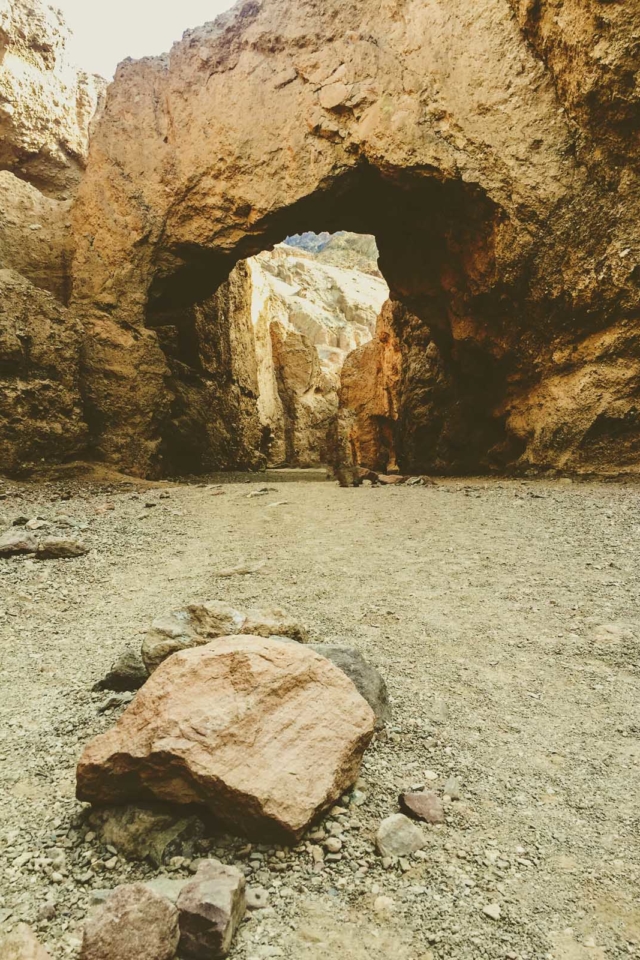
If you can’t make it to the sandstone arches of Arches National Park ; Natural Bridge is a vast, jagged arch that towers 35 feet above the canyon floor. Natural Bridge was formed by a rare series of flash floods over thousands of years. Visitors can hike to the bridge to walk underneath and admire the geological formation in all its glory. Visiting Natural Bridge is one of the most impressive things to do in Death Valley.
You have to hike to Natural Bridge, but the route is only a 2-mile round trip. It is the perfect hike if you don’t want to walk long distances in the heat, are in a rush, or traveling as a family. You also get a beautiful view of the salt flats on the return hike, sure to keep your spirits up.
Natural Bridge Trailhead is accessed via a dirt road off Badwater Road. You’ll find plenty of parking at the end but beware that the dirt road conditions can be rough. It is worth checking the road conditions on the National Park Service website before you attempt it. It is best suited to 4WD because of the likelihood of deep potholes.
This photography tour lets you explore Death Valley by day and night. Besides visiting its sand dunes, canyons, and wildlife, you’ll watch the sunset and stay into the starry night to enjoy the dark sky preserve. Details here
4. Devil’s Golf Course
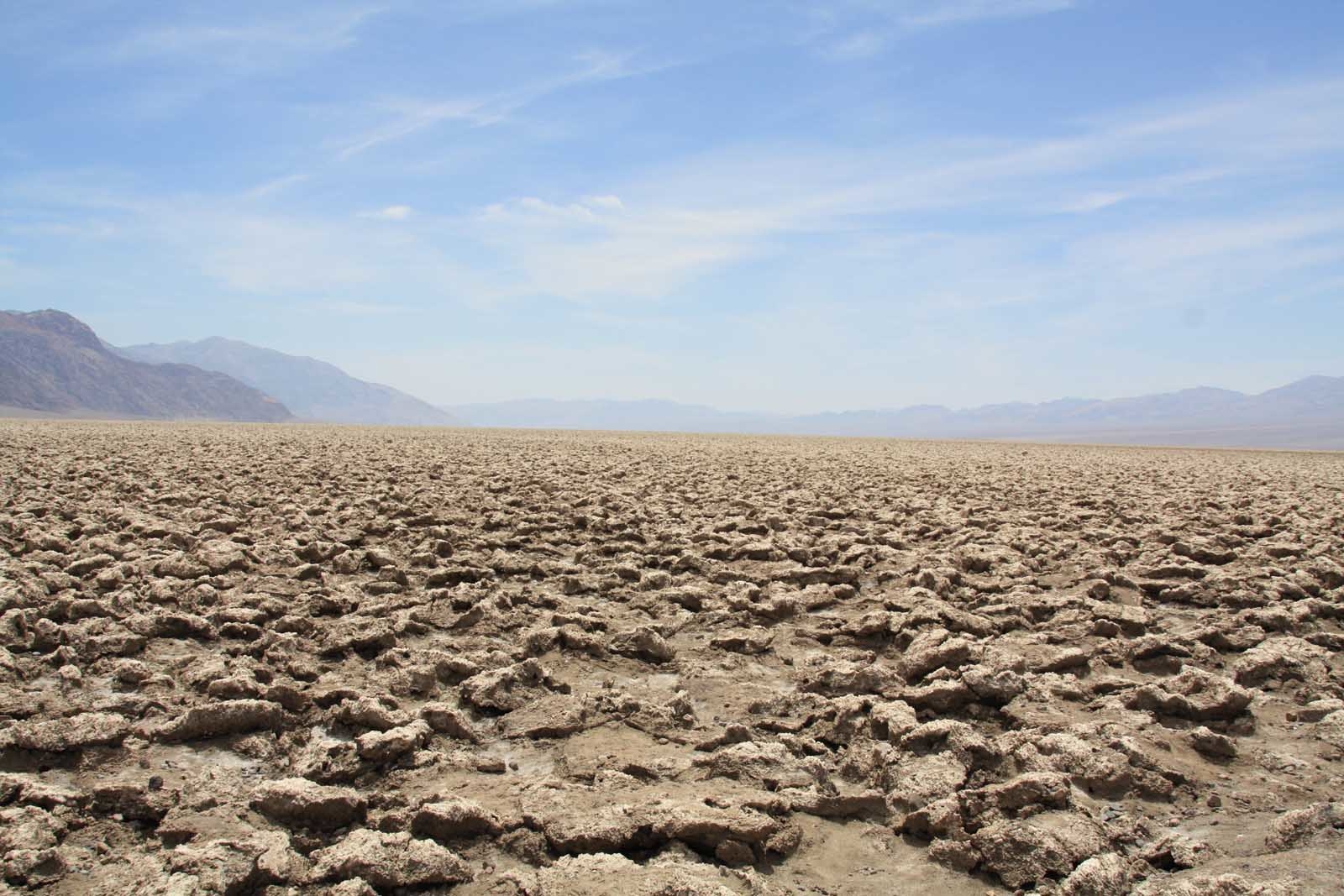
Devil’s Golf Course’s name might have you stumped about what it could be. The attraction is a salt pan, but the floor is so jagged and uneven that an old National Park Service guidebook quipped that ‘only the Devil could play golf there’. The salt pan floor is a far cry from its smooth salt flat neighbor Badwater Basin (which we’ll look at in more detail later), and you’ll find endless stalagmites. Some salt spikes are two feet high, so you’ll be carefully picking your way around a boardwalk rather than walking across the salt pan itself.
The Devil’s Golf Course was once covered by a lake, which evaporated and left behind a thick layer of salt and minerals – creating the natural phenomenon you see today. We highly suggest bringing a camera for this attraction, as it is easily one of the most striking things to do in Death Valley.
This full-day explorer tour by Trekker can be booked from Las Vegas where you hop aboard a custom-built Tour Trekker vehicle with stops including Furnace Creek, Devil’s Golf Course, Badwater, Zabriskie Point, and more
5. Twenty Mule Team Canyon
Twenty Mule Team Canyon is one of the most scenic dirt tracks you’ll see in your life. The short 2.5-mile road takes you through a range of stunning badlands, which are full of pastel colors and uniquely shaped by erosion. The drive may be short, but you’ll want to stop for photographs, so allow at least half an hour to experience it.
Twenty Mule Team Canyon isn’t just famous amongst tourists either. Movie directors have flocked to use the site for major productions, including Return of the Jedi. Star Wars fans should prioritize visiting Twenty Mule Team Canyon when they visit Death Valley.
The scenic drive is easy to reach, and you turn off the 190 onto 20 Mule Team Road before quickly reaching the dirt track turnoff. Twenty Mule Team Canyon is just half an hour’s drive from Furnace Creek Visitor Center. It is well-combined with a visit to nearby Zabriskie Point and Harmony Borax Works.
6. Golden Canyon
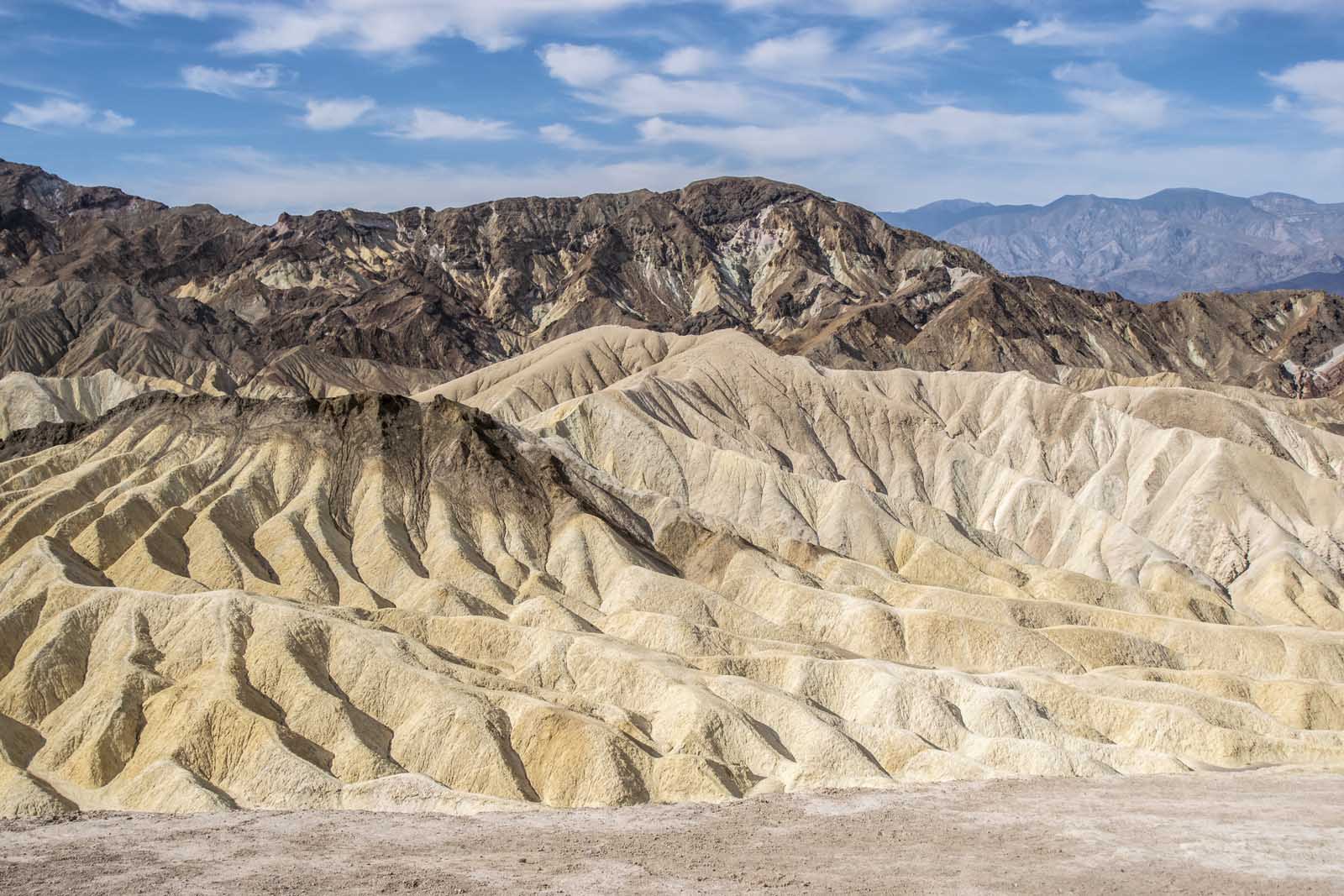
Are you ready for an incredible hike? Golden Canyon Trail is a stunning route through a honey-colored ravine on a clearly marked trail. You’ll want your camera for this one; Golden Canyon’s good looks have attracted the likes of Star Wars movie producers.
The trail is a 2-mile round trip with a short 3-foot rock scramble. The scramble is untechnical and suitable for anybody with good fitness and reliable footwear, so overall, the hike is easy to tackle in Death Valley National Park. Most hikers hike to Red Cathedral as an endpoint, although you can choose to go further if you want an extra challenge.
Golden Canyon is also located just outside of Furnace Creek. The trailhead is just a 7-minute drive from Furnace Creek Visitor Center – making it an easy addition to a busy itinerary. You’ll find a large parking lot and restrooms at the Golden Canyon Trailhead, accessed on a turnoff from Badwater Road.
This highly rated tour offers a full day from Vegas with a private guide and a custom itinerary. And the best part? You’ll have a professional photographer with you taking photos of the entire adventure.
7. Zabriskie Point
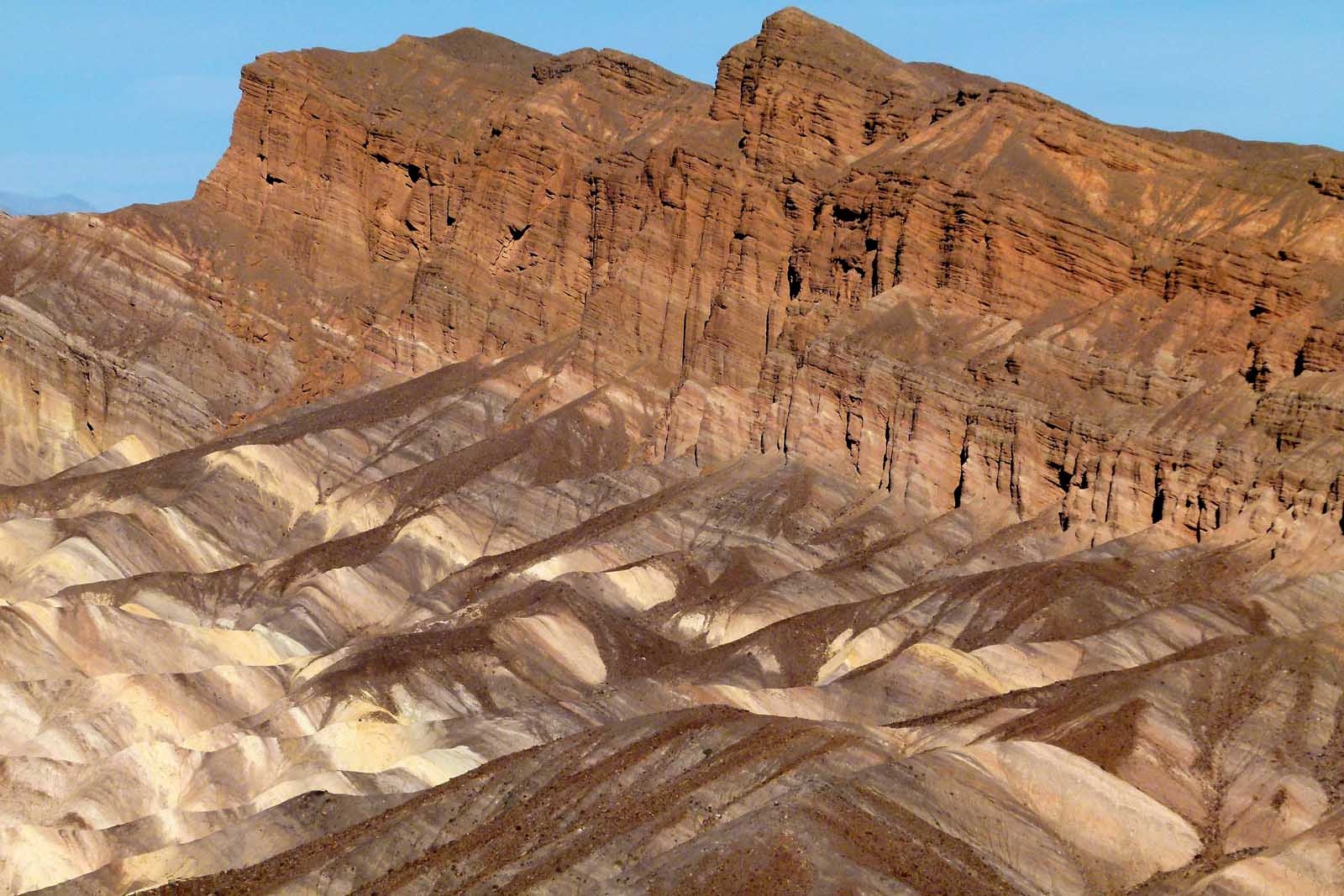
Visiting Zabriskie Point is one of the most beautiful things to do in Death Valley National Park. The viewpoint overlooks hilly, wrinkled badlands tinged in pastel, sandy colors. If you want a sunrise or sunset spot – Zabriskie Point is the one for you.
Zabriskie Point was formed when Furnace Creek Lake dried up around 5 million years ago. The sediments left behind formed the stunning hills, and erosion over the years shaped the landscape into what it is today.
Zabriskie Point is practically on the roadside. You drive on the 190 from Furnace Creek towards Death Valley Junction, turning off into Zabriskie Point Parking Lot to hike the short trail to the viewpoint. It is easy to access and is an excellent place to start your day, conveniently nearby Furnace Creek and the Visitor Center.
8. Badwater Basin
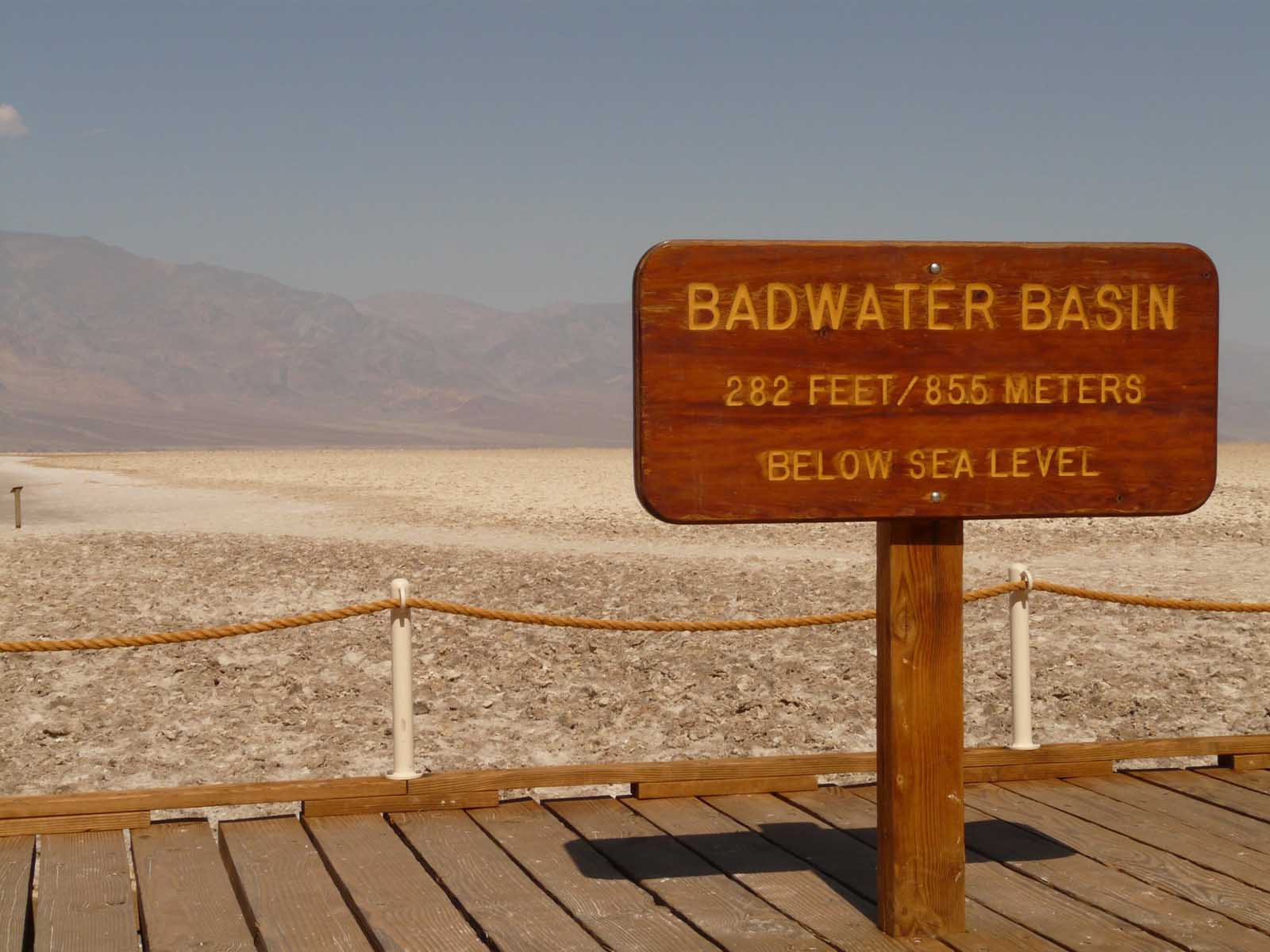
Visiting Badwater Basin is one of the most fascinating things to do in Death Valley. Badwater Basin is the lowest point in North America, at 282 feet below sea level. Badwater Basin has around 200 square miles of salt flats to explore – the largest protected salt flats in the world.
After it rains, Badwater Basin can appear mirror-like as the water reflects off the salt crystals. Badwater Basin looks like snow when it is dry, and the salt flats are arranged in small circular patterns along the valley floor.
Badwater Basin is accessible via a short trail off Badwater Road. You’ll find a toilet block and parking area near its trailhead. Badwater Basin is located extremely close to the Devil’s Golf Course and Dante’s View. Consider combining these three attractions if you drive down Badwater Road to reach Badwater Basin.
9. Scotty’s Castle
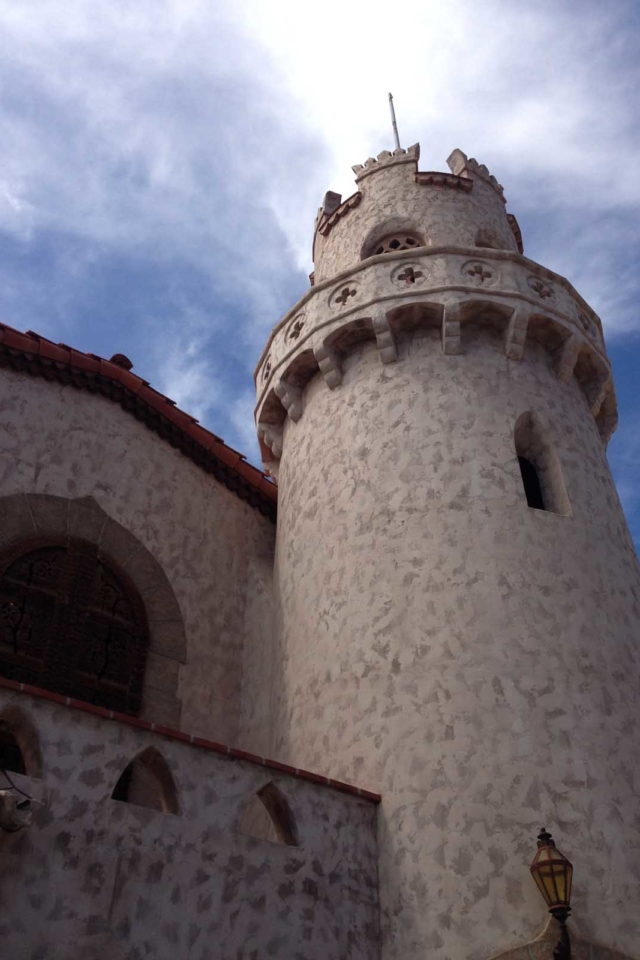
Death Valley isn’t all geology and hiking trails, and Scotty’s Castle is proof of that. The ‘castle’ is not so much a castle but an enormous mansion, and its story is a blend of history and local culture. Visitors can book guided tours of the building today and discover the story in person, but we’ll give you a quick rundown here.
The mansion was built by Albert Mussey Johnson for himself and his wife to use as a luxurious vacation home. However, Walter Scott brazenly convinced the community that he had built it by making money through secret mines in Death Valley. The mansion coined the name Scotty’s Castle, and a cloud of mystery about the mansion’s ‘real story’ is kept alive by local legends.
Either way, the mansion is incredible to tour – whisking visitors back to the roaring 20s and 30s. You can admire extensive woodwork furnishings and details, and sadly also witness the impact of the 2015 floods, which damaged the house extensively in some areas.
10. Darwin Falls
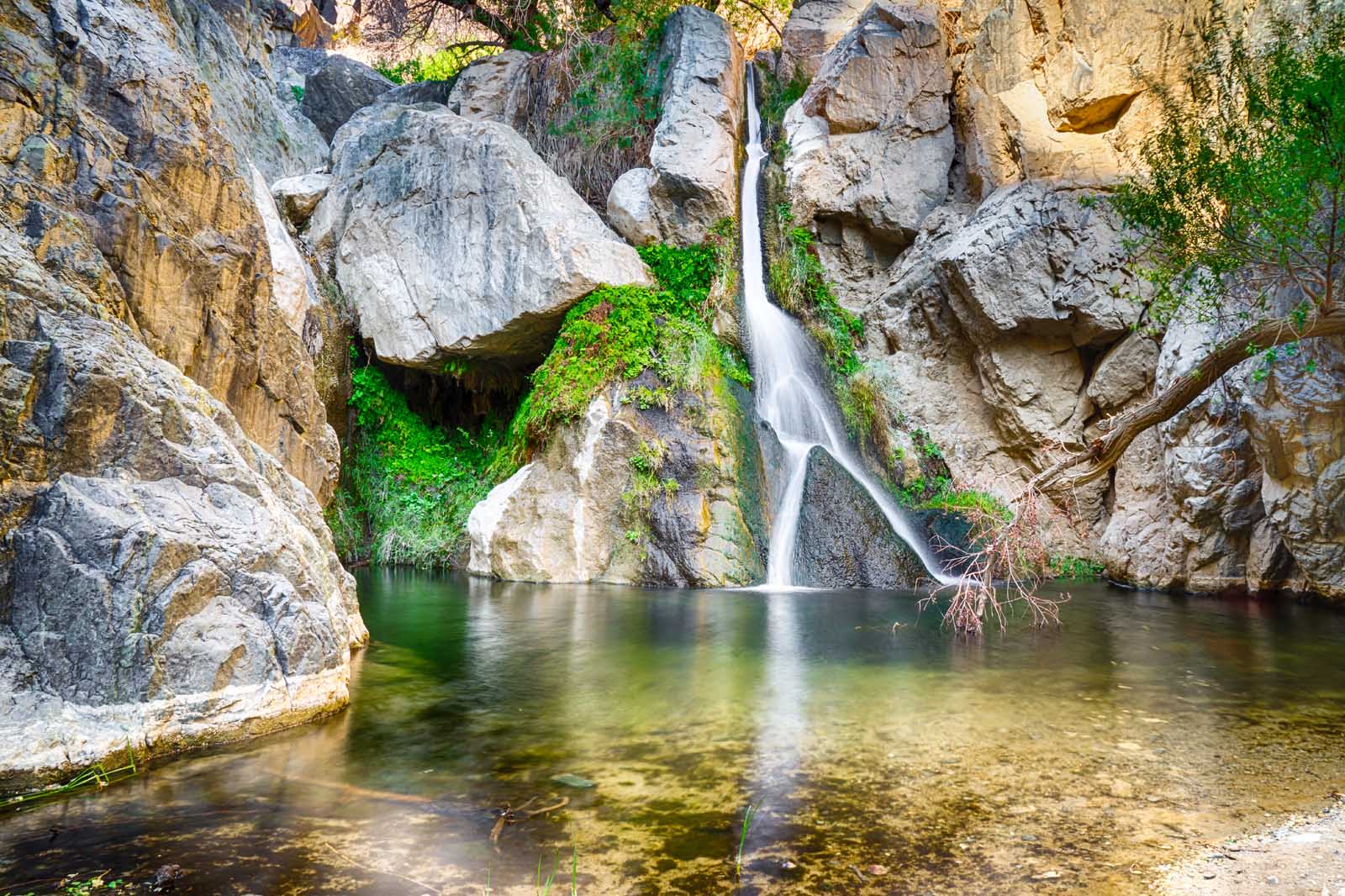
Waterfalls aren’t the most common sight in Death Valley. In fact, Darwin Falls is quite a rare year-round waterfall, as there is only a handful in the national park. The falls are surrounded by life – from flora, including aquatic vegetation, to animals like tree frogs and even bighorn sheep. Darwin Falls is somewhat of a desert oasis, and lifeforms flock to the waters for survival.
Darwin Falls is a stunning sight, and the waterfall drops 18 feet in a pretty cascade. Darwin Falls is accessed by a two-mile round trip hike, which takes around two hours to complete and has an elevation gain of 450 feet. The general advice is to avoid hiking after 10 am in hotter months. You can’t swim to cool off, so aim to hike in the early morning when it is nice and cool.
The trailhead is located off of Old Toll Road on a long dirt track, and there is a large parking lot to use right next to the beginning of the trail. It is worth noting that the track is pretty rough and requires a 4WD vehicle. You may wish to check with a ranger or website for updates on the road conditions.
11. Rhyolite Ghost Town
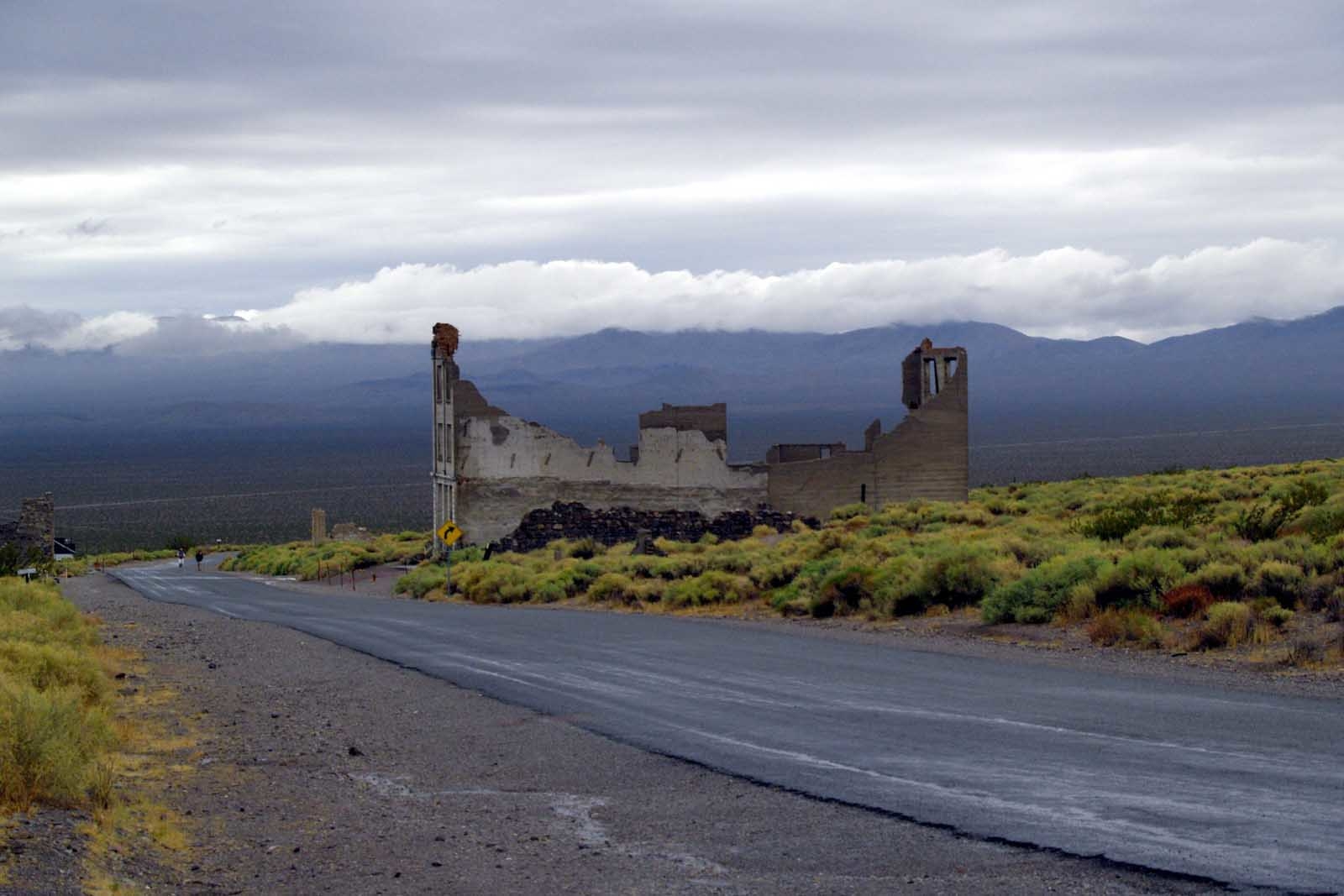
Rhyolite Ghost Town is located just on the outskirts of Death Valley, on the eastern side of the park across the Nevada border. Rhyolite is an old, abandoned mining town, and light and power were turned off for the town in 1916 following the closures of mines and banks. However, nowadays, there is still so much left behind to explore.
The old bank is (just about) still standing, as is the train depot and Tom Kelly’s Bottle House. It is also worth stopping by Goldwell Open Air Museum for an outdoor sculpture garden. Rhyolite is the perfect spot for those interested in history and visiting abandoned sites.
Rhyolite Ghost Town is quite a drive, just over an hour from Furnace Creek. We suggest breaking the drive up by stopping at Hell’s Gate on the way. Hells Gate is a scenic stop to admire Daylight Pass Road’s stunning surroundings and visit the Death Valley National Park Information Area.
12. Eureka Dunes
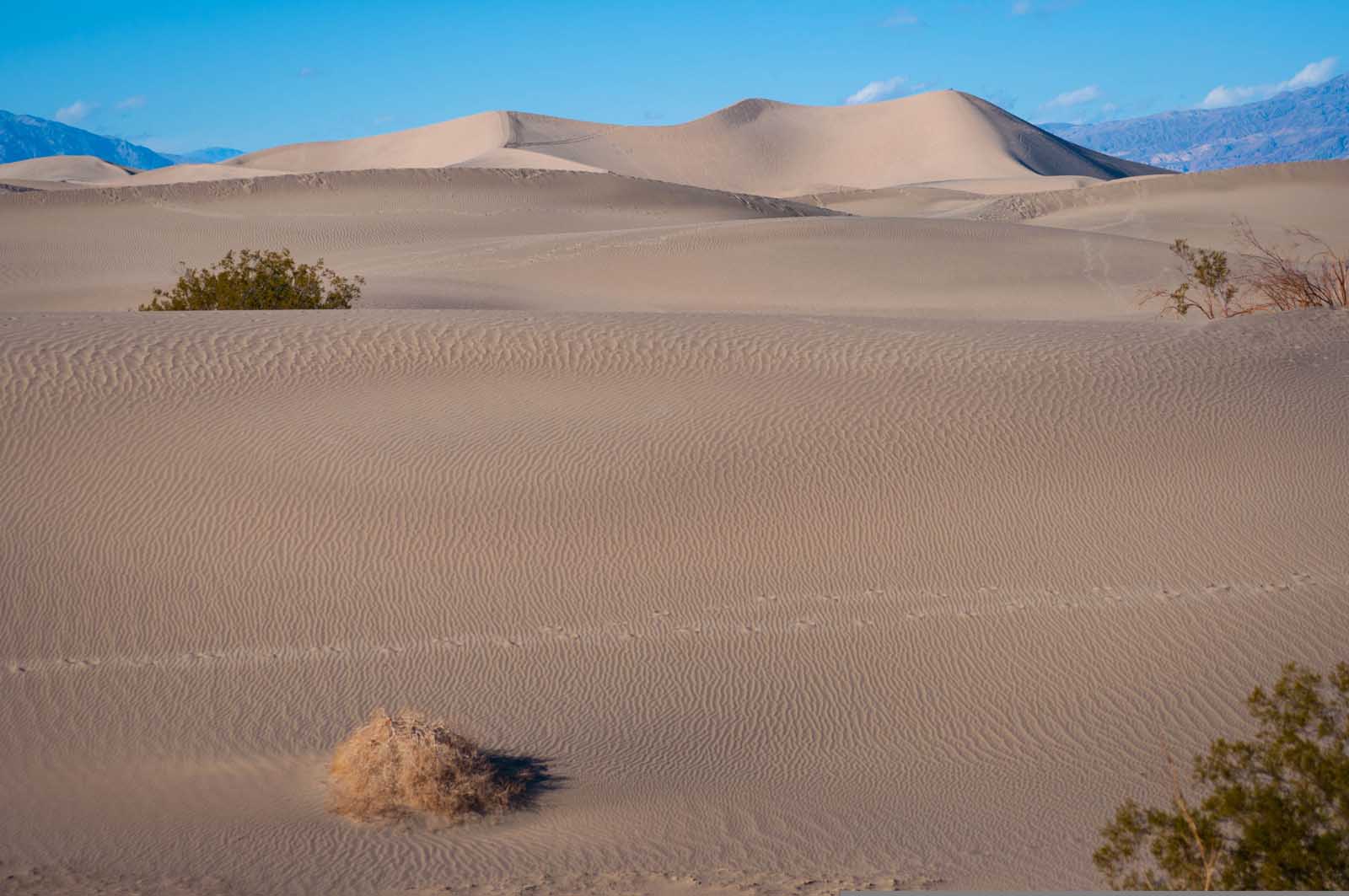
Eureka Dunes are a great attraction for your itinerary. In short, the dunes are massive. They are the largest in California, and some controversially claim they are the tallest in North America. Some dunes rise over 680 feet – don’t be getting ideas about sandboarding, though. Eureka Dunes are closed to sandboarding, sand skiing, and sledding to protect sensitive flora. And who can blame the National Park Service? Eureka Dunes are one of the most impressive natural attractions in the US.
Even though you can’t enjoy sand sports, you can still hike the dunes. Listen carefully while you do, as you may hear the ‘singing sand’. Something about the sand grains moving together creates a beautiful sound, which sounds like an organ bass note. Keep your eyes peeled for desert flora, too, as the dunes are covered in plant life like Eureka Dunes Evening Primrose and Shining Milkvetch.
13. Saline Valley Dunes
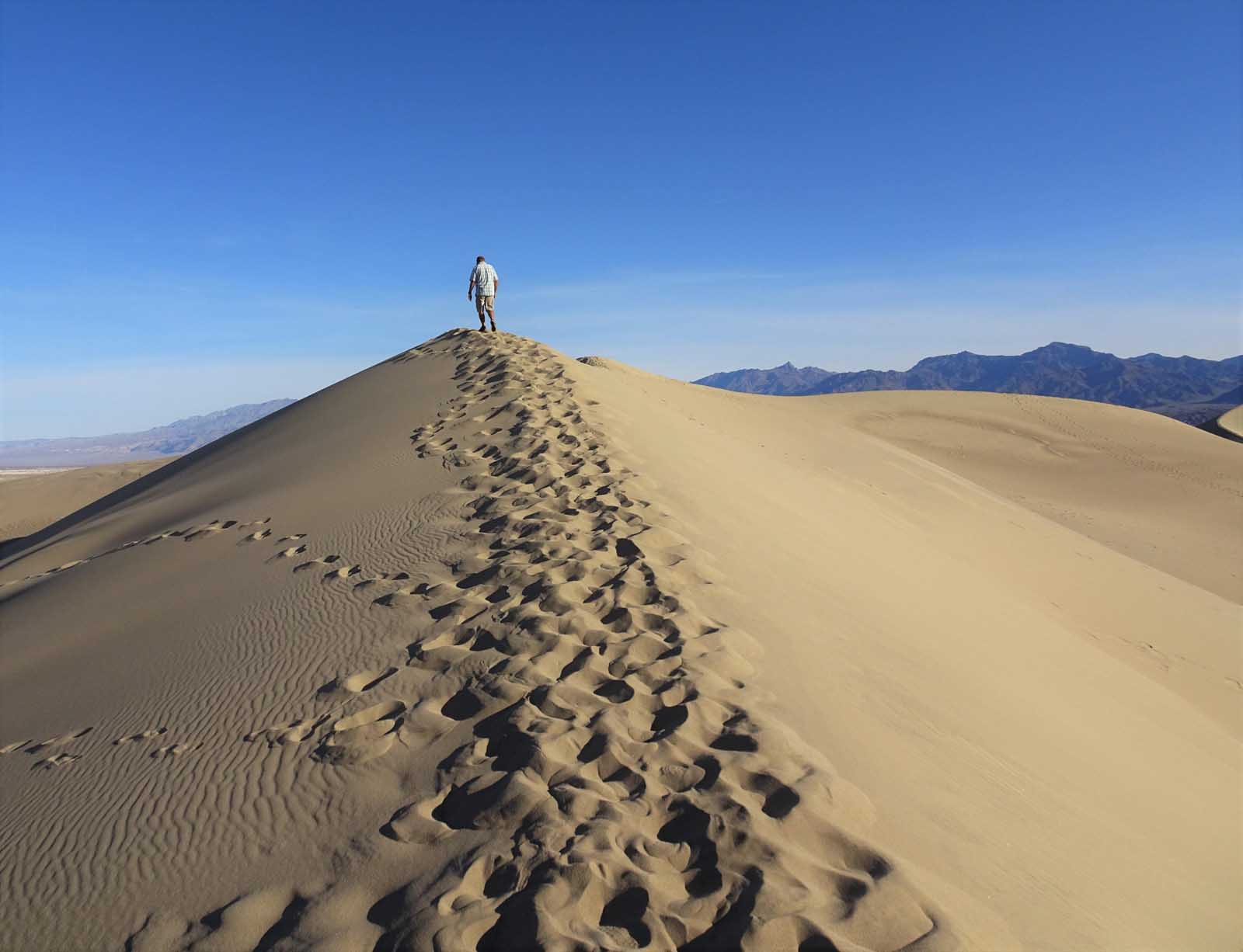
Visiting Saline Valley Dunes is one of the lesser-known things to do in Death Valley National Park. These sand dunes are much lower than the others in Death Valley, and although sandboarding is permitted, the dunes are also much more suited to hiking.
Death Valley’s sand dunes cause quite the stir, despite only covering 1% of the national park. Saline Valley Dunes and Mesquite Flat Sand Dunes are the only dunes that allow activities like sandboarding. Choose one of these sand dunes if you want to try sand sports . Saline Valley is ideal for those who want to get further off the beaten track and prefer attractions with fewer crowds. The dunes have the stunning 10,000 feet high Inyo Mountains as a scenic backdrop.
Getting to the dunes requires a fun, but demanding drive down a rough road, often inaccessible due to flash floods and snow. The road is located off Saline Valley Road and requires a vehicle with high clearance and 4WD. The adventure begins before you even reach the parking lot.
14. Telescope Peak
We have covered the lowest point in Death Valley (Badwater Basin), but what about the highest point? Well, that would be Telescope Peak. Telescope Peak is the tallest mountain in Death Valley and the perfect challenge for hiking and climbing enthusiasts.
Hiking the mountain is no mean feat, and you’ll tackle 3,000 feet of elevation in a 14-mile, 7-hour round trip. The trailhead is located at Mahogany Flat Campground, and reaching it is an adventurous mission. You need a 4WD to access the campground and parking area, and you’ll get a taste of rough (almost off-road) track driving before you even begin your hike. We recommend staying at Mahogany Flat Campground the night before and after your walk to maximize your daylight and energy levels.
While technically a single-day hike, we recommend setting aside at least one evening to camp overnight at the campground. Still, Telescope Peak is easily added to your itinerary. It is also right next to the Wildrose Charcoal Kilns – a brilliant attraction to combine with your hike.
15. Harmony Borax Works
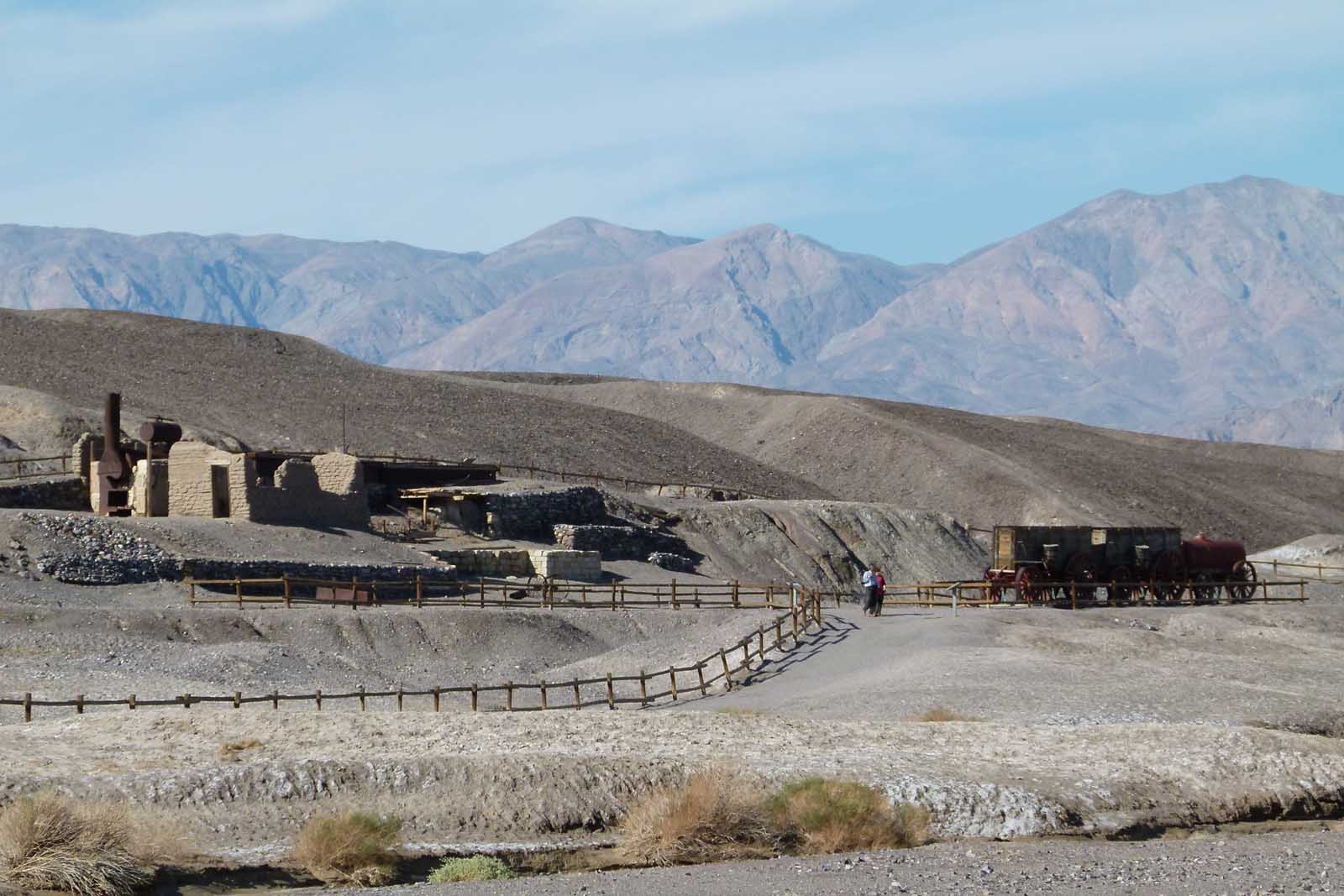
Have you heard of the Harmony Borax Works before? The borax plant was once a thriving business, with 40 employed workers and three tons of borax produced daily. The company was located in Furnace Creek and massively contributed to the town’s popularity and growth in the late 19th century. Nowadays, you can walk around the site on a paved 0.4-mile loop – stopping to read informative panels and view displays along the way.
Visiting Harmony Borax Works is one of the most historical things to do in Death Valley National Park. And while the site is small, it is officially held on the National Register of Historical Places and is a well-known tourist attraction. The wagons from Harmony Borax Works coined the name ’20 mule teams’ because they used large groups of mules to transport all the borax. You may recognize the phrase from Twenty Mule Team Canyon.
16. Manzanar National Historic Site
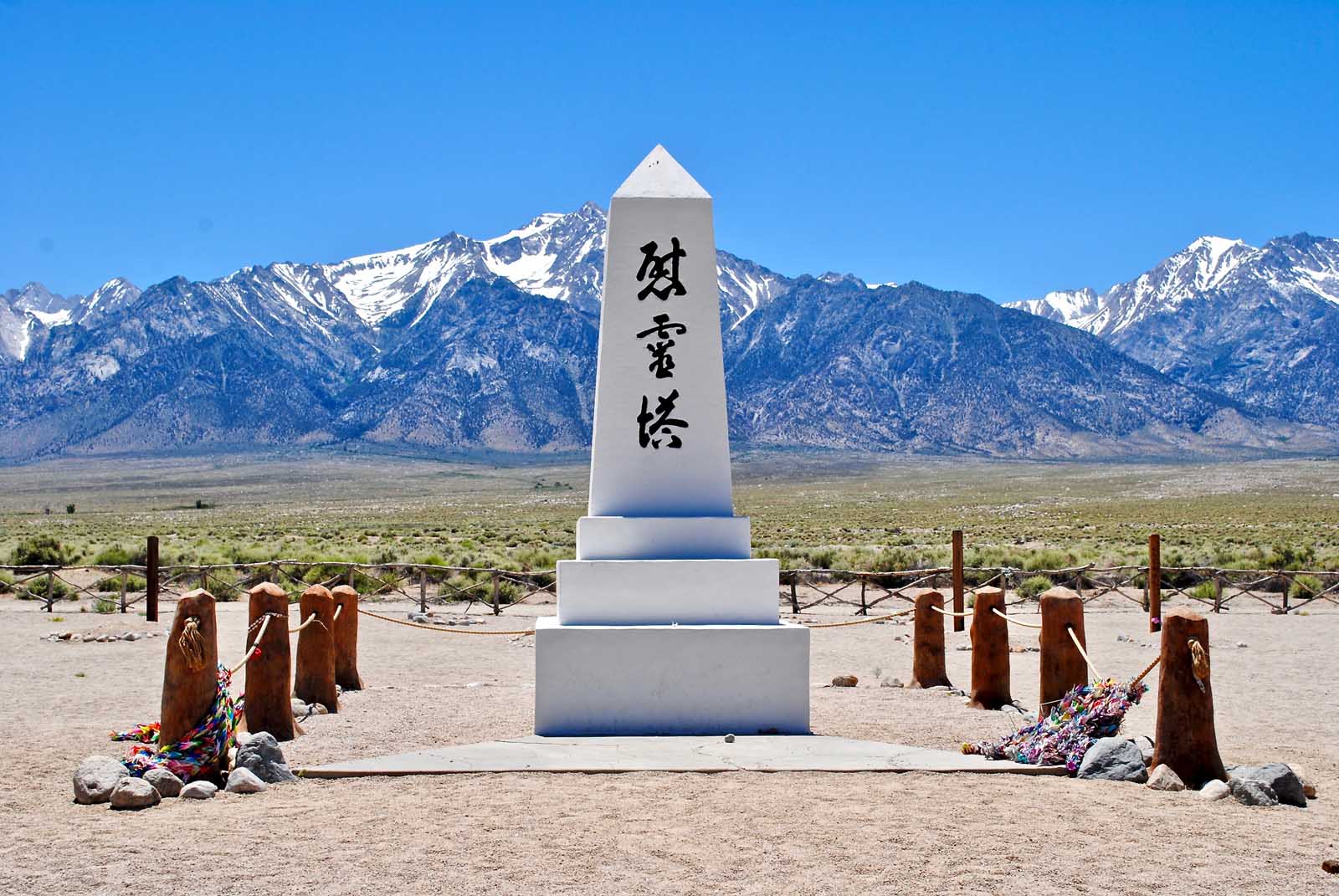
Manzanar is another incredible attraction located just outside the national park boundaries. If you are staying on the outskirts or taking a California road trip , it is well worth stopping by Manzanar. The site was one of ten sites where Japanese Americans were incarcerated during World War II. It is a fascinating, often harrowing place to discover a part of history that isn’t as widely covered.
You can visit anytime between sunrise and sunset, perhaps booking a guided tour if you want a more informative, interactive experience. If you were planning on climbing Mt Inyo, the site is also en route to the trailhead, so don’t rule out Manzanar straight away based on distance.
17. Mosaic Canyon
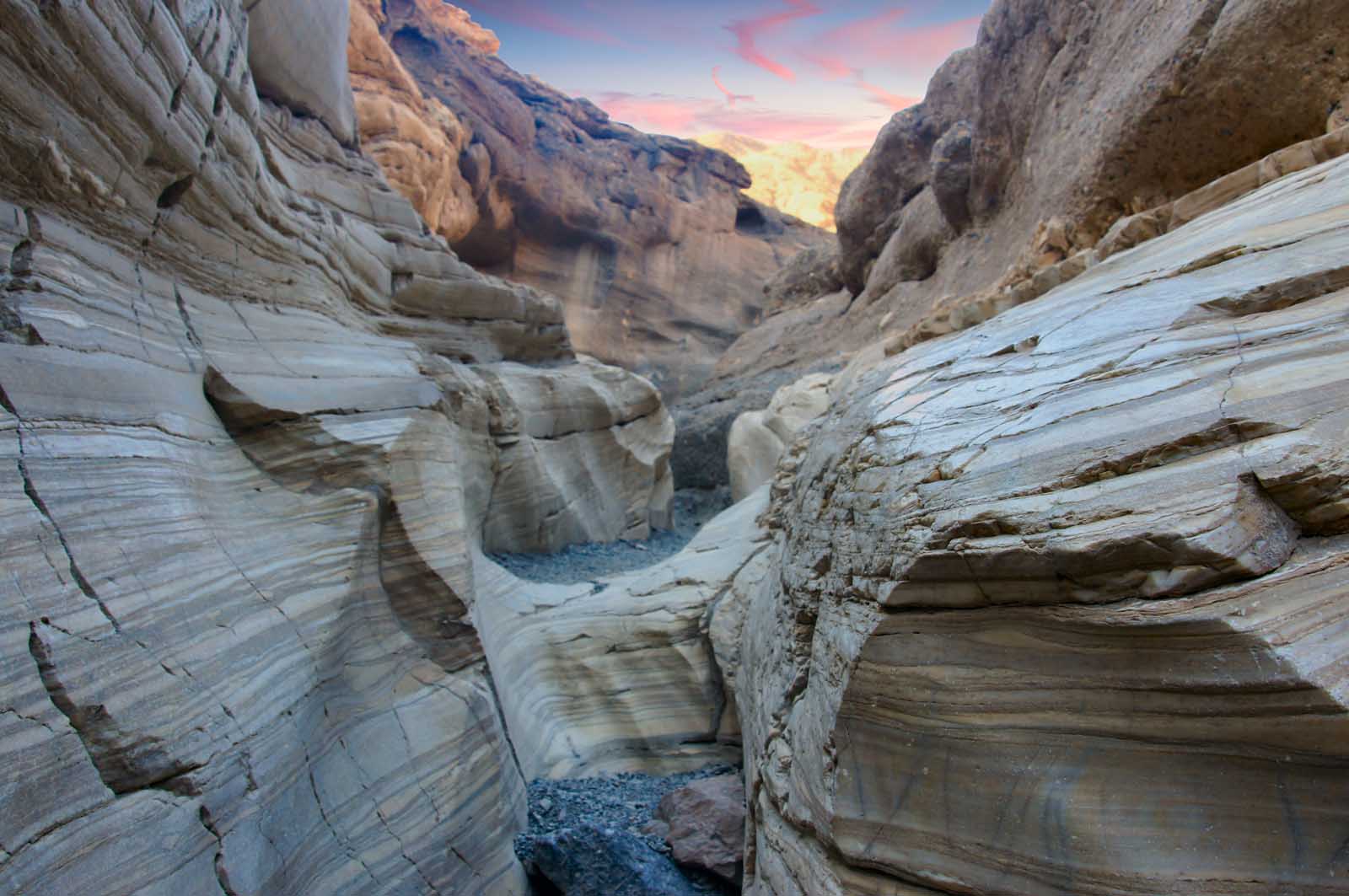
Ready for another beautiful canyon? Mosiac Canyon is a deep ravine formed by flash floods over millions of years. It gets its name from its unique walls, where flood waters full of grit have polished the marble walls, and tiny fragments have become locked in natural cement.
The route is by no means easy. It is rated as a moderate to difficult hike and requires a lot of boulder scrambling and an adventurous spirit to pass certain sections. However, where there is a will, there is a way, and you’ll just need a decent fitness level and good shoes to complete this trail. The trail is around 4 miles out and back; you should allow three hours to complete it.
18. Wildrose Charcoal Kilns
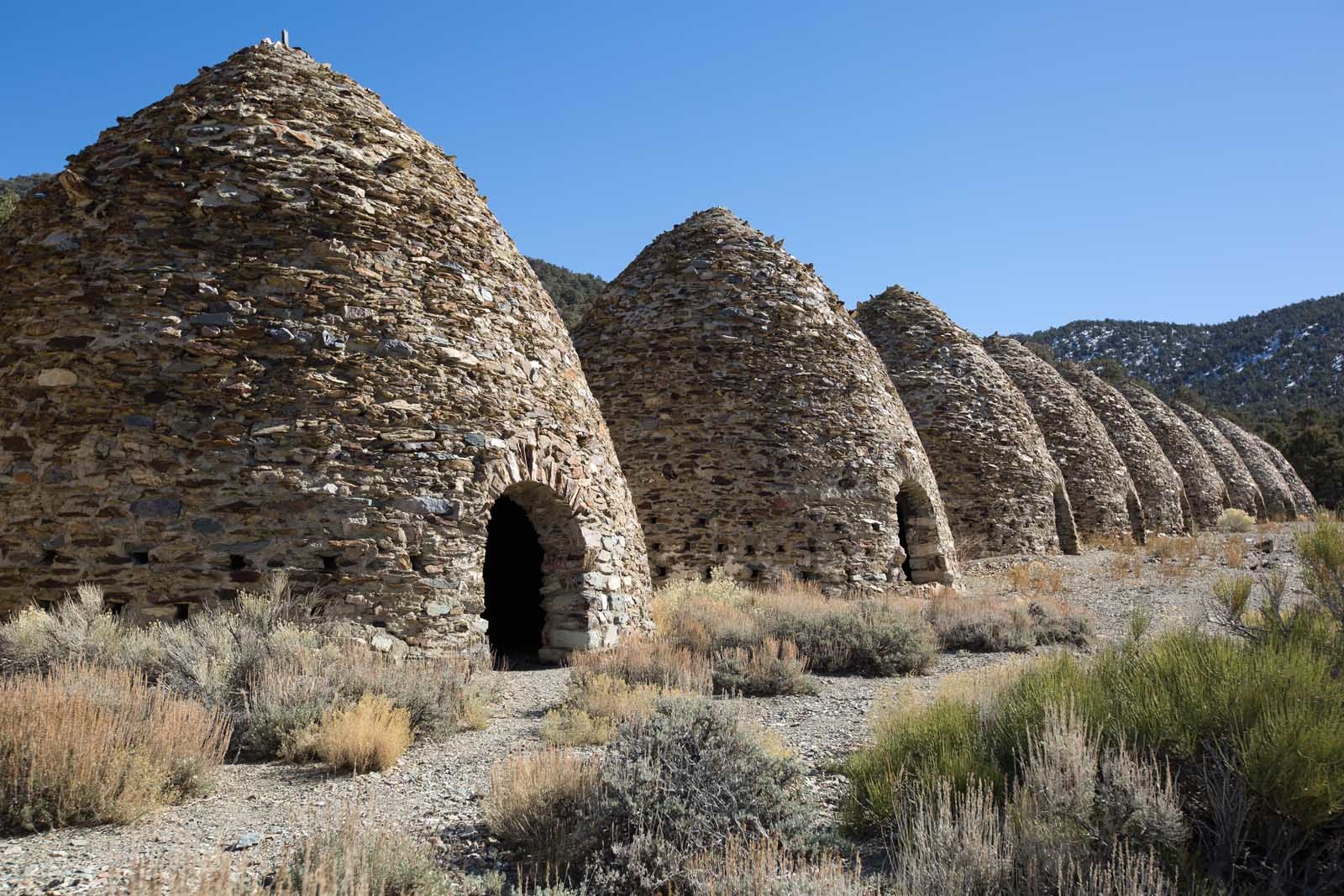
Do you remember us mentioning that Wildrose Charcoal Kilns were near Telescope Peak? Well, the kilns are attractions in their own right. The kilns look like bizarrely shaped houses and have a large hole at the front where you can enter inside. They were built in 1877 to create charcoal for local mines, but they have long since been retired. Now, Wildrose Charcoal Kilns are empty – apart from when a tourist like yourself stops to poke their head in and take a look.
There are ten kilns, all structured in a single line and about 25 feet high. The kilns are in excellent condition, which makes them fantastic for tourists and has kept them firmly marked as worthy attractions in Death Valley. If you’d like to learn more about the early mining industry, Wildrose Charcoal Kilns are a great way to do so.
19. Ubehebe Crater
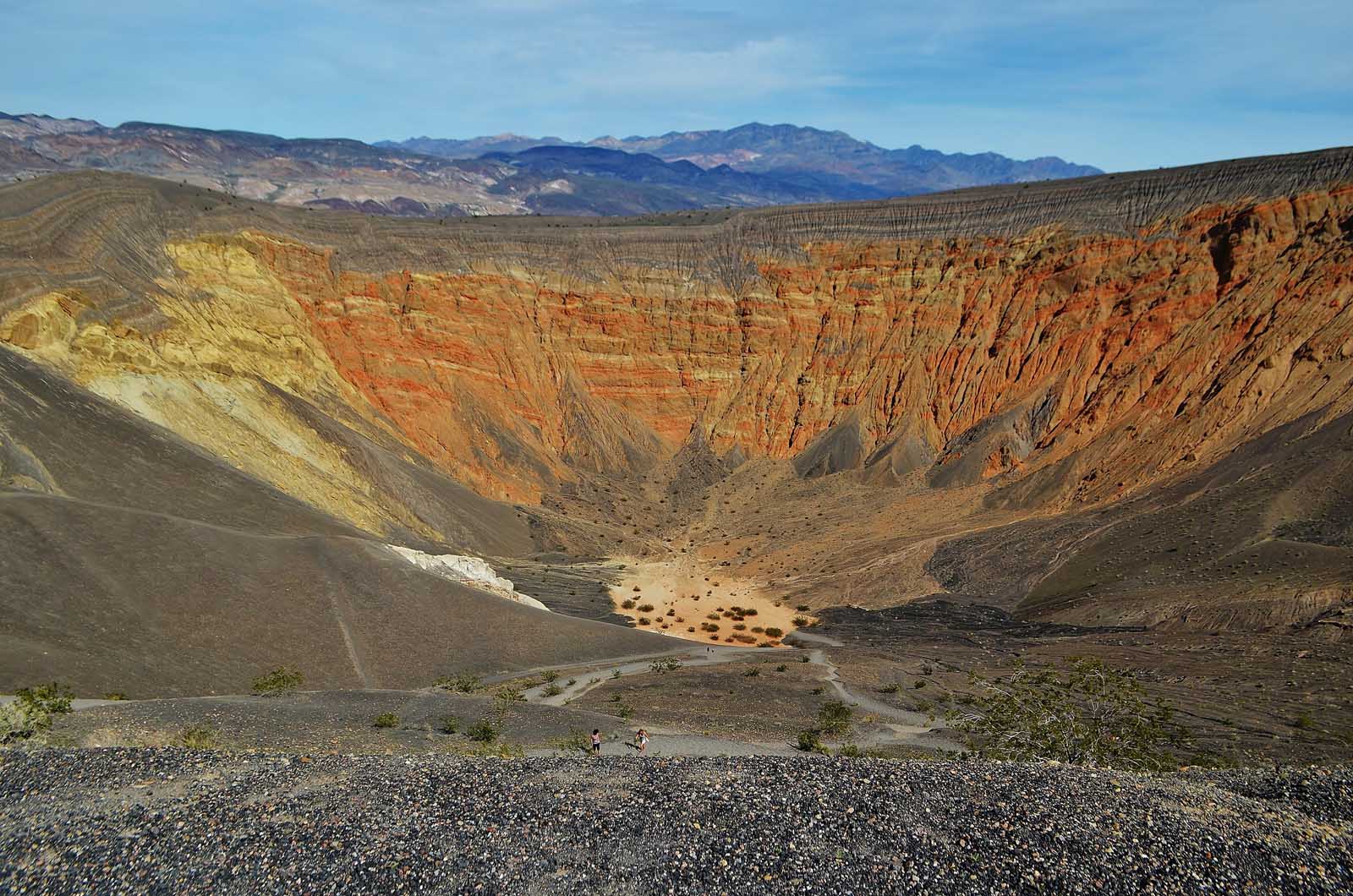
Ubehebe Crater should be at the top of your to-do list if you’ve never seen a volcanic crater. Ubehebe Crater is enormous. It is quite the sight, 600 feet deep and half a mile wide. Ubehebe Crater is still an ashy, dark gray color, which adds to the dramatic appeal.
If you want, you can hike down to the bottom of the main crater. However, you should remember that hiking back up is exhausting and highly strenuous. Walking around the crater rim is a lot easier. However, it is still classed as a moderate hike because of the uneven footing. Take your time on the Ubehebe Crater Rim Trail, and plan lots of breaks to prevent slipping and injury. The 2-mile loop may not be long, but it pays to take your time – plus, you’ll have stunning views while you rest.
20. Racetrack Playa
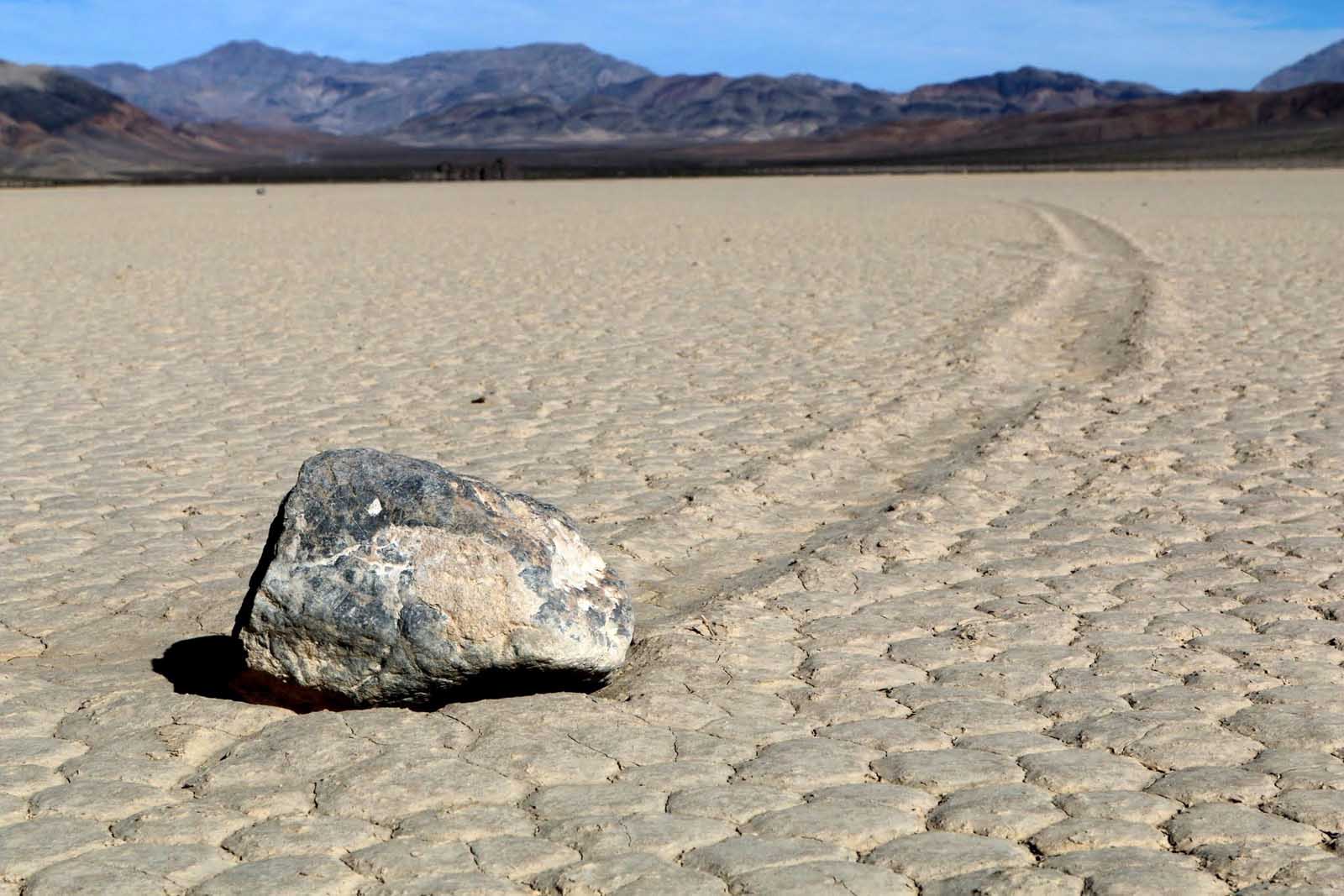
Have you ever wished that you could walk on the moon? If so, Racetrack Playa is one of the best things to do in Death Valley National Park. The dry lake is a scene from the moon landing and is a dramatic, lunar-like landscape to explore and get fantastic pictures of.
Racetrack Playa gets its name from its sailing stones, which are enormous rocks moved by a combination of rain, making the ground slippery and wind pushing the rocks along. The tracks that the sailing stones leave look like race tracks – giving Racetrack Playa its name. It is widely believed that nobody has ever seen the rocks moving, but who knows? Maybe you’ll get lucky.
21. Dante’s View
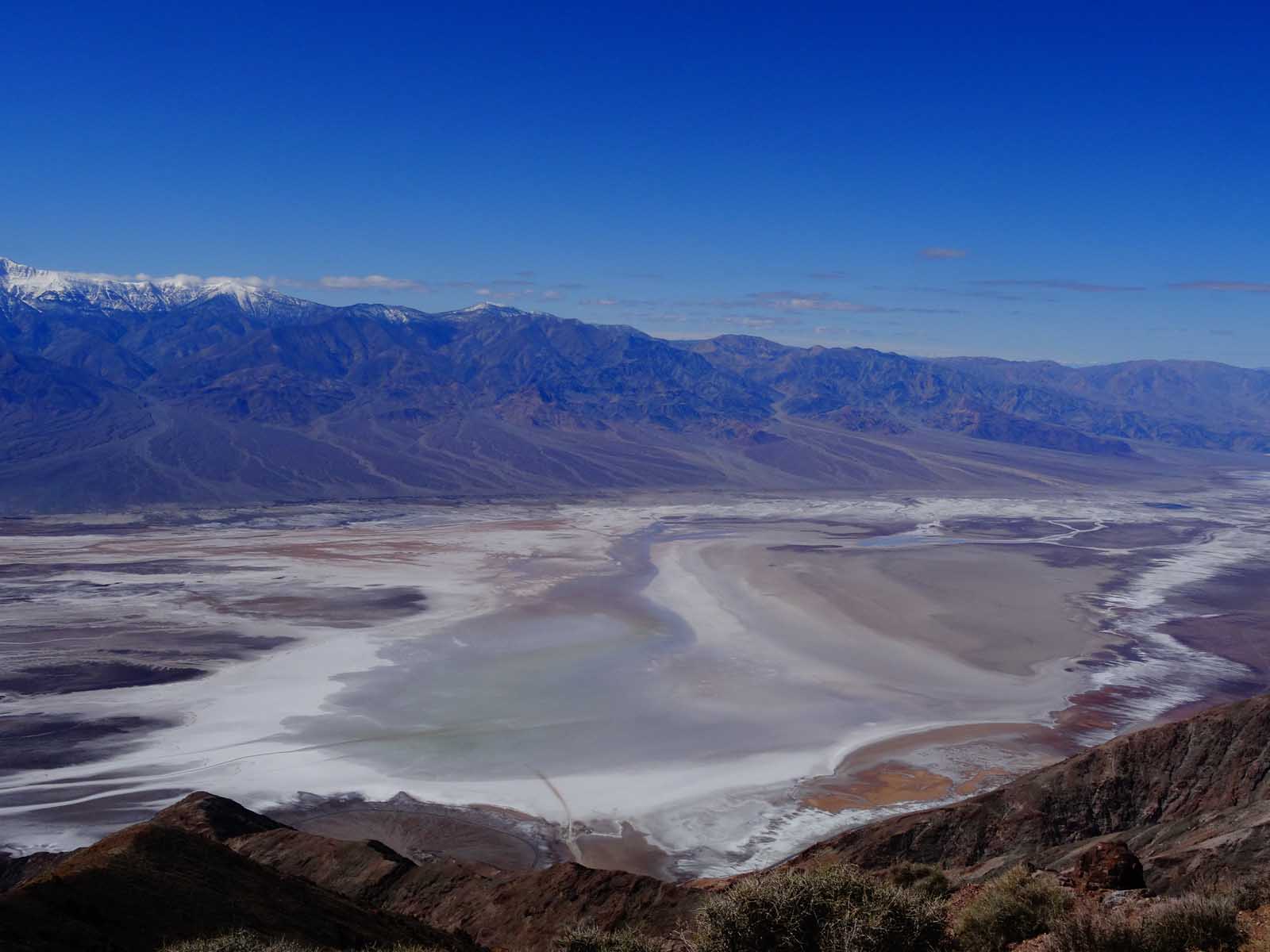
Dante’s View is a scenic viewpoint that towers 5,575 feet above Badwater Basin and sits on a ridge of the Black Mountains. Surrounded by mountains and perfectly fanned by the light breeze, you can enjoy spectacular views over the landscape and dramatic salt flats below. Visiting Dante’s View is about enjoying a different perspective, and viewing Badwater Basin from above is truly humbling.
Dante’s View is popular at all times of the day. Sunrise and sunset are understandably sought-after times, and the salt flats look stunning illuminated by first and last light. However, you can also visit at night for incredible night sky views. In case you didn’t know, Death Valley is an International Dark Sky Park famous for its stunning night sky. Head to Dante’s View after a busy day of sightseeing to relax and unwind under bright constellations and shooting stars.
Death Valley FAQs
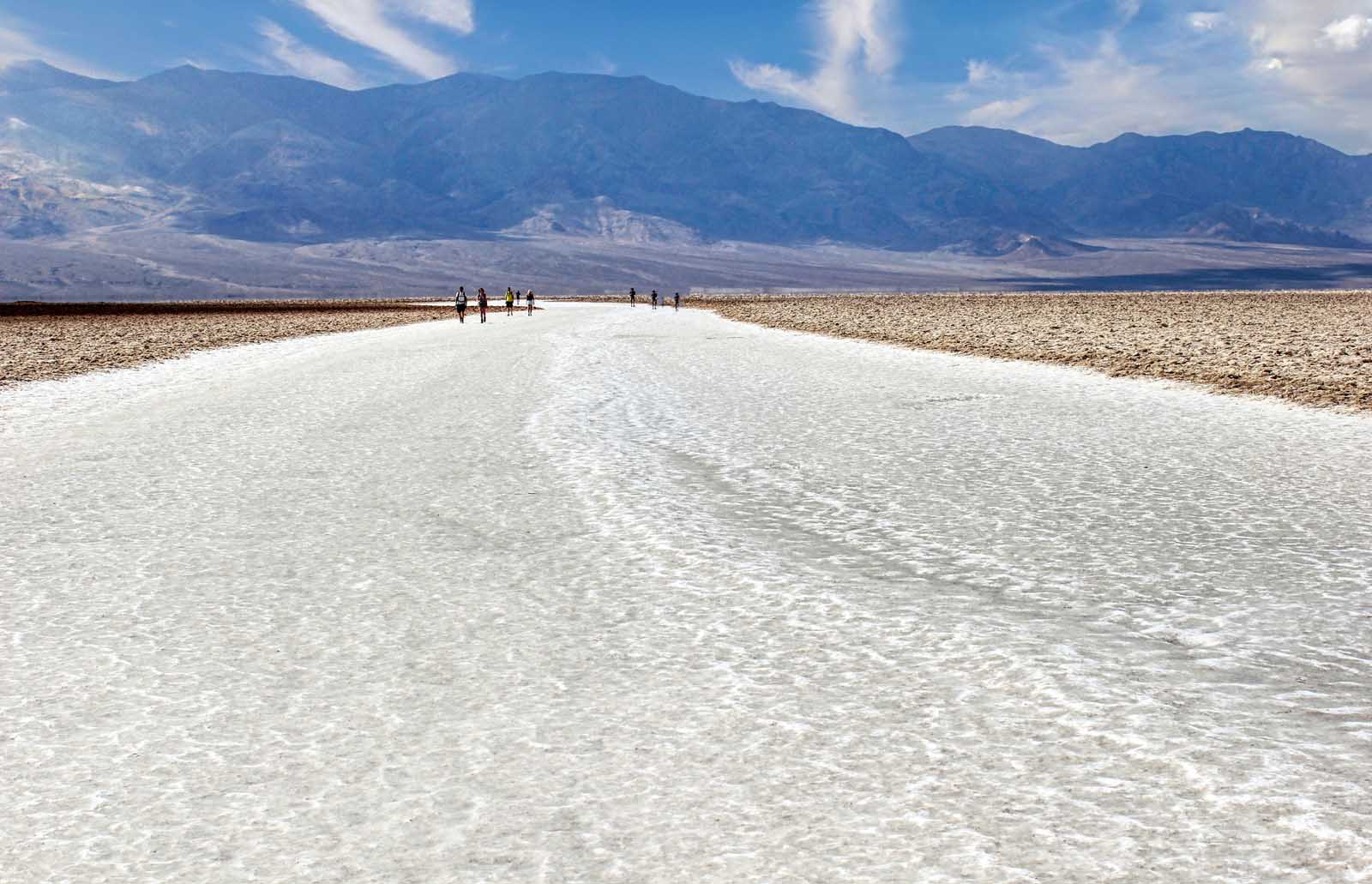
Now that we’ve covered all the best things to do in Death Valley National Park let’s look at some essential information. These are the most common Death Valley FAQs; let’s dive straight in.
How to get to Death Valley
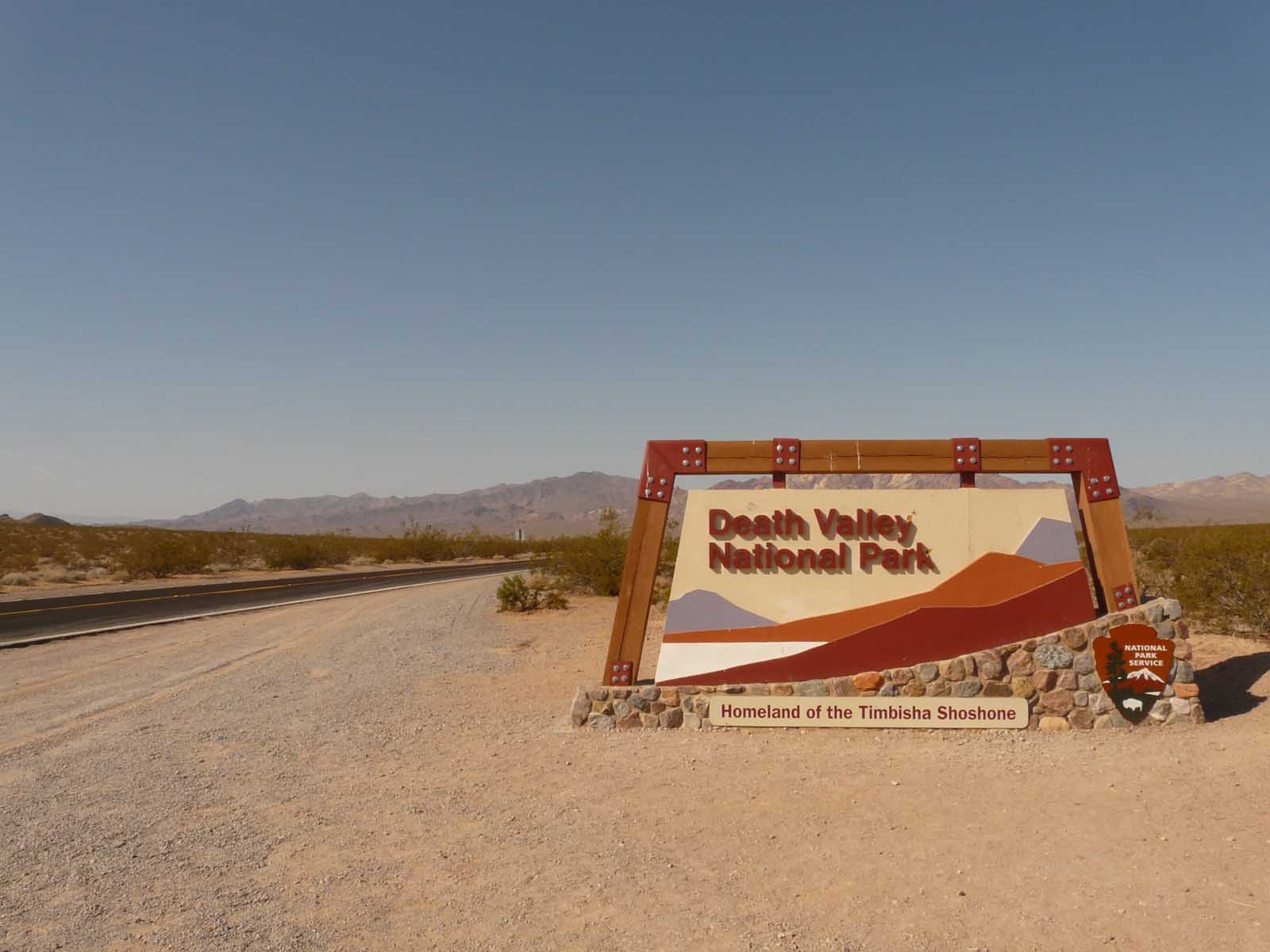
First off, let’s establish Death Valley’s location. The national park straddles the California/Nevada border, although most of the park falls in California.
Because of Death Valley’s inland location, the easiest way to reach the national park is to fly into Las Vegas. Those wanting the quickest way to Death Valley should fly into Las Vegas Airport, hire a car to drive to Death Valley, or book a guided tour.
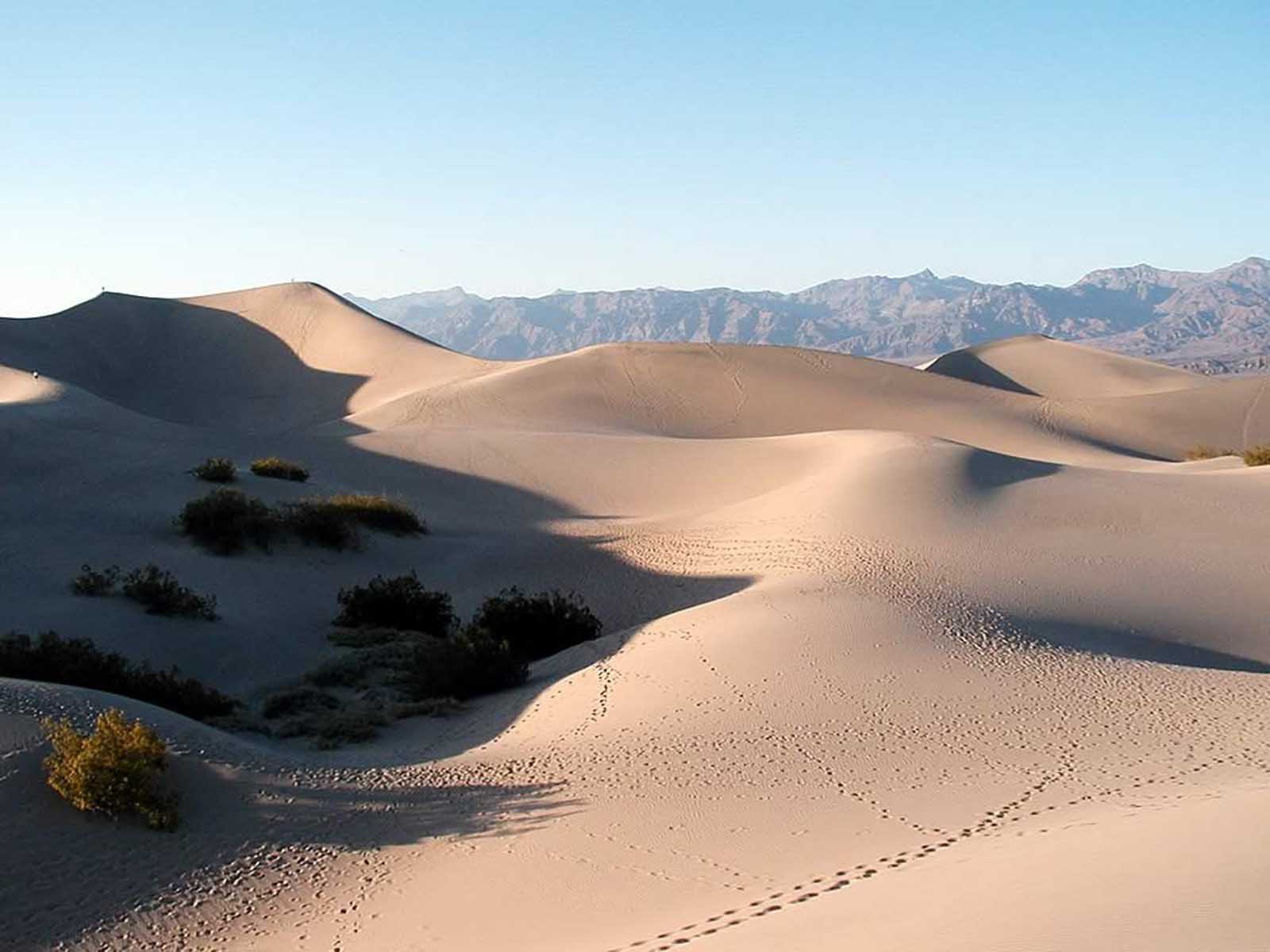
Of course, if you aren’t on a time limit, you could get your adventure on and take a California road trip, perhaps exploring Northern California along the way. If you are really up for an adventure, you could extend your trip and finish in Las Vegas – where you can fly home. Death Valley is ideally located for a road trip; if you have the time, this is the most fun way to get to the national park.
Getting around Death Valley
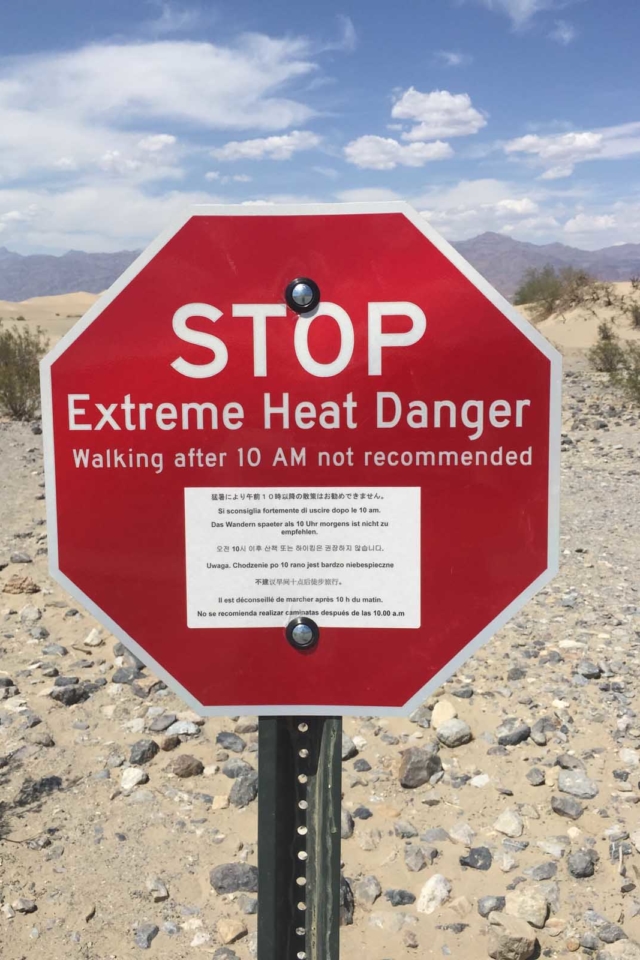
As the largest national park, Death Valley’s public transport system leaves much to be desired. You won’t find any public buses or shuttles, so your only option is to purchase a guided tour or rent a car to drive around.
Allow a day to get around Death Valley and see your top few attractions. And, if you don’t want to drive for so many hours in a single day, it is worth finding overnight accommodation to maximize your experience.
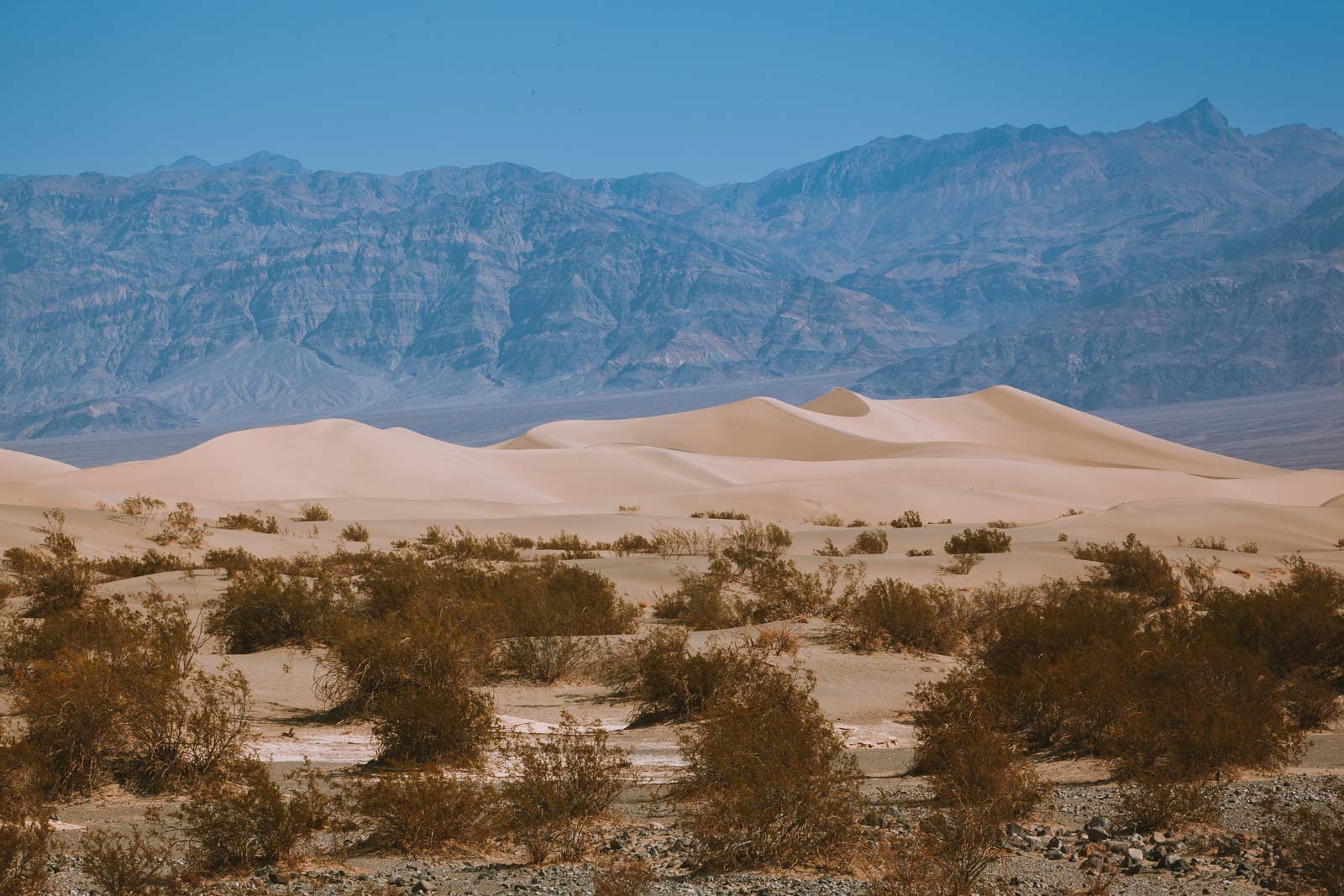
Before you set off driving or on your tour, it is always worth checking for road closure and trail updates in Death Valley online. The desert landscape might be beautiful, but you don’t want to drive the length of Daylight Pass Road before realizing you’ve got to turn around. Remember that gas stations are also limited in Death Valley. If you pass Furnace Creek, top up at the Furnace Creek Gas Station – one of the most centrally located options and accessible gas stations to combine with sightseeing.
Where to stay in Death Valley
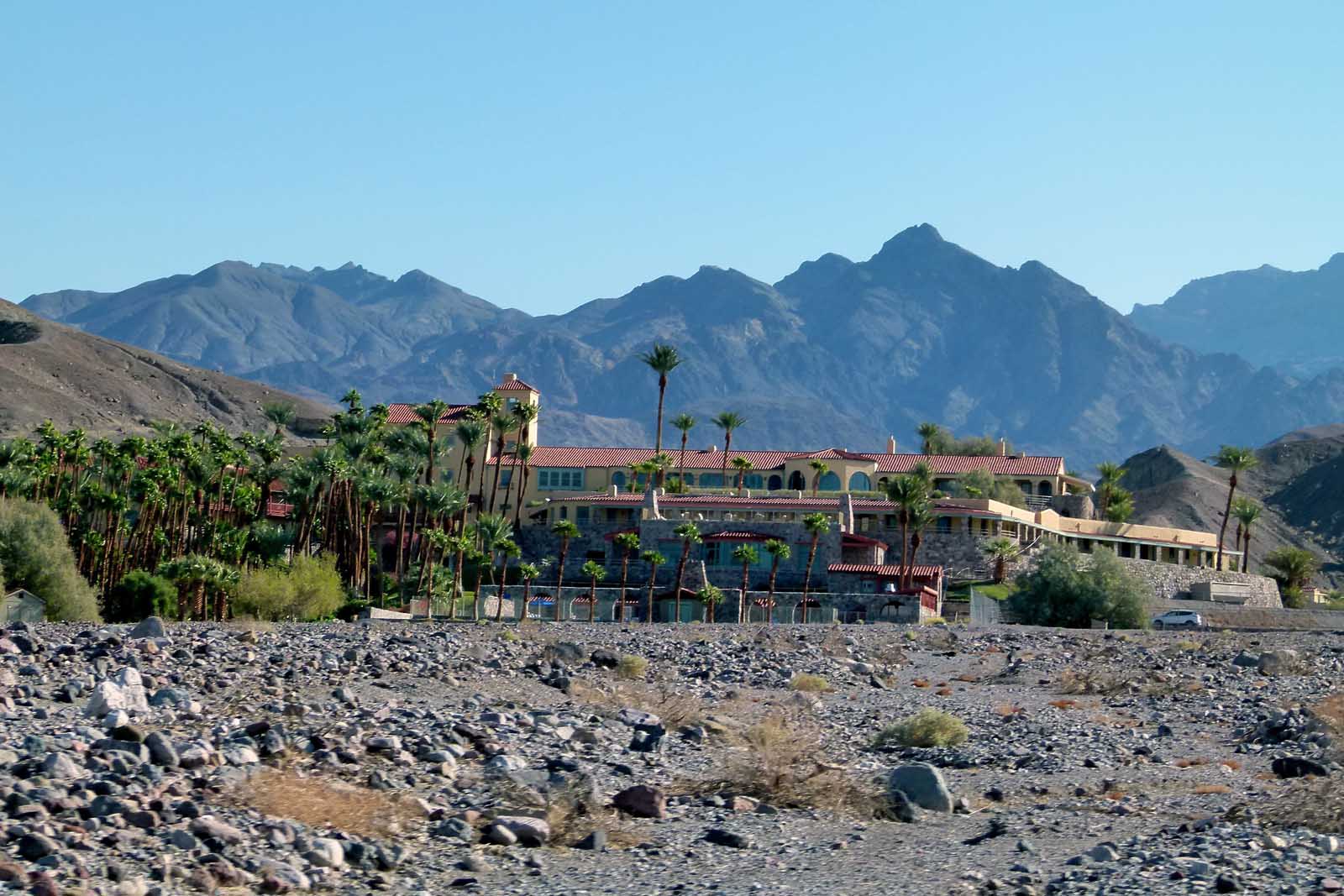
So, where should you stay in Death Valley? These are our top recommendations that you could choose from.
Budget: Panamint Springs Resort
Panamint Springs Resort is a budget traveler’s ideal spot in Death Valley. The resort is family-run and offers an impressively flexible range of accommodation choices, including a campsite, a selection of cabins, and standard hotel rooms.
The resort has its own gas station, general store, and shower facilities for campers. Plus, there is a breakfast buffet served daily. It is the perfect place to base yourself if you want budget-friendly accommodation within the boundaries of Death Valley National Park.
Mid-Range: Delight’s Hot Springs Resort
Delight’s Hot Springs Resort sits just outside Death Valley and is the perfect base for easy access to the national park. The resort has four spring water swimming pools – two indoor and two outdoor to which guests have 24-hour access. There is also a free parking area and a 24-hour reception desk.
Delight’s Hot Springs Resort has a perfect balance of affordable luxury, attentive hospitality, and a convenient location.
Luxury: The Inn at Death Valley
The Inn at Death Valley might be listed as a three-star property but don’t be fooled; this is the best luxury option in the national park. The location is dreamy, and you’ll be in the center of Death Valley, just outside Furnace Creek. The property offers a range of rooms, suites, and a bungalow, so you can always splash out for a bit of extra luxury.
Guests receive access to a sauna, a fully equipped gym, two spring-fed pools, a golf course, and tennis courts. Death Valley isn’t known for its urban amenities, so having a hotel with plenty of recreational activities is a huge bonus.
The best time to visit Death Valley
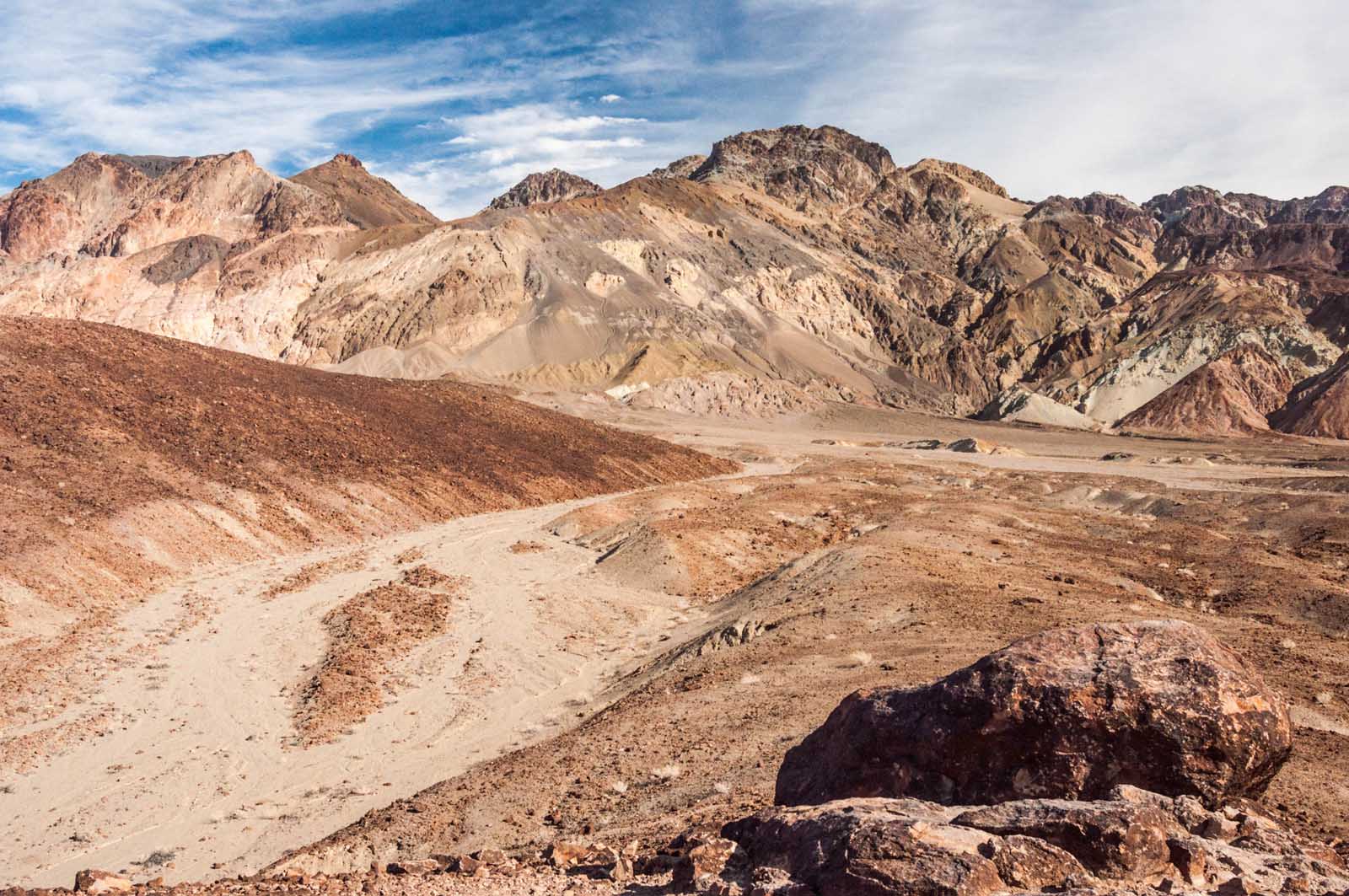
Death Valley makes a great destination in early spring. The temperatures are cool, the wildflowers are out, and it is the best time to comfortably enjoy all the things to do in Death Valley National Park. It can get a little busy, as this is the most popular time to visit Death Valley, but it is worth the crowds for the beautiful conditions. Late March and April are the best months in spring.
October is your month if you have your heart set on avoiding crowds. You won’t get the wildflowers. However, autumn brings cooler weather that is perfect for exploring the valley floor. Visiting Death Valley in October is a pleasant, quieter experience.
When should you avoid Death Valley? Well, it doesn’t take a genius to figure out that the summer is not the best time to visit Death Valley. In summer, the California desert is unhospitable and unpleasantly hot. Stick to visiting in March or April if you don’t mind the crowds and October or November if you don’t mind missing the spring bloom.
Final Thoughts
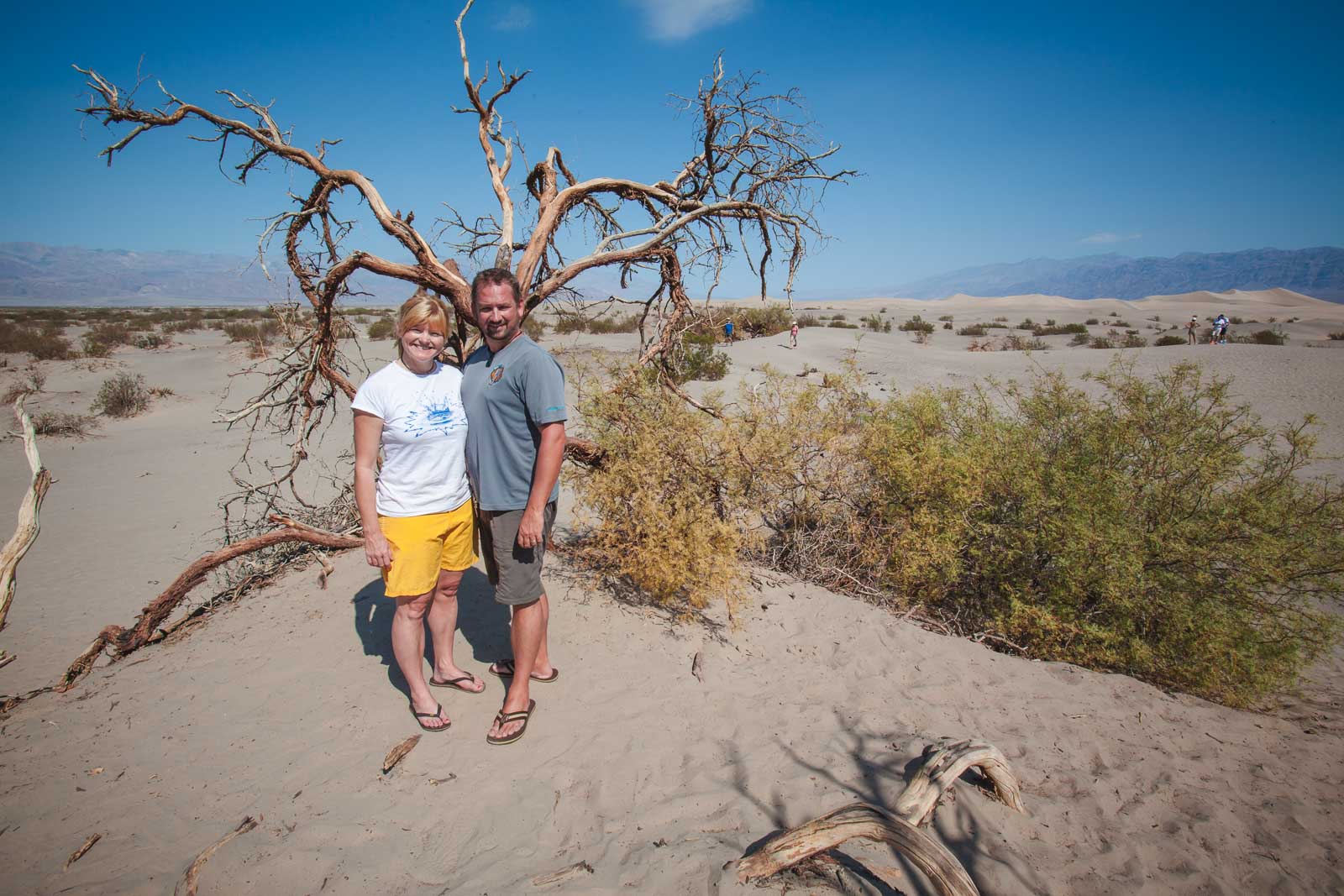
Once you’ve visited Death Valley, you should definitely return for a second visit. There are so many things to do in Death Valley National Park, and even visiting Death Valley in different seasons can drastically change your experience. The national park has some of the best hikes in California . It is also within driving distance of other fantastic national parks like Yosemite .
We hope you have a fantastic time in Death Valley. Take our advice and experience as many of its attractions as possible. These Death Valley ‘things to do’ are sure to guarantee you a memorable trip.
Plan Your Next Vacation to California With These Resources
- 25 Things to do in San Jose, California
- Where to Stay in Yosemite
- 16 Best Cities in California
- 24 Of The Best Beaches in California
- 15 Best Hikes in California – Inspiration to Get Outdoors
- 7 Epic Places to Visit in Northern California
- 20 Great Things to do in Monterey, California
- 25 Best Things to Do in Los Angeles – Hollywood, Hikes, And More
- 15 campgrounds in Big Sur, California
Travel Planning Resources
Looking to book your next trip? Why not use these resources that are tried and tested by yours truly.
Flights: Start planning your trip by finding the best flight deals on Skyscanner
Book your Hotel: Find the best prices on hotels with these two providers. If you are located in Europe use Booking.com and if you are anywhere else use TripAdvisor
Find Apartment Rentals: You will find the cheapest prices on apartment rentals with VRBO .
Travel Insurance: Don't leave home without it. Here is what we recommend:
- Allianz - Occasional Travelers.
- Medjet - Global air medical transport and travel security.
Need more help planning your trip? Make sure to check out our Resources Page where we highlight all the great companies that we trust when we are traveling.
You May Also Like
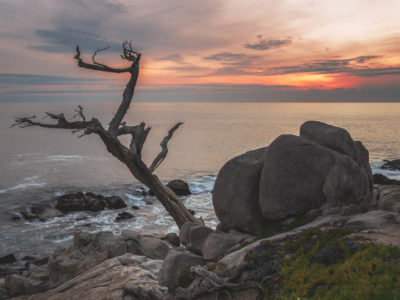
25 Best Weekend Getaways in The USA (2024)
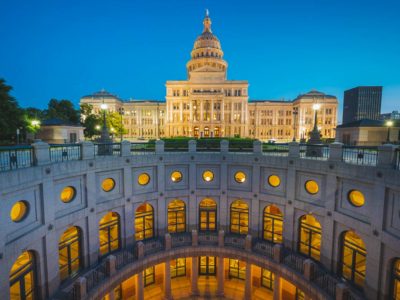
26 Best Things to Do in Texas We Recommend in 2024
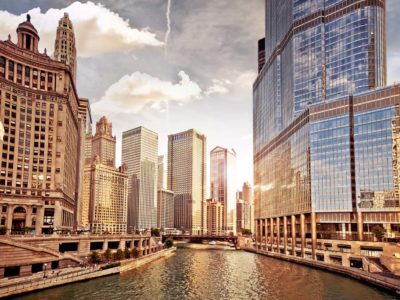
Where To Stay in Chicago (2024): 6 Best Areas For Every Budget
About ThePlanetD Team
Guest writers for The Planet D offer insider tips and information on destinations that they are experts in. We can't be everywhere at once, and it is important to have the highest level of travel information from local writers and experienced travelers.
Join thousands of others who get our monthly updates!
Leave a comment cancel reply.
Save my name, email, and website in this browser for the next time I comment.
Must-see attractions in Death Valley National Park
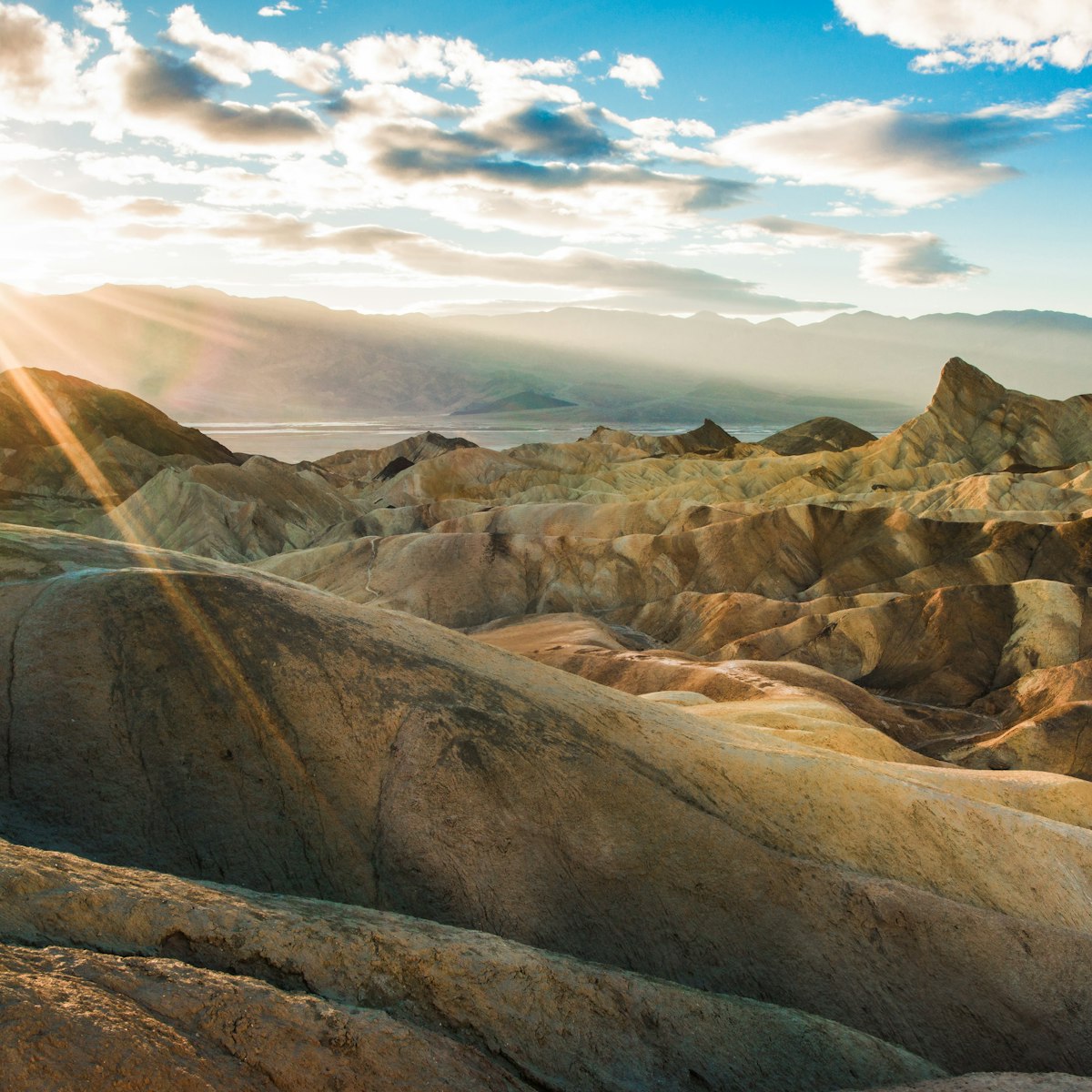
Zabriskie Point
Death Valley National Park
Not many national park features can say they were celebrated in a 1969 film of the same name, but Zabriskie Point claims that honor thanks to director…

Dante's View
Dante's View is an overlook that sits perched at 5475ft atop the Black Mountains, affording stunning panoramic views of the entire southern Death Valley…

Mesquite Flat Sand Dunes
The most accessible dunes in Death Valley are an undulating sea of sand rising up to 100ft high next to the highway near Stovepipe Wells Village. They're…
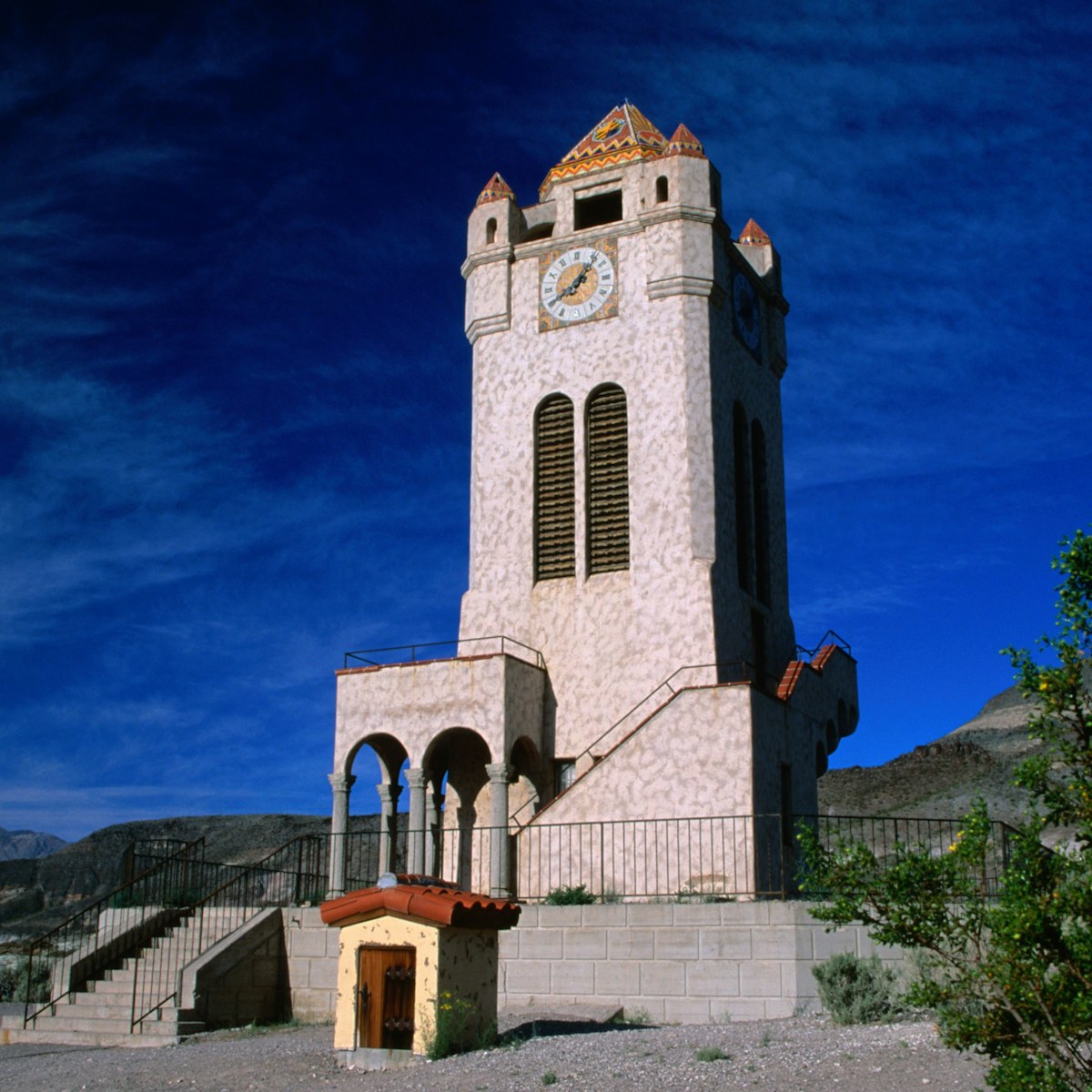
Scotty's Castle
Closed due to flood damage and not likely to reopen until at least 2020, this whimsical castle was the desert home of Walter E Scott, alias ‘Death Valley…
Aguereberry Point
Named for a lucky French miner who struck gold at the nearby Eureka Mine, Aguereberry Point sits at a lofty 6433ft above the desert floor and delivers…
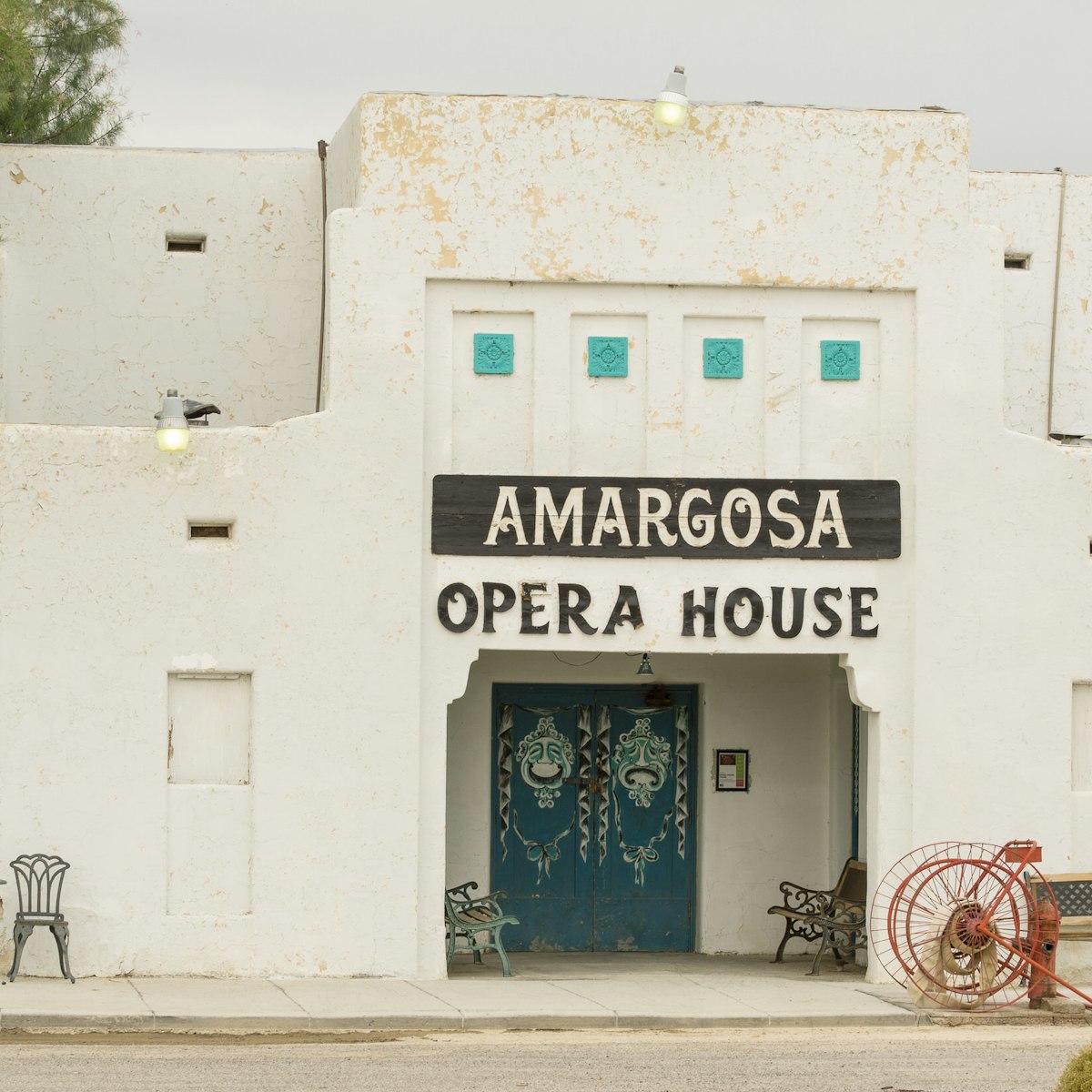
Amargosa Opera House
An opera house in the middle of nowhere? Yes, thanks to the vision of New York dancer Marta Beckett who fell in love with the 1920s colonnaded adobe…

Badwater Basin
The lowest point in North America (282ft below sea level) is an eerily beautiful landscape of crinkly salt flats. Here you can walk out on to a constantly…
Eureka Dunes
The far-northwestern reaches of Death Valley cradle these spectacular dunes that, at up to 680ft high, are the tallest in California. It’s a tough slog to…
Racetrack Playa
Past the northern end of Hwy 190, it's slow going for 27 miles on a tire-shredding dirt road (high-clearance and 4WD usually required) to the eerie…
China Ranch Date Farm
Fed by the mostly belowground Armagosa River and at the end of a narrow canyon, this family-run, organic date farm is a lush oasis in the middle of the…
Rhyolite Ghost Town
Just outside the Death Valley eastern park boundary (about 35 miles from Furnace Creek), Rhyolite epitomizes the hurly-burly, boom-and-bust story of…
Goldwell Open Air Museum
Near the ghost town of Rhyolite, just east of Death Valley National Park, this outdoor sculpture park was begun in 1984 by the late Belgian artist Albert…
Ubehebe Crater
Hwy 190 ends at 600ft-deep Ubehebe Crater, formed some 300 years ago by the meeting of fiery magma and cool groundwater. As the water turned into steam,…
Charcoal Kilns
Emigrant Canyon Rd climbs steeply over Emigrant Pass for the turnoff to Wildrose Canyon Rd and a lineup of 10 large beehive-shaped charcoal kilns made of…
Devil’s Golf Course
Some 15 miles south of Furnace Creek, salt has piled up into saw-toothed miniature mountains in what was once a major lake that evaporated about 2000…
Lower Vine Ranch
The house where gold-prospector Walter Scott (aka Scotty) actually lived can only be visited on ranger-led hikes that must be booked in advance via www…
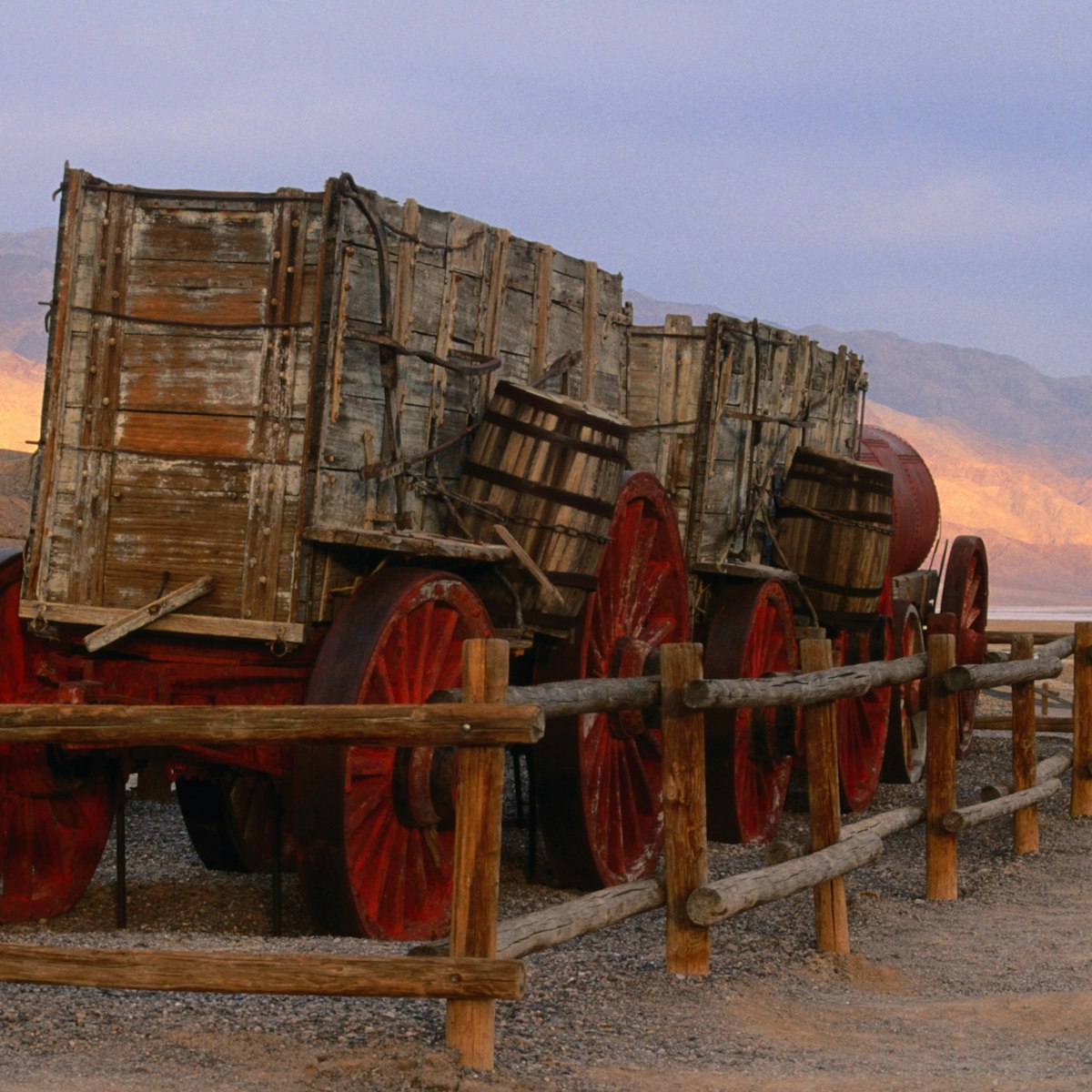
Borax Museum
On the grounds of the Ranch at Death Valley, this outdoor museum illustrates Death Valley's connection to borax mining, and presents pioneer-era mining…
Some 6 miles southwest of Stovepipe Wells, Emigrant Canyon Rd veers off Hwy 190 and travels south to the park's higher elevations. En route you'll pass…
Eureka Mine
In the Panamint Mountains, this gold mine was discovered by French immigrant Pete Aguereberry in 1905 and worked by him until the early 1930s. The mine…
Harmony Borax Works
Just north of Furnace Creek, a 0.5-mile interpretive trail follows in the footsteps of late-19th-century Chinese laborers and through the adobe ruins of…
Shoshone Museum
A rusted Chevy parked next to antique gas pumps and other flotsam and jetsam from yesteryear are the highlights of this quirky place, so don't fret if…
Father Crowley Vista
This viewpoint peers deep into Rainbow Canyon, created by lava flows and scattered with multihued volcanic cinders. It's worth a quick stop on your way in…
Little Hebe Crater
In the north, Hwy 190 ends at a landscape shaped by a cluster of craters, of which Ubehebe is the largest. Its younger brother, Little Hebe, is a short…
Devil’s Cornfield
Just east of Stovepipe Wells Village, Hwy 190 passes through this plain that is not studded with corn but with clumps of arrow weed, an evergreen used by…
More destinations you need to see
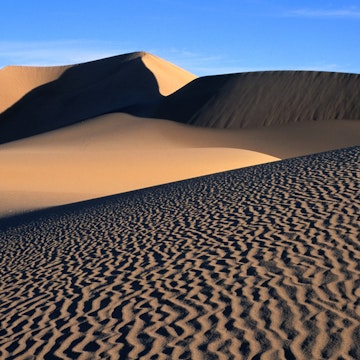
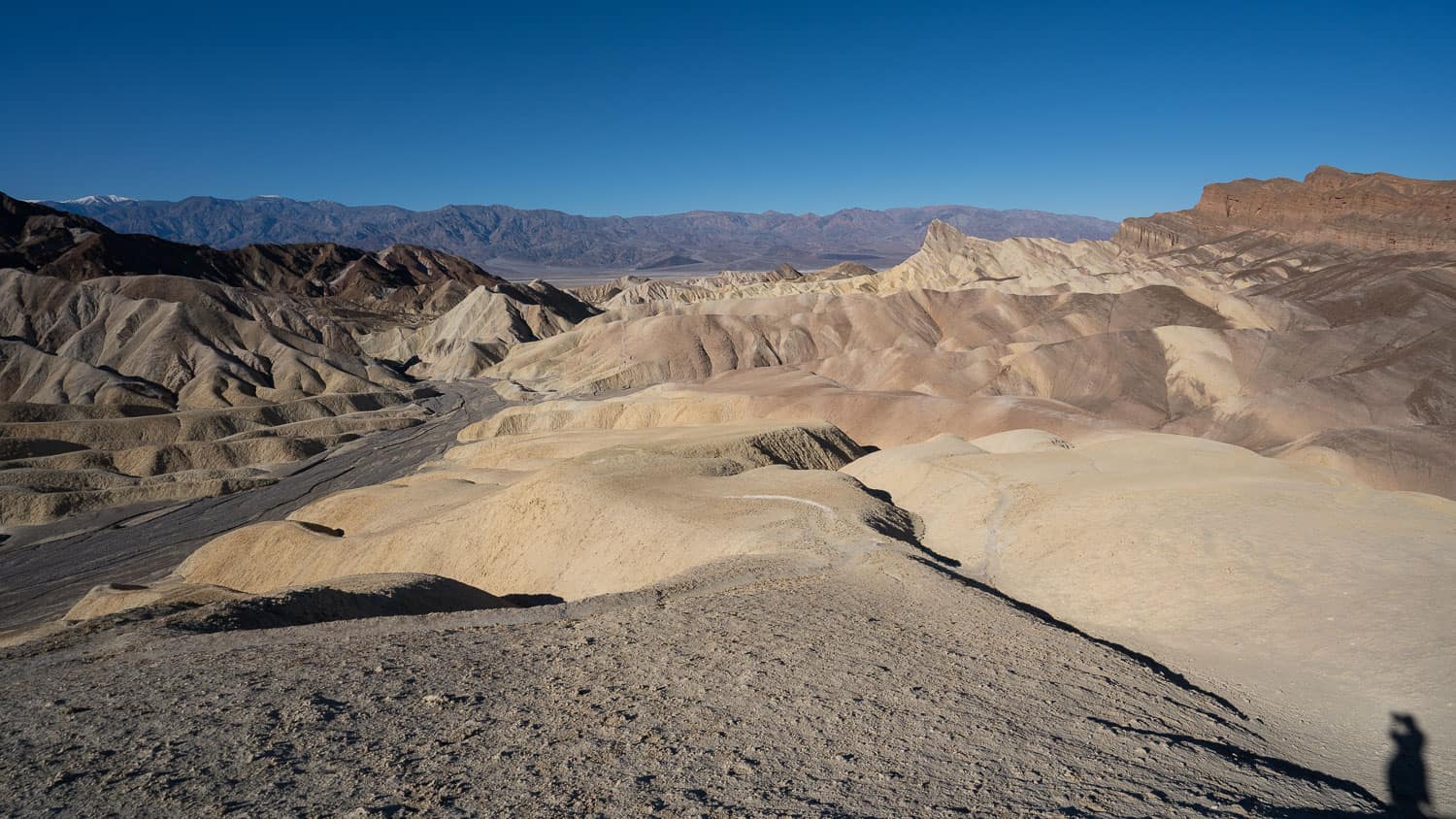
15 Incredible Things to Do in Death Valley National Park
This page contains affiliate links. Please read our disclosure for more info.
Death Valley National Park is unlike anywhere else we’ve visited. It’s one of the lowest and hottest places on earth and is full of incredible otherworldly landscapes.
We spent a week roaming its vast stark beauty—watching sunrises on sand dunes and sunsets across salt flats, hiking through rippled badlands and golden canyons, and admiring multicoloured hills and snow-capped peaks.
Here I share our picks for the best things to do in Death Valley from easy but dramatic viewpoints to more challenging hikes. You’ll also find our tips for making the most of your trip, where to stay, a suggested itinerary, and a map with all the top attractions.
Where is Death Valley National Park?
Best things to do in death valley national park: our top picks, other death valley attractions worth visiting, things to do near death valley, death valley itinerary for two days, accommodation in death valley, tips for visiting death valley national park, map of death valley attractions, is death valley worth visiting, more california posts.
Death Valley National Park is in Inyo County, California, along the border with Nevada (a small part of the park is in the neighbouring state) and east of the Sierra Nevada mountains.
You’ll need your own vehicle to get there or you could visit on this small group Death Valley day trip from Las Vegas .
Here are approximate driving times from nearby destinations to Furnace Creek (in the heart of the park):
- Las Vegas (Nevada) – 2 hours
- Los Angeles – 4 hours 30 minutes
- Bakersfield – 4 hours
- Joshua Tree – 4 hours 15 minutes
- Palm Springs – 5 hours
- Yosemite Village – 6 hours (in summer)
- Sequoia National Park – 6 hours
- Zion National Park (Utah) – 4 hours 30 minutes
We visited Death Valley on a road trip between Palm Springs and Zion National Park. See our tips for visiting Zion in winter .
It’s also ideal to combine with Joshua Tree National Park, which we passed on the way (and visited previously).
See our guide to the best things to do in Southern California for more suggestions for the area as well as our post on the best Joshua Tree hikes .
At the end of this post you’ll find a map of Death Valley National Park with all these featured attractions.
Back to Contents
Death Valley National Park is immense—3.4 million acres with 1000 miles of roads. These suggested Death Valley activities focus on the main part of the park (within an hour or so of Furnace Creek where the visitor centre and hotels are located).
There are many things to see in Death Valley beyond this area, but you’ll have to drive for hours and many roads are 4WD only (all the places below are accessible without 4WD).
These are our Death Valley must sees.
1) See the Sunrise at Zabriskie Point
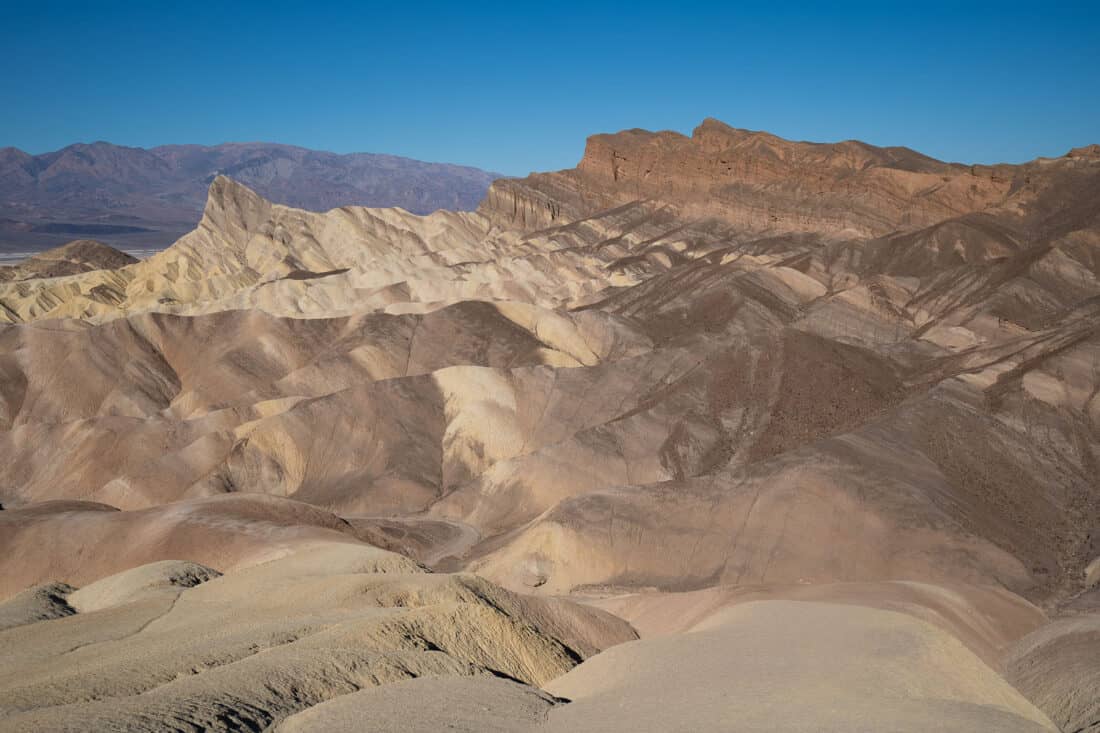
Access: Paved road Facilities: Toilet in car park Time needed: 10+ minutes Distance from Furnace Creek Visitor Centre: 5 miles (8km)/ 10 minutes
If you only do one Death Valley activity, make it the viewpoint at Zabriskie Point.
It’s only a few minutes’ walk on a paved path from the parking lot to the viewing area, and it is spectacular.
You gaze down into the valley of bumpy badlands striped yellow and brown, shaped by the force of water. You can also see the jagged peak of Manly Beacon, the rugged Red Cathedral and beyond to the salt flats and snow-topped Panamint Mountains.
Zabriskie Point is most popular at sunrise and it’s well worth getting up for. The sun rises behind you and it’s a stunning sight as it lights the mountains in front and turns them a glowing red.
Don’t expect to have it to yourself, but on a winter weekday, we found there was enough space to spread out. Some visitors are organised and bring chairs, blankets, and hot drinks. You’ll definitely want extra layers as it felt very chilly in the wind.
If you don’t manage to wake up in time, the light was still beautiful two hours after sunrise when the badlands are fully lit up. It’s also a popular sunset spot.
One of the best hikes in Death Valley starts from here (see below).
2) Hike the Golden Canyon and Gower Gulch Loop
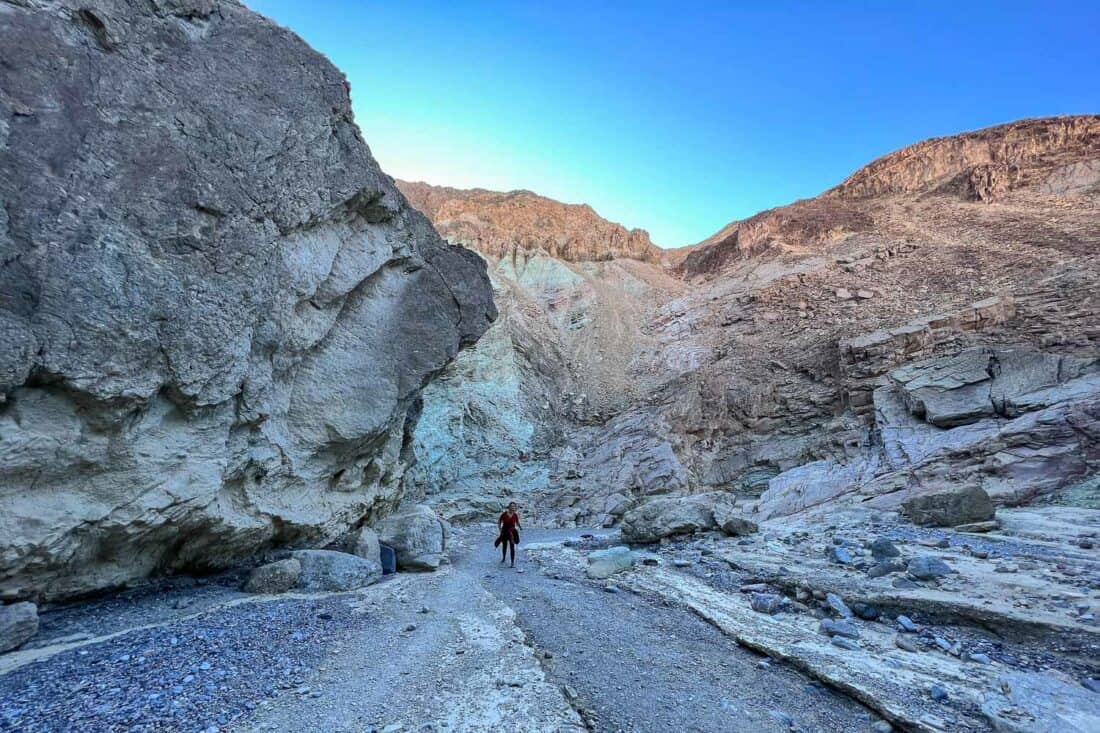
Access: Paved road Facilities: Toilet at both trailhead car parks Time needed: 1-3 hours Hiking stats: 6.2 miles (10km)/ 2.5 hours / 1130 feet (345m) elevation gain Distance from Furnace Creek Visitor Centre to Golden Canyon Trailhead: 3.5 miles (5.5km)/ 7 minutes The Golden Canyon hike is one of the best things to do in Death Valley National Park. This popular trail has its own trailhead and most visitors do a 2-mile roundtrip hike from here to the junction to Red Cathedral.
You can also experience it on a longer loop hike, which is what we did. As we were already at Zabriskie Point for sunrise we decided to hike down into Golden Canyon and come back up Gower Gulch.
We’re so glad we did as the hike was amazing. My favourite part was at the start walking down from Zabriskie on the Badlands Loop with the rippled badlands and Red Cathedral glowing in the golden morning light. Starting at 7.15am we didn’t see anyone else until we reached the Golden Canyon.
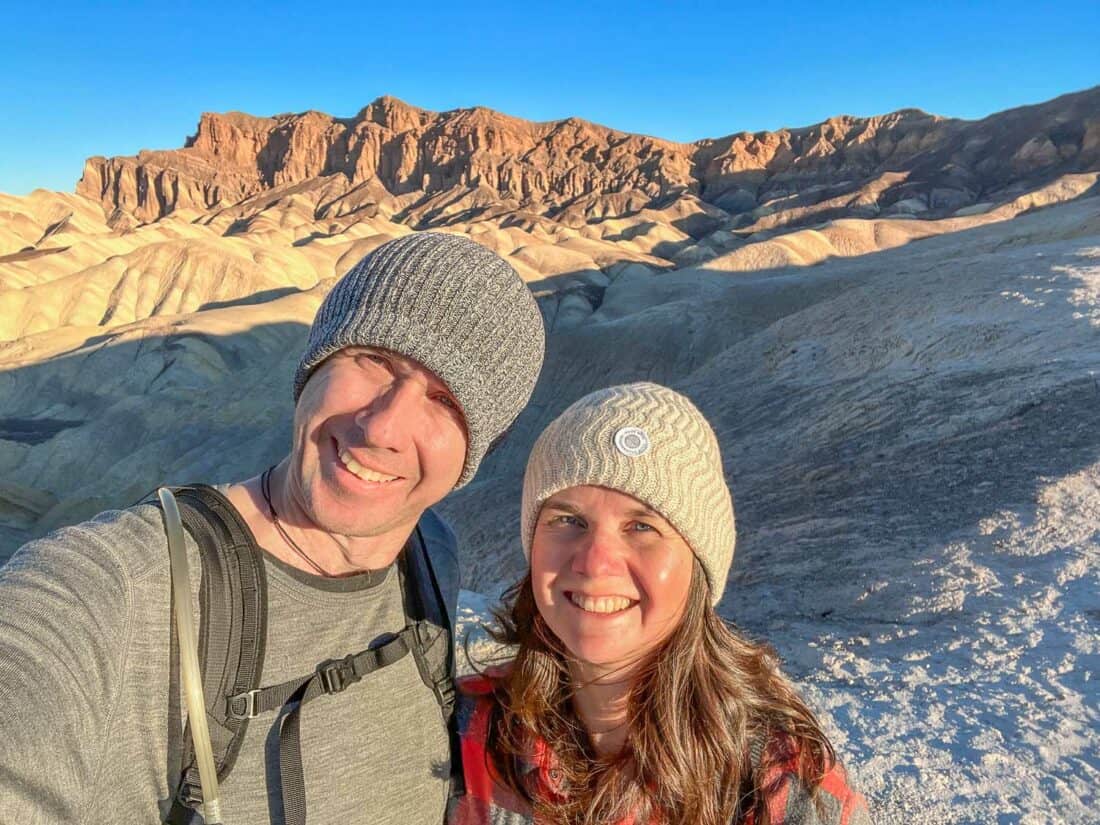
It was magical walking in solitude through the harsh, dry but stunning environment.
It was a little steep and slippy in parts, and you have to walk on a narrow ridge at one point, which was slightly nerve-racking, but overall we didn’t find it a difficult walk and it gets easier when you reach Golden Canyon.
You definitely want to start early and bring plenty of water as once the sun hits the canyon, it feels very hot.
When you reach the high walls of Golden Canyon, you have the option of a one-mile return detour to Red Cathedral, but we skipped it as it involves some scrambling.
It took us 65 minutes to reach the Golden Canyon trailhead (where there’s a toilet) and then we walked parallel to the road for 10 minutes before turning left into Gower Gulch.
Some people don’t think Gower Gulch is worth it but we enjoyed it (and it’s quieter than Golden Canyon). There was some gently scrambling at the beginning, but then it opened up and the ascent was fairly easy. There are some interesting rock formations and green and pink walls.
It took another hour to get back to Zabriskie Point—the last section back on the Badlands Loop was the hardest as it was a steep climb in full sun. The view looking back was astounding though.
Don’t miss hiking in this area. Even if you don’t do the full loop, there are plenty of shorter options.
See a map of the Golden Canyon and Gower Gulch hike on Alltrails or the NPS website for all the Golden Canyon trails.
3) Enjoy a Colourful View at Artists Palette
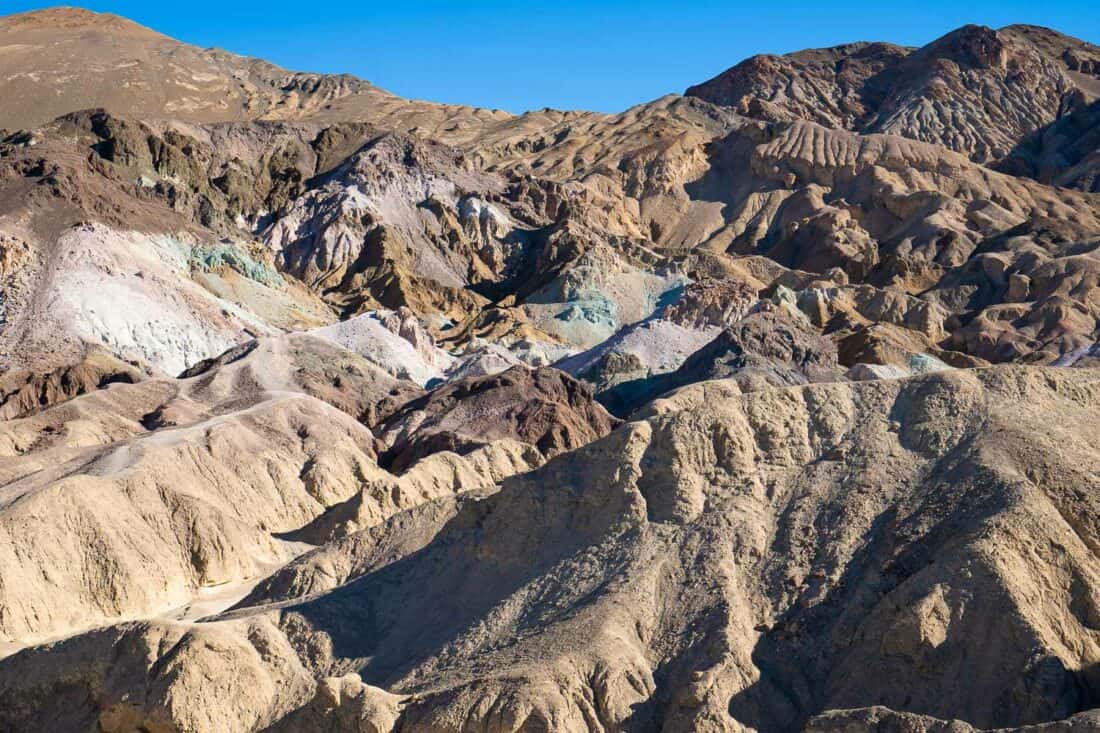
Access: One-way paved road, no vehicles longer than 25 feet Facilities: Toilet in car park Time needed: 30 minutes including drive Distance from Furnace Creek Visitor Centre: 14.5 miles (23.5km)/ 24 minutes
Another of the best views in Death Valley is at Artists Palette. Here you can admire the colourful hills created by mineral oxidation—pink and green mixing with the usual shades of orange and brown.
The viewpoint is accessed on the 9-mile Artists Drive Loop, a beautiful if twisty road that can only be driven one way (starting at the south end off Badwater Rd).
There are various places to stop and take photos, but the third stop (marked on Google Map as Artist’s Palette) is the best one. There’s also a toilet here.
You can see the vibrant hills from the parking lot or walk up the trail as far as you’d like for a higher perspective.
Artists Palette is best visited in the golden hour before sunset. We arrived an hour after sunrise (after visiting Badwater Basin) and the hills were still in shadow so the colours were muted.
We came back another day mid-morning (three hours after sunrise) and the colours were much better, although the light was a little harsh.
This was one of the filming locations for Tatooine in the Star Wars movies and it’s easy to believe you’re on another planet.
4) Watch the Sunset at Dante’s View
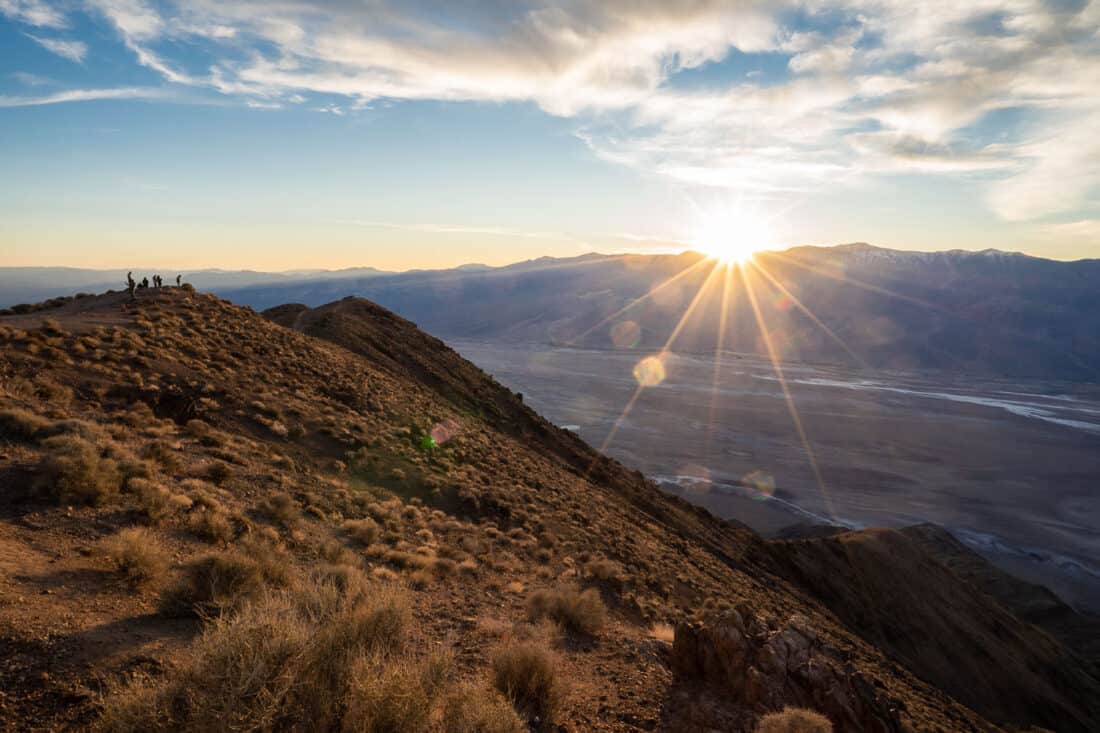
Access: Paved, winding, and steep road. No RVs or trailers (car park to leave trailers lower down) Facilities: Toilet at lower parking but it’s quite far from upper parking—stop on the way up Time needed: 30 minutes – 1 hour Distance from Furnace Creek Visitor Centre: 25 miles (40km)/ 35 minutes
Dante’s View is one of the best places to visit in Death Valley for more spectacular views. It’s popular at sunset, although I’m sure sunrise would also be beautiful (if freezing).
Here you realise that Death Valley is not all desert as you ascend to 5575 ft (1699 m) above Badwater Basin on the ridge of the Black Mountains. The temperature can be 30ºF lower up here.
The sweeping panorama takes in much of the park—the salt flats and the badlands and the Panamint Mountains on the other side of the valley.
You can easily enjoy the view from the parking lot or follow the trails in either direction along the rim (I think the view is best to the left). It’s busy at sunset but easy to find a spot to yourself.
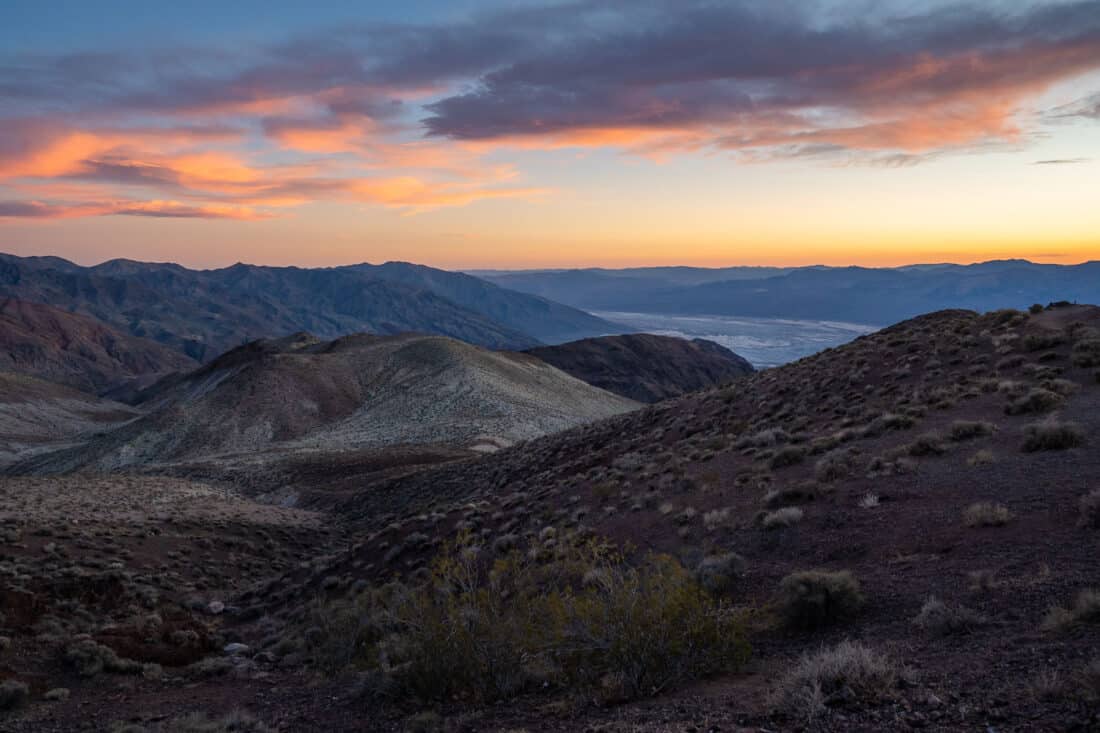
Expect the sun to disappear behind the mountains 10 minutes before the official sunset time. It’s well worth waiting 20 minutes after sunset as the sky lights up in pink and orange and the clouds glow—just gorgeous!
It’s well worth the drive up here for views like this.
5) Visit the Lowest Point at Badwater Basin Salt Flats
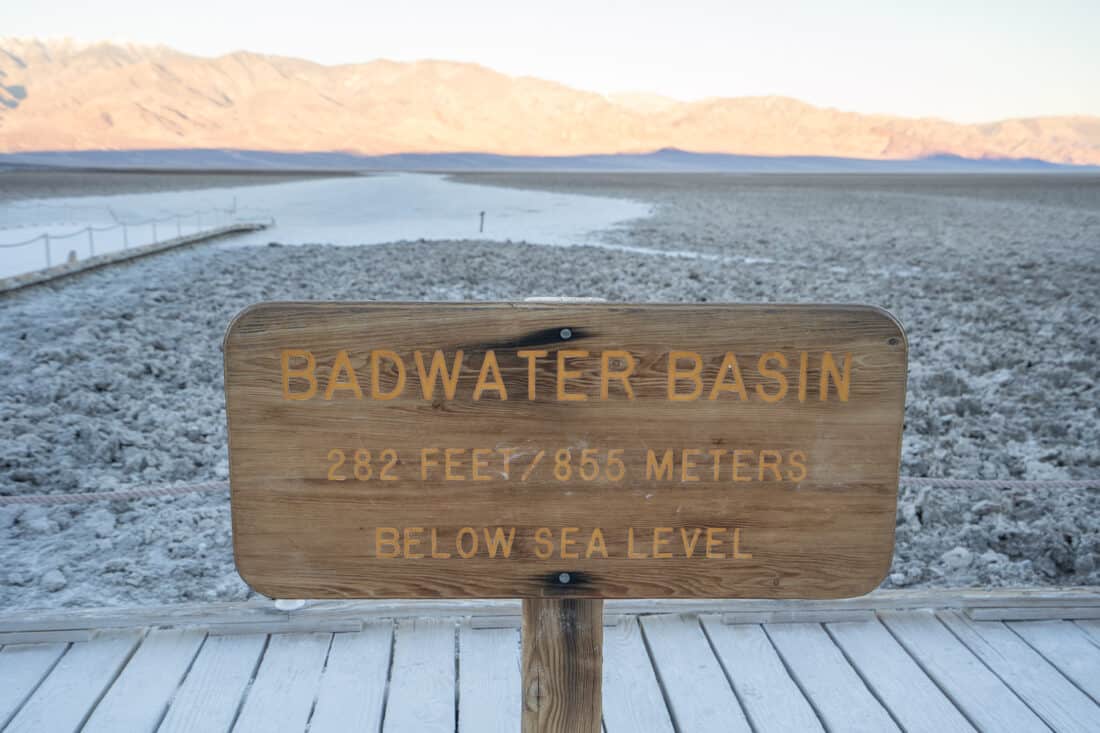
Access: Paved road Facilities: Toilet in car park Time needed: 15 minutes+ Distance from Furnace Creek Visitor Centre: 15.5 miles (25km)/ 20 minutes
Badwater Basin is one of the most iconic spots in Death Valley. This salt pan is an ancient lake bed and is the hottest and lowest point in North America at 282 feet below sea level (look for the sea level marker on the mountain above the parking lot).
Again there’s an easily accessible viewing platform or you can walk out onto the immense salt flats as far as you want.
It’s popular at sunset but there were only a few others here at sunrise. Although we couldn’t see the sun come up, it was beautiful to see the light catch the snowy mountains opposite.
6) Climb a Dune at Sunrise at Mesquite Flat
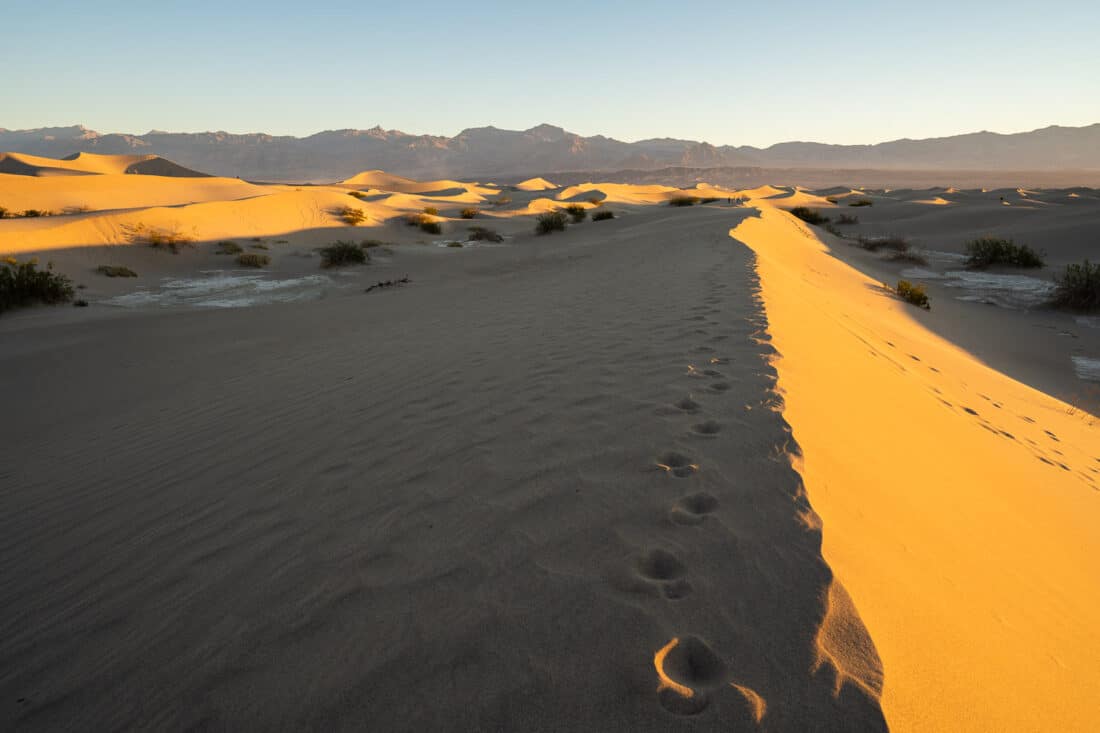
Access: Paved road Facilities: Toilet in car park Time needed: 30 minutes – 1 hour+ Distance from Furnace Creek Visitor Centre: 23 miles (35km)/ 26 minutes
The Mesquite Flat sand dunes are the most accessible sand dunes in Death Valley, next to Stovepipe Wells.
It’s well worth venturing beyond the parking lot and climbing up into the dunes for the best views. There’s no trail—just create your own path.
You can hike to the top of the biggest dune (about two miles return), but walking on sand is hard going so we enjoyed the view from a distance.
We arrived about 30 minutes before sunrise to allow time to get to a good spot—we only had to walk about 10 minutes before we decided on a place to wait. It was another stunning sunrise with the tops of the distant mountains turning pink before the dunes began to glow.
On our way back we had fun running down the dunes (which is less scary than it feels).
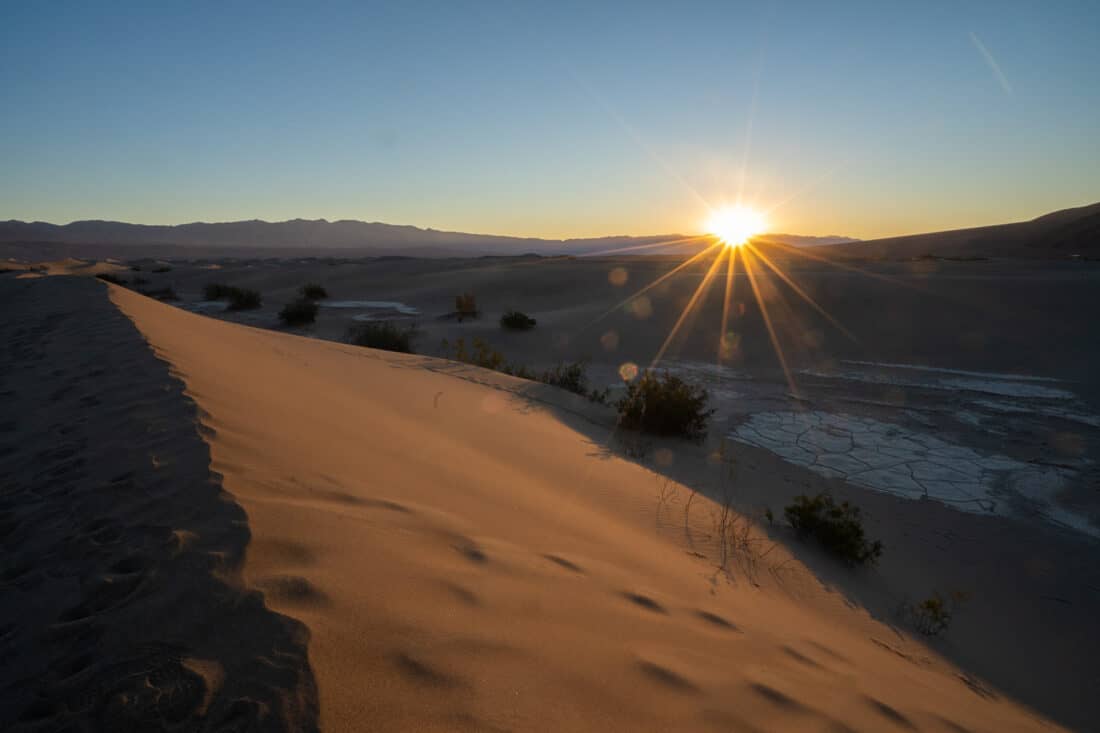
Mesquite Flat is best visited at sunrise or sunset when the light is gorgeous and it’s not too hot. We wore hiking sandals, which were ideal as shoes would fill with sand.
Eureka Dunes are even taller but they are three hours from Furnace Creek and may require a 4WD. It’s much harder to get there for the best light unless you camp nearby.
If you have more time, we also recommend these things to do in Death Valley.
7) Hike the Rim of Ubehebe Crater
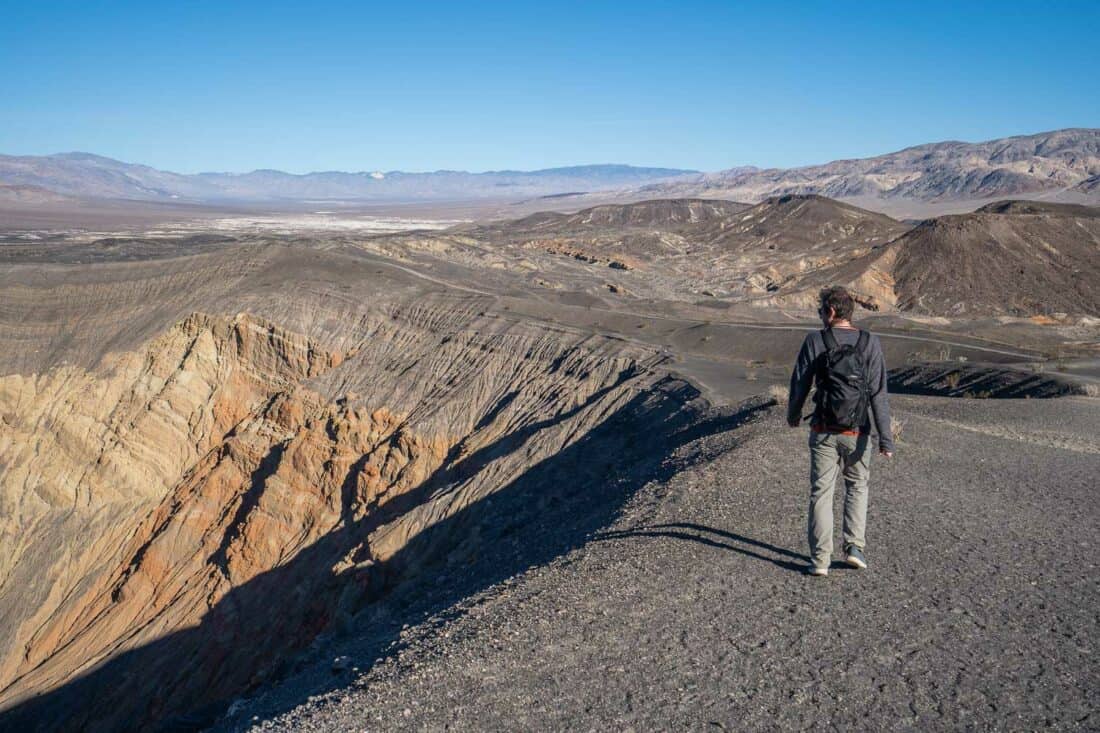
Access: Paved road Facilities: None (nearest toilet 5 miles before at Grapevine Ranger Station) Time needed: 1 hour (longer to descend into crater) Hiking stats: 2 miles (3.2km)/ 50 minutes / 485 feet (148m) elevation gain including Little Hebe Crater Distance from Furnace Creek Visitor Centre: 55 miles (90km)/ 1 hour and 15 minutes
Ubehebe Crater is an extinct volcano in a more remote part of the park. We visited after Mesquite Flat sand dunes, which are an hour away.
We hiked the rim of the 2100-year-old crater, gazing down into the massive expanse—dark grey on one side, orange and gold on the other. It’s a wild and beautiful place—we were the only ones there at 8.30am.
At 2800 feet, it’s cooler than Furnace Creek, but it still felt hot as there’s no shade. We hiked counterclockwise to do the elevation first—the first hill was surprisingly hard going as you’re on loose gravel and sand.
This way you pass the smaller Little Hebe Crater.
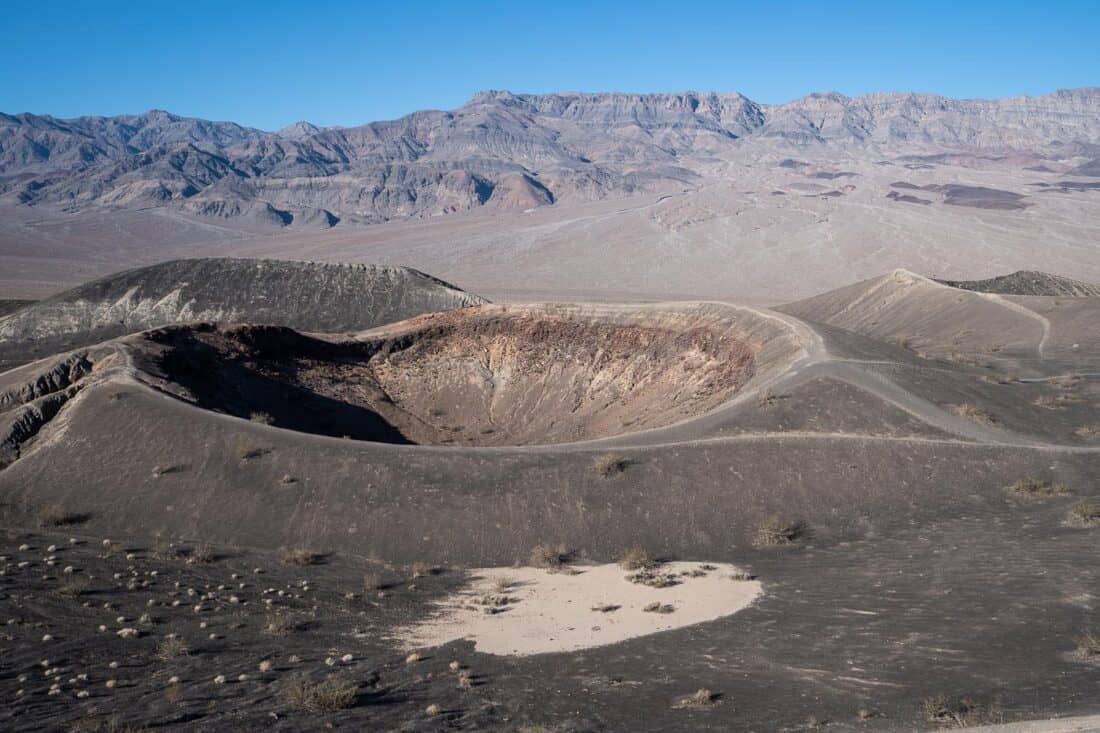
You can also hike down into the crater but expect a challenging climb out in ankle-deep debris.
From Ubehebe you can delve deeper into the park to the Racetrack Playa, but it requires a 4WD. Scotty’s Castle is also in this area, but it’s closed for repairs after a flood until at least 2023.
8) Make a Quick Stop at Devil’s Golf Course
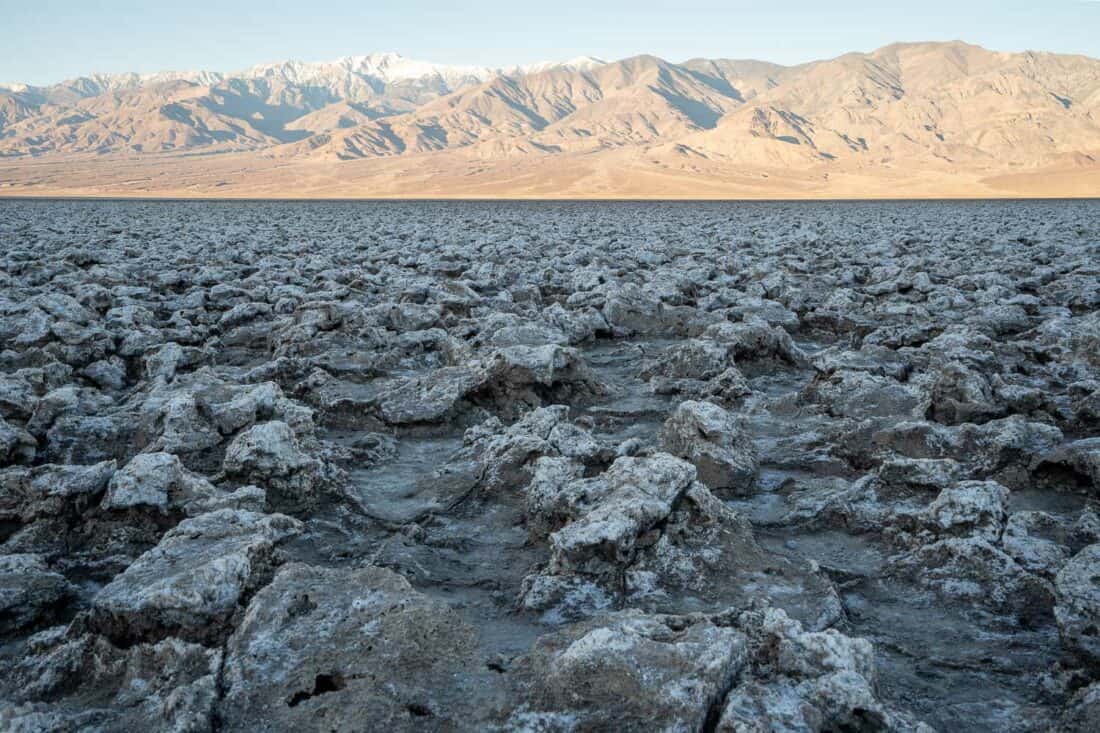
Access: Gravel road off Badwater Rd usually accessible to sedans Facilities: None Time needed: 5 minutes+ Distance from Furnace Creek Visitor Centre: 10 miles (15km)/ 15 minutes
Not far from Badwater Basin is a quick stop called Devil’s Golf Course where rock salt has been eroded by wind and rain into jagged spires.
It’s a cool (and usually quiet) place to see in Death Valley, but you can’t walk on the dangerous sharp rocks. Apparently, only the devil could play golf here!
9) Hike Through Desolation Canyon
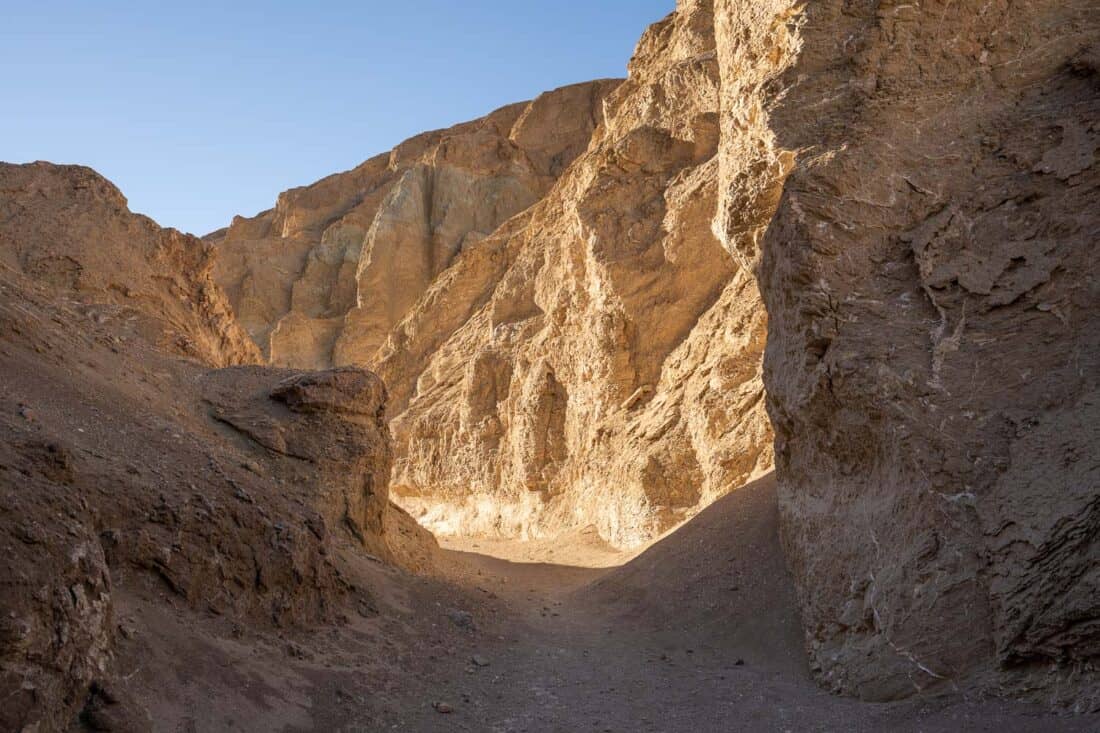
Access: Unmarked gravel road off Badwater Rd usually accessible to sedans Facilities: None Time needed: 1.5 to 2 hours for full hike. Hiking stats: 3.6 miles (5.8km) / 770 ft (235m) elevation gain Distance from Furnace Creek Visitor Centre: 5.5 miles (9km)/ 10 minutes
If you are looking for a quieter hiking trail than Golden Canyon, head to Desolation Canyon.
The hike starts uphill through the canyon and ends with a view of Artists Palette.
We didn’t make it that far as the heat was a bit much and we turned around after 25 minutes/ 1 mile when we reached an 8ft rocky wall that you had to scramble up.
See the Desolation Canyon hike on Alltrails .
The access road is unmarked so you’ll need Google Maps to find it.
10) Drive the Adventurous Twenty Mule Team Canyon
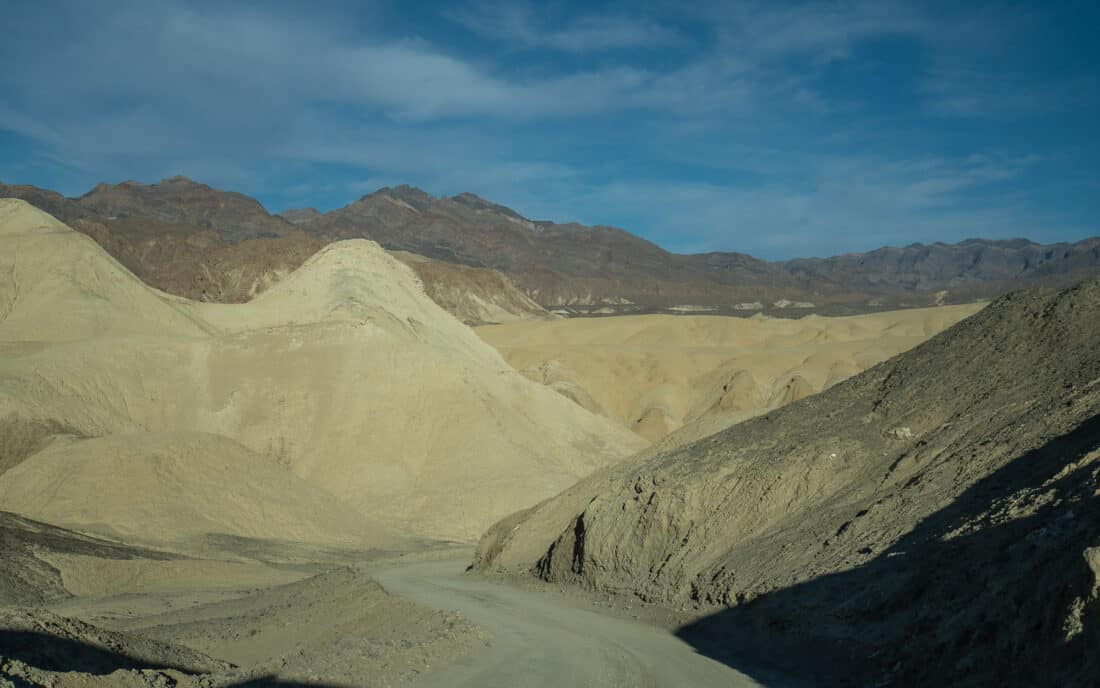
Access: One-way dirt road usually accessible to sedans Facilities: None Time needed: 10-30 minutes Distance from Furnace Creek Visitor Centre: 6 miles (9.5km)/ 10 minutes
We drove the one-way Twenty Mule Team Canyon on the way from Zabriskie Point to Dante’s View. It was only a 10-minute detour (we didn’t make any stops) and worth it if you are looking to get off the beaten track in Death Valley.
It’s not for nervous drivers, though, as the dirt road through the badlands is very narrow, winding, and ends with a steep rollercoasteresque drop.
11) Head Back in Time at Harmony Borax Works
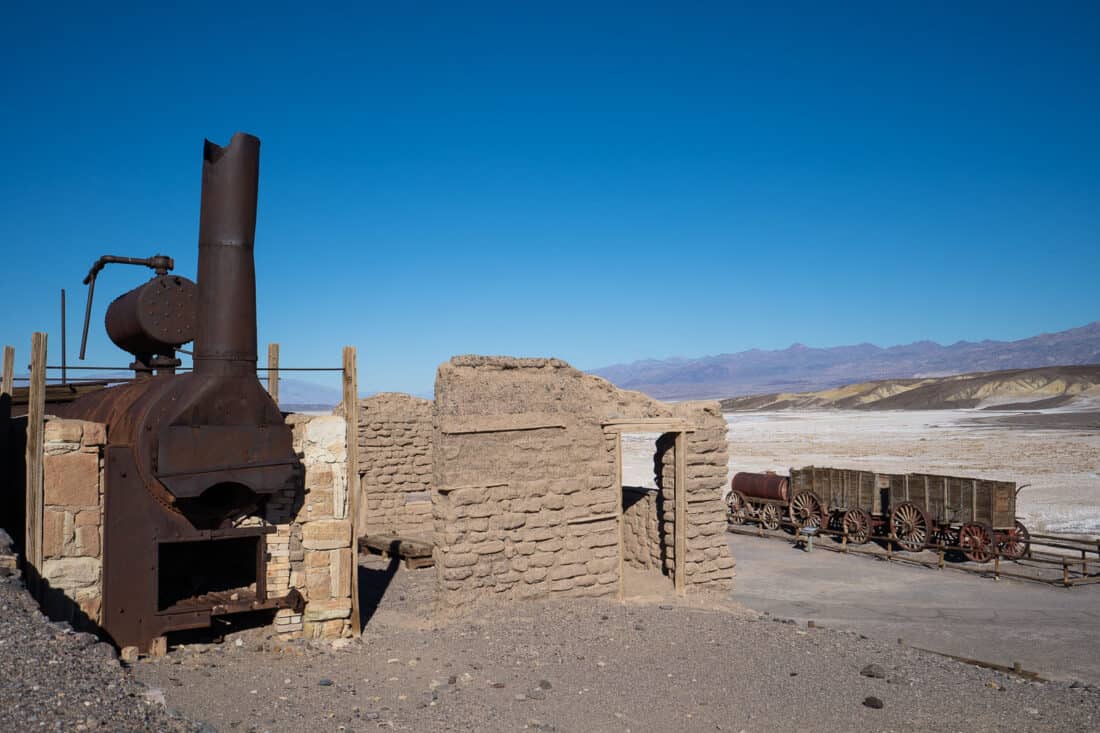
Access: Paved road Facilities: None Time needed: 15-20 minutes Distance from Furnace Creek Visitor Centre: 2 miles (3km)/ 5 minutes
The 0.4-mile history trail at Harmony Borax Works near Furnace Creek is an easy walk and a nice change from other parts of the park.
Signs give you information on the 1884 borax plant as you stroll past the old processing buildings. The wagon on display was pulled by large mule teams (known as the 20-Mule Team) to transport the finished product to market.
Like the Rhyolite gold mine, the plant only lasted a few years.
Harmony Borax Works is one of the best places to see the stars in Death Valley. We were staying too far out to do this, but it’s an easy trip from the Furnace Creek hotels (some guests even biked here).
12) Spot Pupfish on the Salt Creek Trail
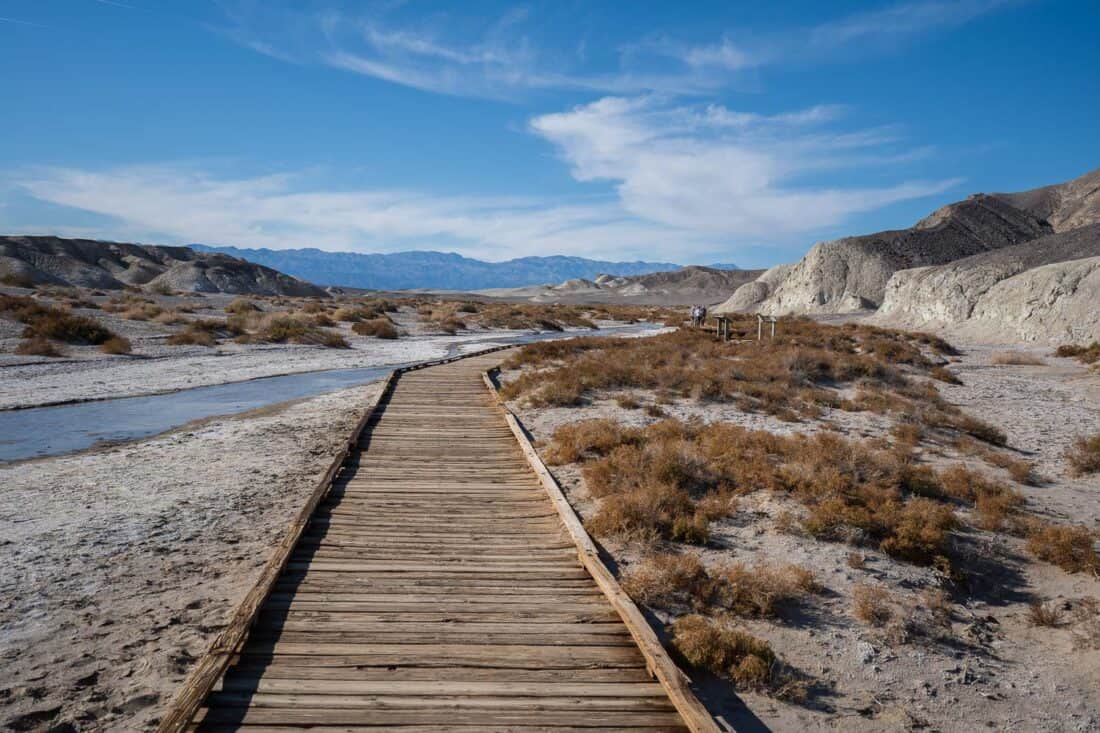
Access: Gravel road usually accessible to sedans. Facilities: Toilet in car park Time needed: 20 minutes Distance from Furnace Creek Visitor Centre: 14.5 miles (23.5km)/ 20 minutes
I didn’t expect much from the Salt Creek Trail, but I enjoyed the easy walk on the 0.5-mile boardwalk loop.
It feels very different from the rest of the park—a little oasis with a pretty stream surrounded by vegetation. The rare tiny pupfish lives in the salty water here.
Salt Creek is easy to add to your Death Valley itinerary as it’s not far from Furnace Creek.
13) Cool Off at The Ranch Lodge
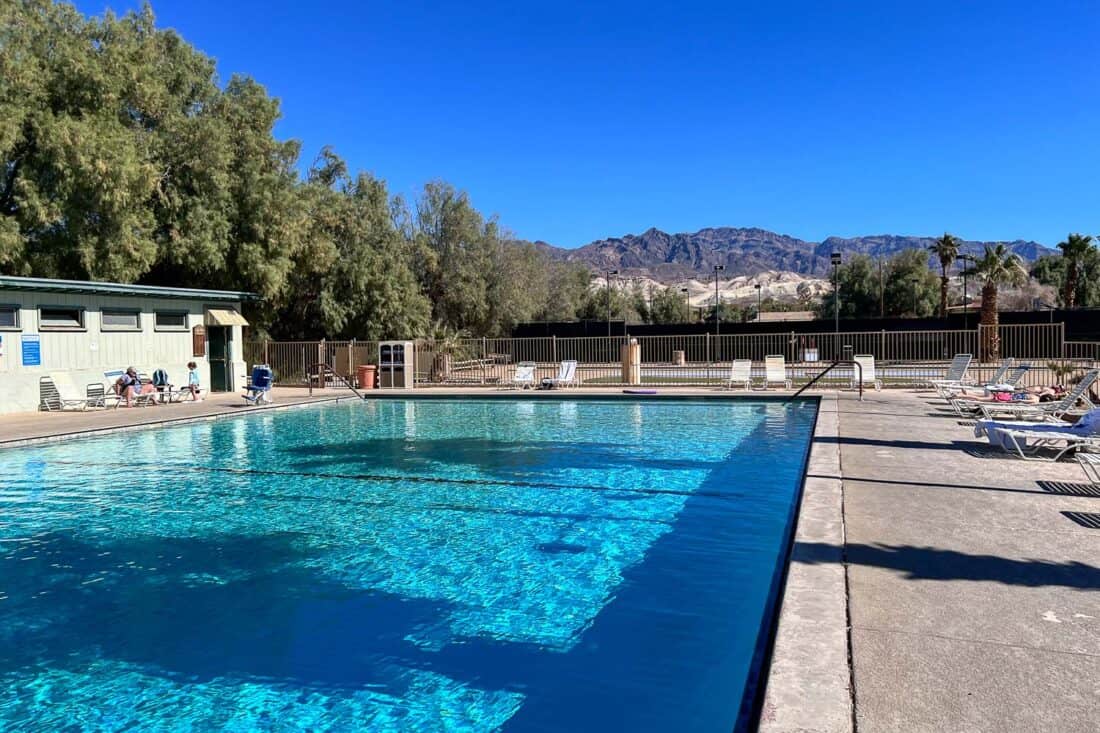
Access: Paved road Facilities: Toilets, stores, restaurants, pool Time needed: 15 minutes – half a day Distance from Furnace Creek Visitor Centre: 0.5 miles (1km)/ 2 minutes
The Ranch Lodge in Furnace Creek has a few facilities open to non-guests that we really appreciated after a hot morning hiking.
There’s an old-fashioned ice cream parlour where you can sit at the counter or on the outside terrace to enjoy a sundae, cone, or milkshake. It’s not the best ice cream, but you won’t care in the heat.
There’s also a general store, outdoor store, restaurant, golf course, and horse riding.
Best of all, the hotel allows non-guests to access the pool for $14. This was so refreshing after a morning of hiking and the perfect way to spend the heat of the day.
The large spring-fed pool is naturally warm year round so it’s comfortable to swim even in winter.
It’s worth leaving the park and heading across the border to Nevada for some interesting attractions.
14) Visit Rhyolite Ghost Town
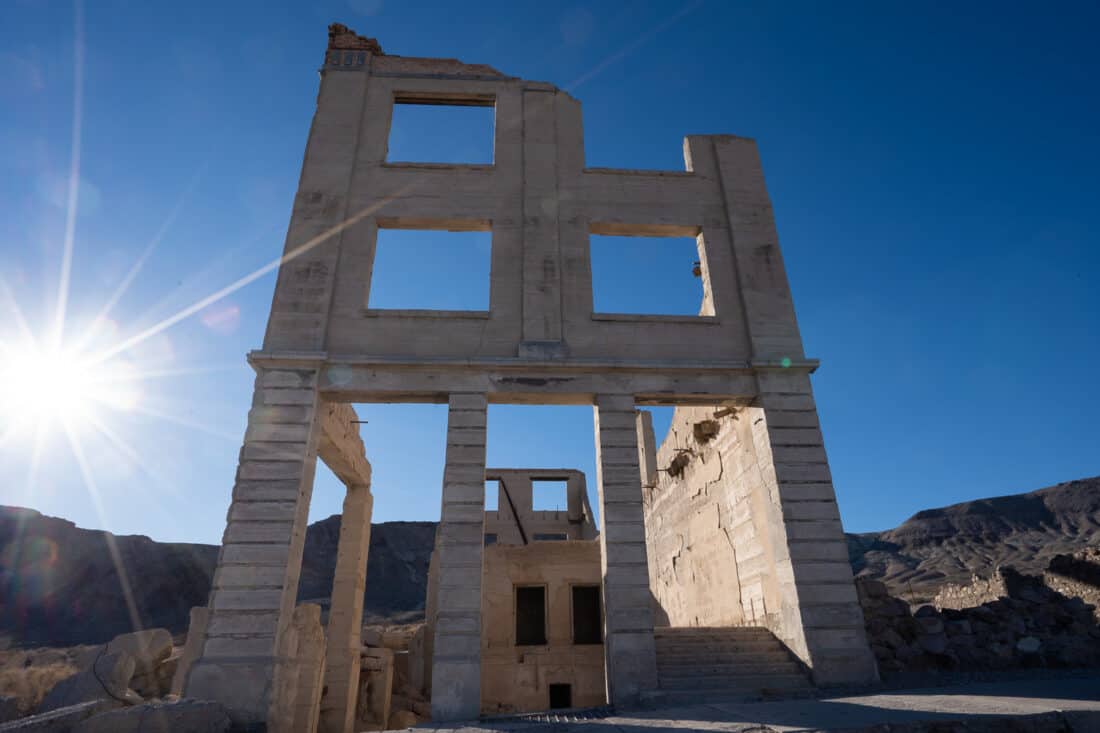
Rhyolite ghost town is one of the most unusual things to do in Death Valley (even if it is outside the park).
This remote gold mining town thrived in its brief boom years—there was a train station, general store, bank, school, miner’s union and more—but it didn’t take long until the gold ran out.
You can now wander past the ruins of its glory years—most of the buildings were built in 1906 and 1907 and the mine shut down just a few years later.
Surrounded by dramatic desert mountains it’s a bleak but intriguing place.
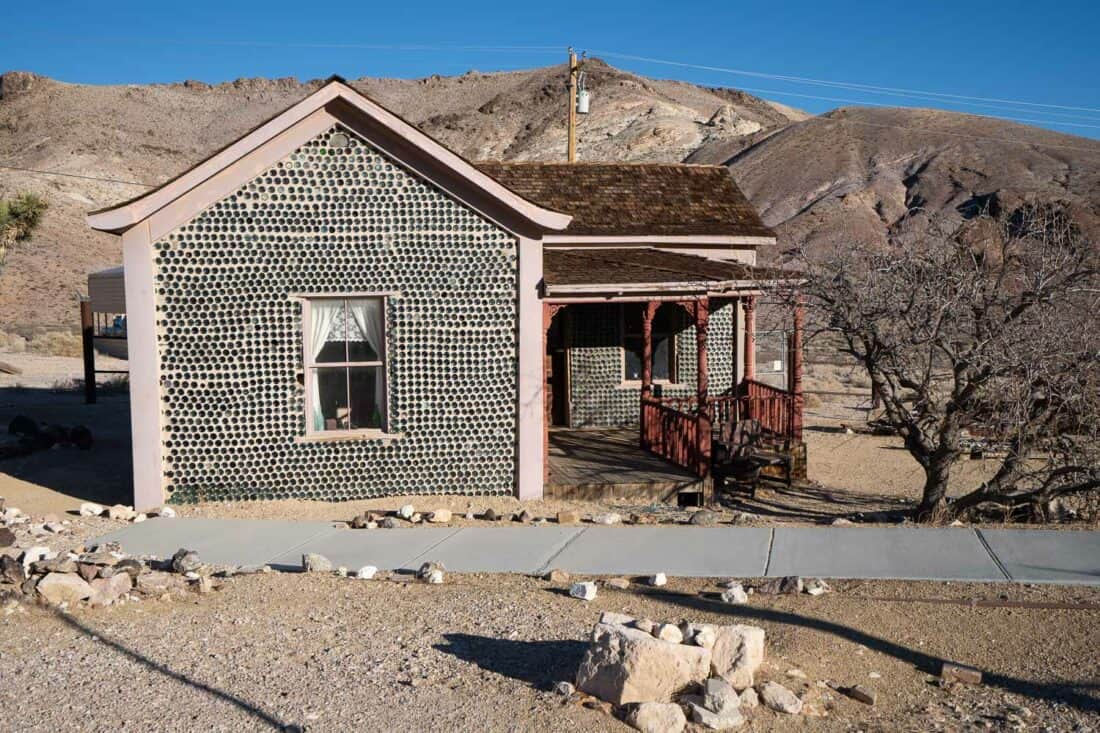
One of the most interesting sights is Tom Kelly Bottle House—the house was made with thousands of glass bottles as wood was hard to come by.
If you are staying in Beatty, you should definitely stop at Rhyolite. It’s free entry and open 24 hours.
15) See Burros in Beatty
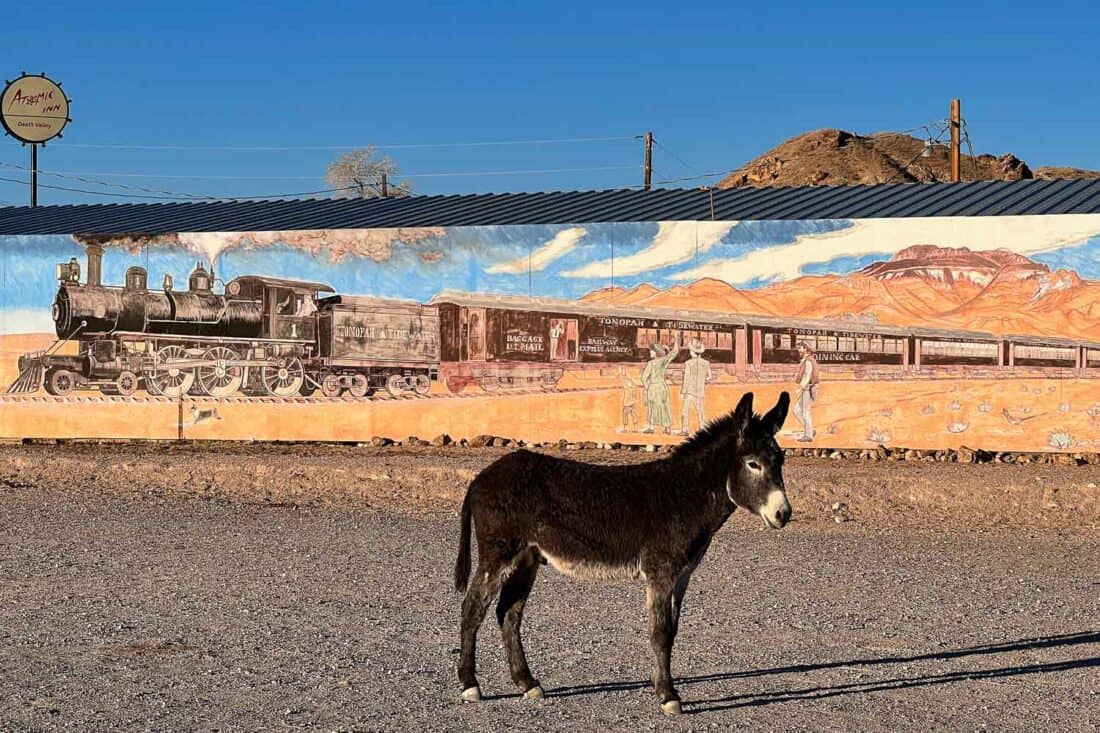
Beatty is a small desert town in Nevada and one of the most affordable bases for exploring Death Valley. It has a remote, Wild West vibe with a wooden saloon on Main St (sadly closed).
Best of all, you can often see wild burros roaming the streets. These donkeys were used in the gold mining days and let free when the industry went bust.
If you only have two days in Death Valley, this is the itinerary I recommend.
- Zabriskie Point for sunrise
- Hike Golden Canyon and Gower Gulch
- Lunch/Rest (maybe enjoy the pool at The Ranch)
- Harmony Borax Works
- Twenty Mule Team Canyon
- Dante’s View for sunset
- Mesquite Flat sand dunes for sunrise
- Ubehebe Crater
- Salt Creek Trail
- Artists Palette (1-2 hours before sunset)
- Devil’s Golf Course
- Badwater Basin for sunset
If you have any extra time, add Desolation Canyon or Rhyolite and Beatty.
The best places to stay in Death Valley are in the heart of the park at Furnace Creek. Here you are close to popular attractions like Zabriskie Point (just 10 minutes away), which makes it much easier to be there for sunrise and sunset.
There are two hotels here— The Ranch at Death Valley is more affordable and family-friendly and The Inn at Death Valley is very expensive. Both of them book up far in advance though, so we couldn’t get a reservation (booking three weeks out in winter).
Camping is a budget option in Furnace Creek and various locations within the park.
Stovepipe Wells is another place to stay within the park. Stovepipe Wells Village Hotel isn’t as convenient for Zabriskie Point (35 minutes away), but it’s closer to the Mesquite Flat sand dunes and is more affordable than Furnace Creek.
As we couldn’t get a hotel in the park, we rented an Airbnb in the nearest town outside the park—Beatty, which is actually in Nevada.
We loved the quirky, stylish house, but the location did feel further away than we’d like, and we had a lot of 5.30am starts to see the sunrise in the park.
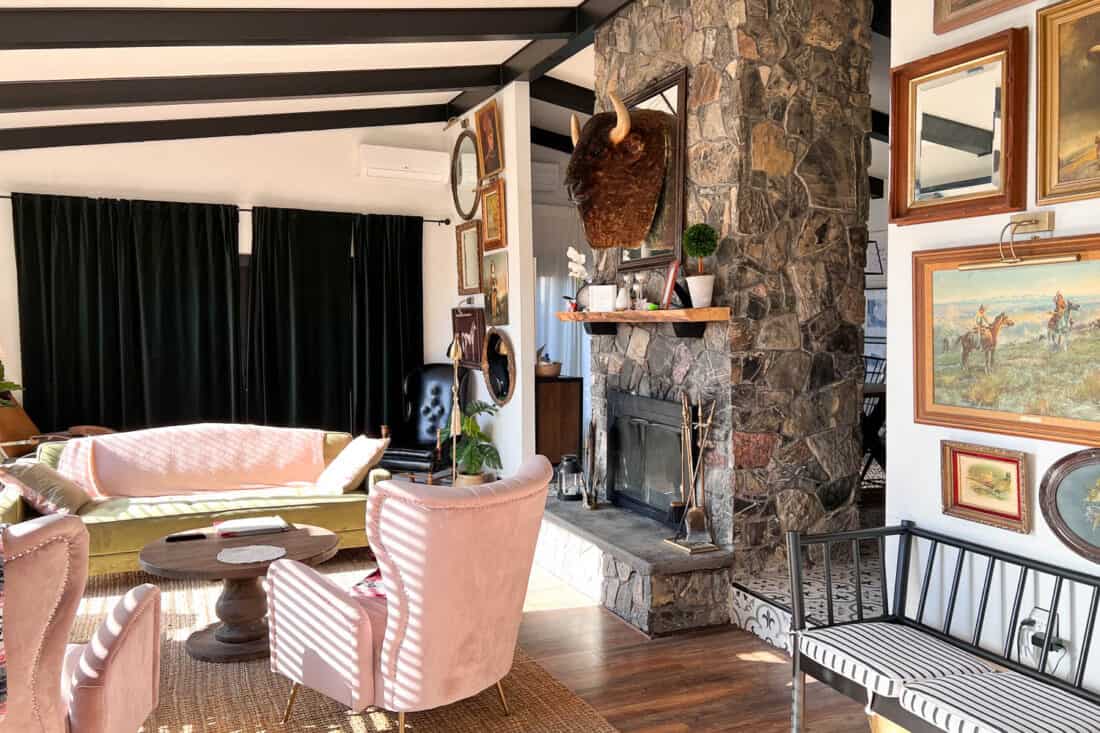
Although Beatty is an easy 40-minute drive from Furnace Creek, you have to bear in mind how spread out the sights are, so we usually had to drive for about an hour.
But if accommodation in the park is unavailable or too expensive, Beatty is a good option. There are a few budget motels here including Death Valley Inn and Exchange Club Motel .
- There are no entrance gates. Pay the $30 fee (per vehicle) when you arrive at the visitor centre or some popular spots have ticket machines next to the parking.
- An America the Beautiful annual national parks pass can also be used (display it in your car). This is excellent value if you’ll visit three or more national parks or monuments in a year.
- The best time to visit is early spring or winter. It’s excessively hot in summer and will be dangerous to hike.
- Even in winter, it was hotter than we expected—coming from Beatty before sunrise the temperature rose from 35ºF to 60ºF as we descended into the park. In the afternoons it reached 90ºF. Be prepared with a hat, sunglasses, and sunscreen.
- In winter wear layers for the cool mornings and hot afternoons.
- Bring a cooler with lots of water and food. There are no shops or restaurants outside Furnace Creek and Stovepipe Wells.
- A 4WD vehicle is a good idea and will allow you to explore further into the park, but it’s not necessary for the Death Valley top sights on this list. We rented an SUV (without 4WD) and appreciated the higher clearance, but we saw sedans on all the roads we drove. We use Rental Cars to search for the best deals.
- There’s no cell signal in most of the park so save Google Maps offline for directions.
- The Alltrails app is useful if you plan to hike. We bought the Pro plan so we could save route maps offline.
- Fill up with gas outside the park (Beatty is a good spot) as it’s very expensive at Furnace Creek. Stovepipe Wells is slightly cheaper but still well over regular prices.
- Don’t enter canyons if there’s any sign of rain.
- Leave no trace—don’t litter or take any rocks or plants with you.
Yes, Death Valley is absolutely worth visiting! It’s a huge and diverse national park with so much to explore.
Just make sure you visit outside the summer to experience the inhospitable landscapes more safely and enjoyably. At any time of year it’s always worth getting up early for the best views and most comfortable temperatures.
I hope this post has given you some ideas of what to see in Death Valley. Let us know your favourite places!
Southern California
- 23 Unmissable Things to Do in Southern California
- 14 Best Hikes in Joshua Tree National Park
- Borrego Springs Sculptures: The Ultimate Guide to Galleta Meadows
- 18 Best Outdoor Activities in San Diego
- Disneyland & California Adventure in One Day: An Itinerary for Adults
Northern California
- The Best 3 Day Yosemite National Park Itinerary
- 17 Best Things to Do in Sonoma California
- Mono Lake in California: Visit the Stunning Tufa Towers Near Yosemite
- Visiting Bodie California Ghost Town: Everything You Need to Know
If you enjoyed this post, pin it!
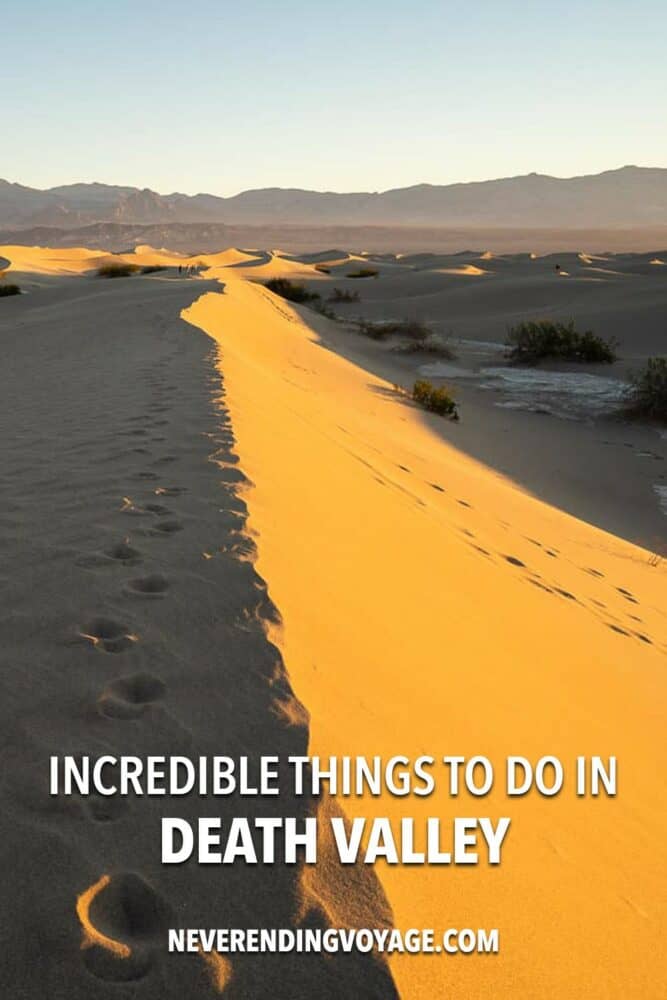
Leave a Reply Cancel reply
Required fields are marked *. Your email address will not be published. By clicking the Submit button, you give consent for us to store your information for the purposes of displaying your comment and you accept the terms of our Privacy Policy .
This site uses Akismet to reduce spam. Learn how your comment data is processed .

6 Must-See Places & Best Things to Do in Death Valley (+Map & Tips)
By Author Jurga
Posted on Last updated: October 25, 2023

Death Valley at the border of California and Nevada is one of the most visited National Parks in the USA . You may have heard that it’s the hottest and driest National Park and that the lowest point of North America can be found here. But there’s so much more to Death Valley than that. And there is more to see and do in Death Valley than it looks at first sight!
In this article, we share some of the most beautiful places to see in Death Valley and the best things to do for first-time visitors.
We only focus on the VERY BEST sites that are worth your time the most if you only have a few hours or a day in Death Valley. If you plan well and – depending on the season – you can easily see them all in a day. Although, spending at least one night here can be a special experience too!
Good to know: All these Death Valley must-sees are accessible in a regular car (so no 4WD is needed). However, some are not accessible for larger vehicles (RVs, motorhomes).
At the bottom of this article, we also included a few additional suggestions for places to visit and things to do in Death Valley if you have more time .
But if you are visiting for the first time and want to see the best that Death Valley has to offer, then this list will help you do just that. Despite covering just 6 sites and a rather small area, you’ll see a big variety of landscapes and jaw-dropping sceneries that will make a long drive to Death Valley more than worth it!
To help you plan your time, we also include a map and practical info , as well as some useful tips for your first visit to Death Valley. Take a look!
Important update for spring 2024: While most of the main landmarks are accessible, some secondary roads in Death Valley NP are still closed due to last year’s flooding. If you are planning a trip soon, be sure to check the official website for up-to-date conditions.
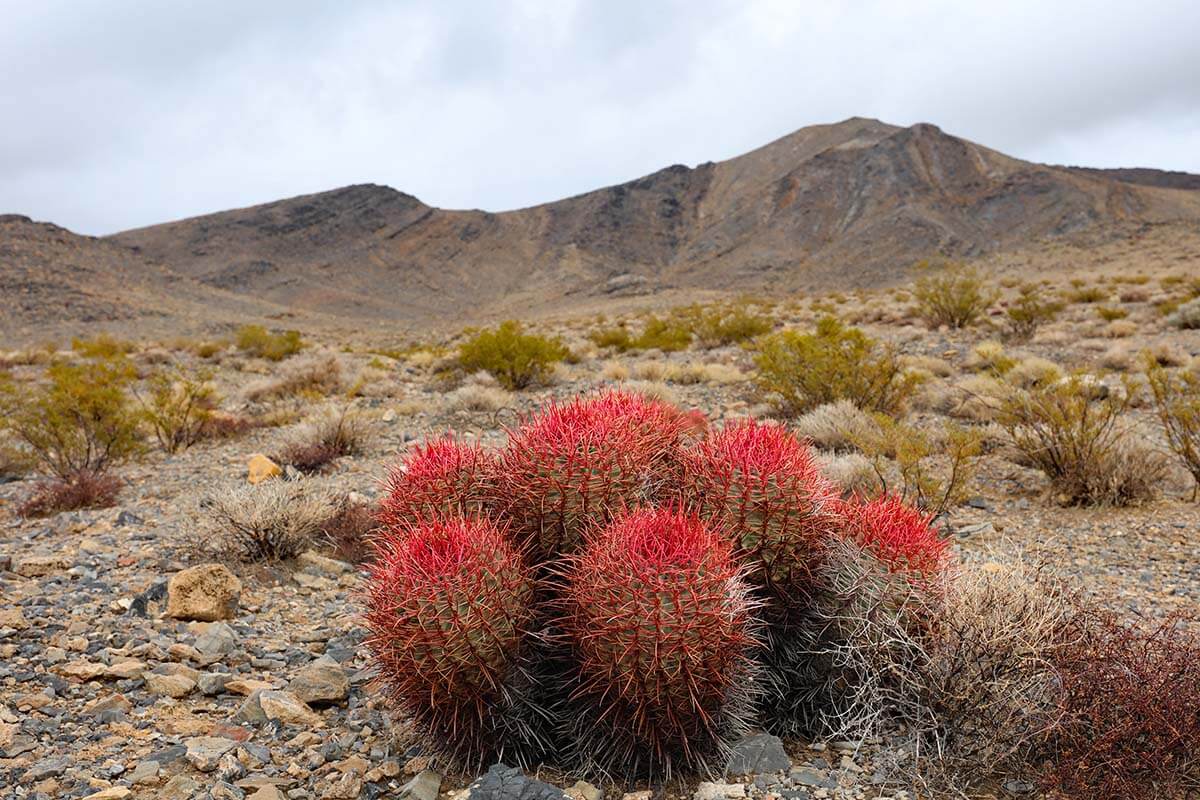
These are the best places to see and things to do in Death Valley:
1. Zabriskie Point
No matter how much time you have in Death Valley – just passing by, visiting on a day trip from Las Vegas, or staying for a few days – Zabriskie Point is not to be missed! This is one of the most beautiful places in Death Valley, with stunning views of multi-colored badlands all around you.
The scenery here is absolutely breathtaking and you can enjoy wide panoramic views of a very large area. This is a desolate and somewhat unearthly landscape, but it looks magical. Golden-brown mudstone hills have distinct shapes, which are formed by erosion and rare but intense water flows.
No two visits here will be the same because all the different shades and tints of color change depending on the light. If you are staying in Death Valley for a few days, consider coming here at different times of the day. Zabriskie Point is one of the nicest places for both – sunrise and sunset in Death Valley.
But there is one more reason why we list Zabriskie Point as number one among the best places to see in Death Valley, and that’s its convenient location and ease of visiting. Located just next to the main road (I-190), the viewpoint is just a short walk from the car. Even though it’s an uphill walk, it’s really not strenuous and takes just a few minutes.
However, if you are visiting Death Valley in the hottest summer months, even this short walk can feel exhausting. Be sure to use sun protection and take some water with you! We once stopped here in July and the moment you step out of the car, it feels like walking into an oven…
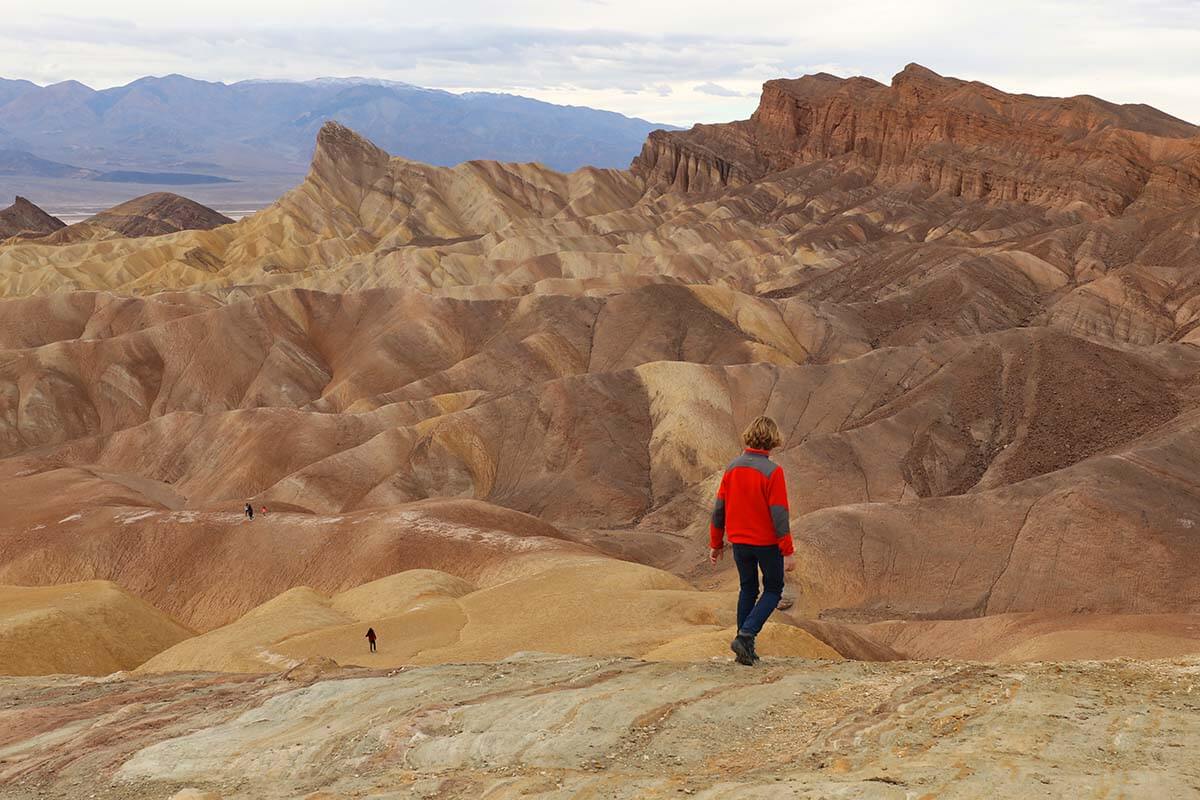
Good to know: Zabriskie Point is one of the most popular places to see in Death Valley. In the peak season (winter months), it can get really busy here.
That being said, we recently visited Death Valley on New Year’s day and had no difficulties finding parking. Also, the area is so big that people spread out beyond the main viewing terrace and it doesn’t feel crowded.
How much time do you need: You can spend as little as 10 minutes here, or you can stay much longer, hike around a bit, etc. The kids love walking up and down these ‘strange’ hills.

2. Badwater Basin
At 282 feet (85.5 meters) below Sea Level, Badwater Basin is the lowest point in North America and one of the lowest elevations on earth. This is the place that made Death Valley famous and is one of the most visited sites in the park.
And indeed, Badwater Basin is absolutely worth a visit. Not just to take a picture of the sign and say ‘been there done that’, but for some of the most unique landscapes you’ll ever see in your life!
Just a few thousand years ago, this place was the site of a 30 ft (9 meters) deep lake. As it evaporated, it left a thick layer of salt. This is what you see here today – a vast salt pan stretching for several miles.
Interesting to know: Badwater Basin gets its name from a surveyor mapping the area. He was glad to find a water pool where his mule could drink, but the animal refused to because the water was too salty. So he wrote on his map “bad water” and the name stuck.
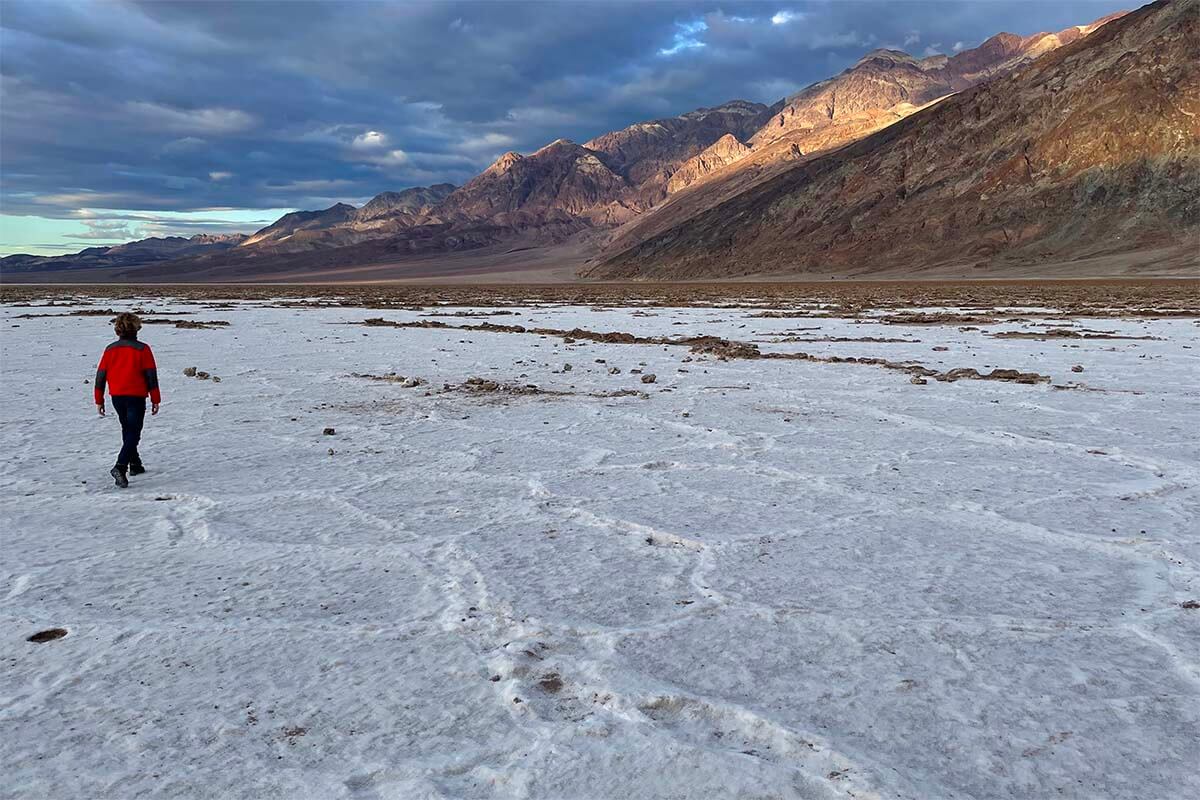
Good to know: Badwater Basin is large, but you shouldn’t just walk anywhere you like. There is a designated parking area (I indicated it on our map). Here, you will find a few boardwalks and a nice straight path leading you to the saltpan.
How much time do you need: If you just want to take a picture of the sign and look around a bit, 10-15 minutes will be enough. However, keep in mind that you have to walk about half a mile in order to reach the main salt pan. If you walk really fast and it’s not too hot, you need about 15 minutes to get there from the car parking. More realistically, you will need 20-30 minutes just to reach it. If you also count the time to look around, take pictures, and walk back, you need about 1 hour for a visit here.
This can be really daunting if it’s hot and I don’t think I would attempt this walk during the day in the summer months… Remember, this is the hottest place in the U.S.!
The good thing is that even if you don’t go all the way, you can see plenty of salt crust closer to the car parking area.
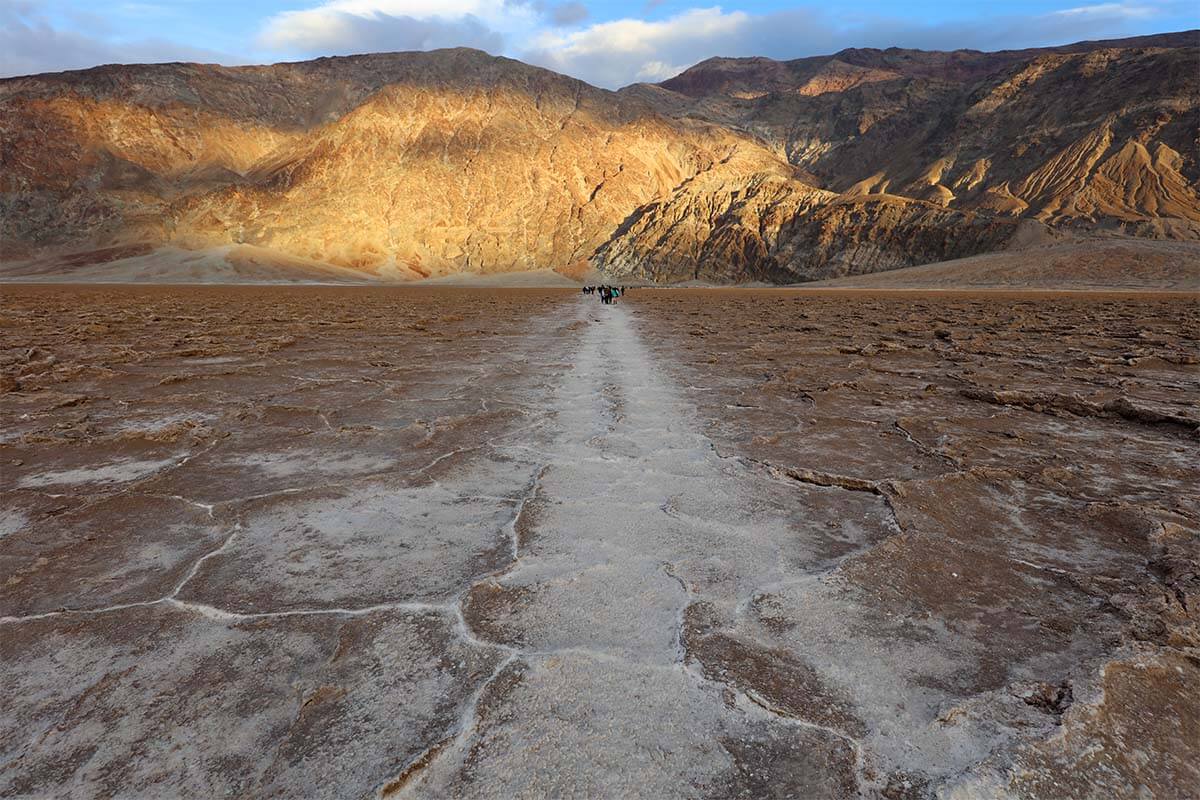
3. Artists Drive & Artists Palette
Artists Drive is another must-see in Death Valley. This is a scenic one-way drive just off Badwater Road. This road is about 9 miles (14 km) long and takes about 20-25 minutes to drive without any stops.
There are a few places where you can stop along the way, but it’s really more about the surreal scenery and the thrill of the drive itself than about the stops. But since you are here anyway, be sure to stop at all the main viewing areas where you can get out of the car and enjoy the colorful scenery around you.
The nicest place here (and one of the must-sees in Death Valley) is Artists Palette , which is the second bigger stop that you’ll come across. Parking is quite limited so you may need some patience.
But the reason why we list Artists Drive so high on this list of top sights in Death Valley is the road itself. With twists, turns, ups and downs, and narrow passages cut out between the rocks, driving here makes you feel like you are part of the unearthly scenery around you.

TIP: Take it slow – not just to enjoy the surroundings, but also for your safety. Also, don’t stop on the road because there are some places where visibility is really limited as you emerge from a sharp corner or drive over a steep hill.
Good to know: Because you don’t even have to get out of the car (or just for a quick photo stop), this is one of the very best things to do in Death Valley in any season. Also in the summer when it’s too hot for anything else, Artists Drive is a great place to visit because you can enjoy it from the comfort of your car.
Important! Please note that cars over 25 feet (7.6 meters) are not allowed on Artists Drive. Even though the road looks perfectly wide at first, there is a good reason for this. The second half of the drive is really not suitable for longer vehicles.
How much time do you need: Count 30-45 minutes for Artists Drive with a few photo stops. Of course, you will need more time if you decide to go for a walk and explore more.
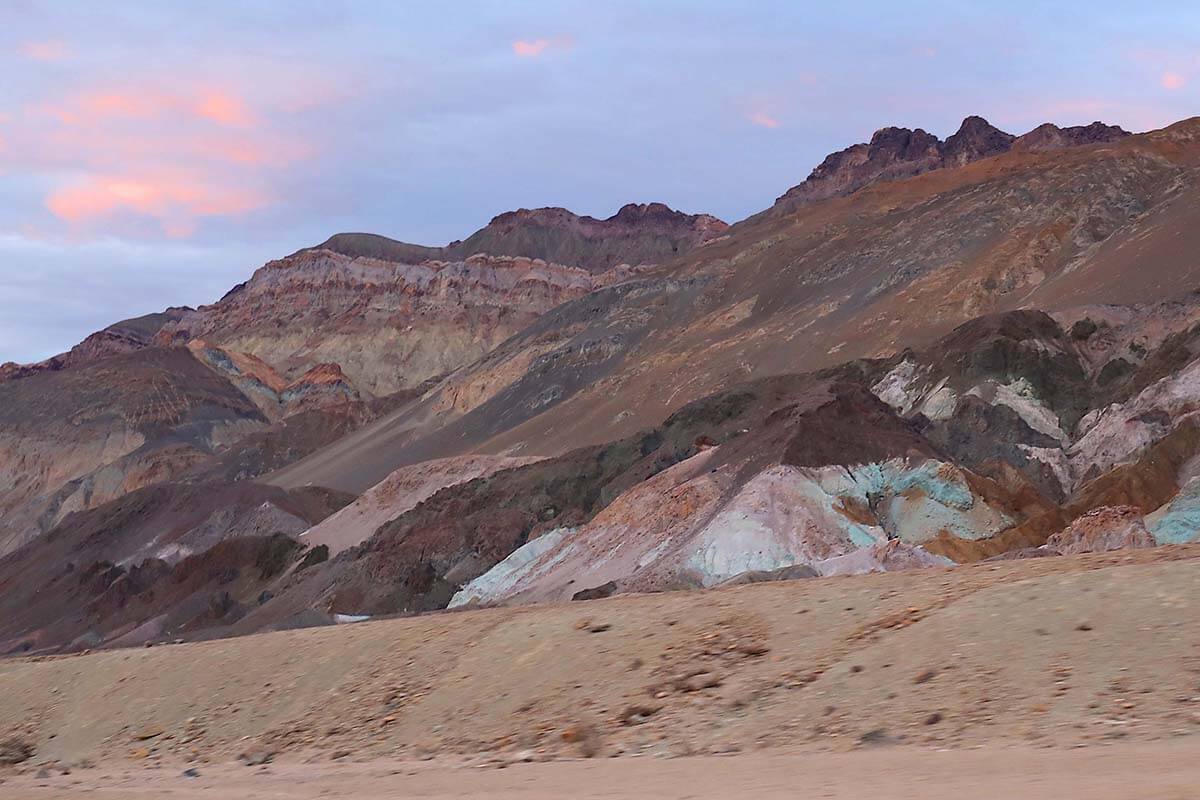
4. Mesquite Flat Sand Dunes
No visit to Death Valley would be complete without at least a quick stop at Mesquite Flat Dunes . Surrounded by mountains on all sides, some of these sand dunes are up to 150 ft (46 m) high.
This is yet another must-see place in Death Valley showing you yet another facet of the incredible diversity of landscapes in this desert park.
Also here, there is a designated parking area, from which you can walk straight into the dunes. The highest dune is about 1 mile from here, but you have to cross lots of sand and smaller dunes to get there, so it’s not a quick walk. Even if it’s not too warm, you should count at least 2 hours round-trip.
But you really don’t have to go that far in order to enjoy the scenery. Even if you just walk 5-10 minutes from the car, it’s a really nice stop on any Death Valley itinerary!
Keep in mind that the sand dunes will look quite different depending on the light. The white sand can turn bright orange with the rising or setting sun.
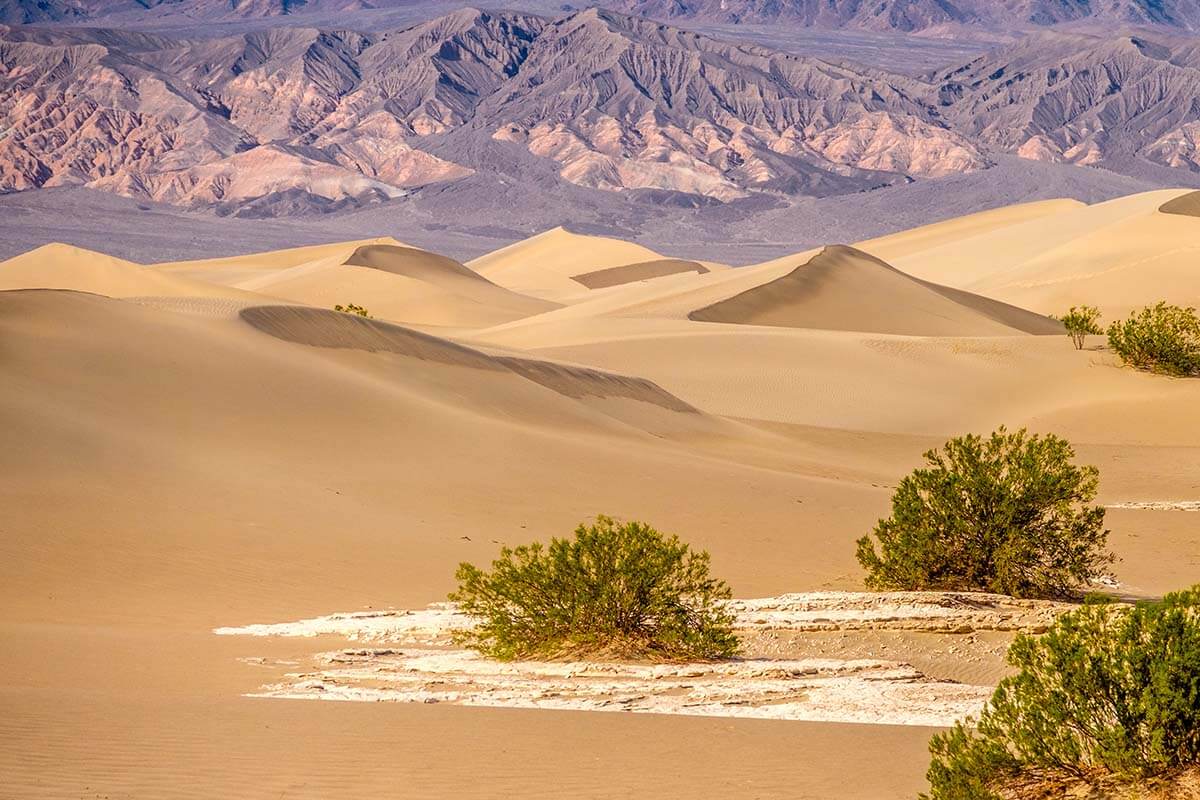
TIP: Sand dunes are spectacular at sunrise and at sunset. These are also the best times of the day to walk around here. It can be very dangerous when it’s hot! If you hike, be sure to do it during the coolest times of the day and carry lots and lots of water.
You can also visit here at night and the dunes are a popular place for Full Moon hikes or stargazing when it’s New Moon. However, be aware that desert wildlife is active at night, so watch out for sidewinder rattlesnakes.
How much time do you need: You can spend 10 minutes here or 2-3 hours – it’s really up to you. Mesquite Flat Dunes are located just next to the main road near Stovepipe Village in the heart of Death Valley, so at least you don’t need much extra time in order to drive here from all the other main sights in Death Valley.

5. Mosaic Canyon
Mosaic Canyon , just near Stovepipe Wells and Mesquite Sand Dunes, is another place that should be high on your Death Valley bucket list. This canyon is a geologic wonder and walking inside it is a really special experience.
While the Mosaic Canyon hiking trail is about 2 miles one-way, you only need to hike about half a mile in order to see the most impressive part of the canyon. And because there is lots of shade from the rocks all around you, this short walk is even doable when it’s warm (but avoid doing any hiking in Death Valley on summer days!).
Good to know: The first part of the trail is rather easy with a few knee-high stones/rocks to climb on the way. However, if you decide to walk beyond the narrow part of the canyon and all the way to the end, be prepared for some serious scrambling (you really need good hiking shoes!).
Because the trail goes a bit uphill, it takes more time to get there than to come back. We explored just the narrow part of the canyon and stopped where it got really wide. We walked for 20 minutes to get there and just 10 minutes to get back.
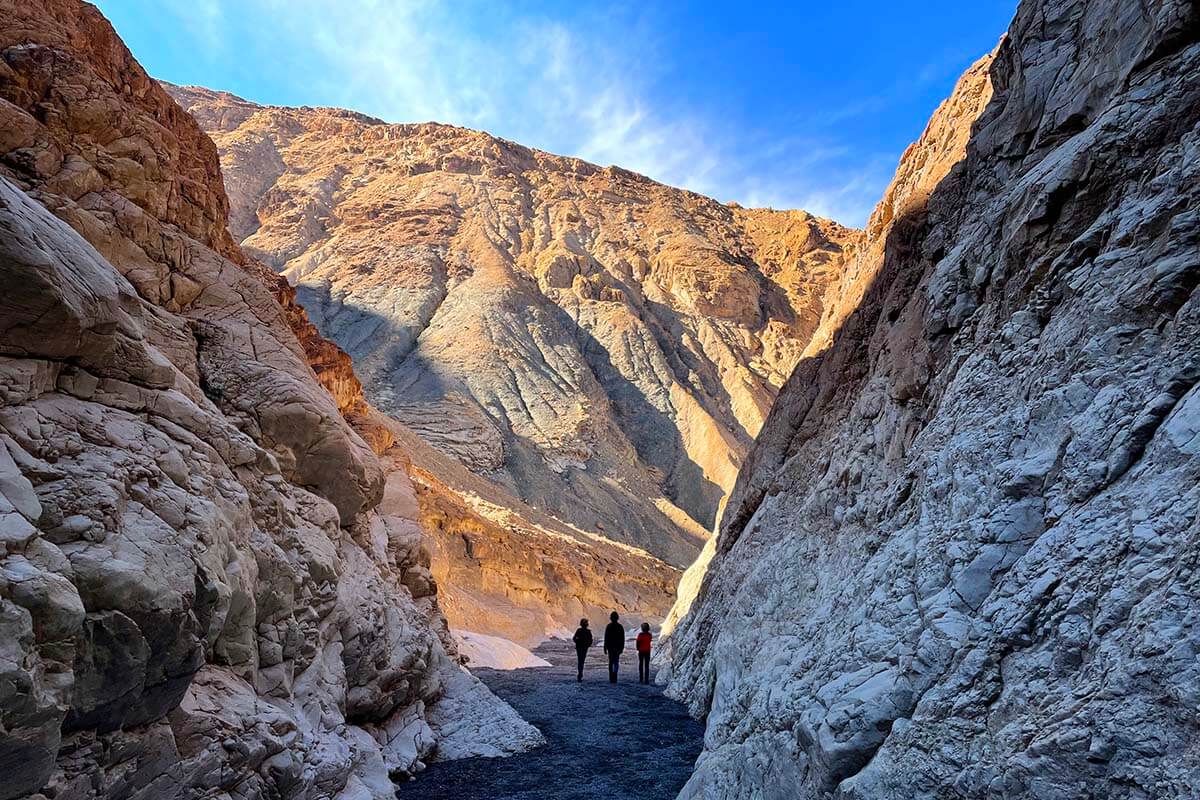
How much time do you need: If you only walk about half a mile, you need about 30 minutes for a visit here. If you decide to hike the entire trail (only recommended in winter), it can easily take 3 hours or even longer depending on the temperatures and your condition. Also here, be sure to pack plenty of water!
It’s important to note that you have to drive the 2-mile Mosaic Canyon Road in order to reach the trailhead. This is a pretty rough gravel road. We saw a few regular cars here, but an SUV or a 4×4 would be better here.
Also, don’t count on GPS or Google Maps for guiding you here. But Mosaic Canyon Road is really easy to find – it’s just southwest of Stovepipe Wells. I indicated this road on our map below to help you find it.
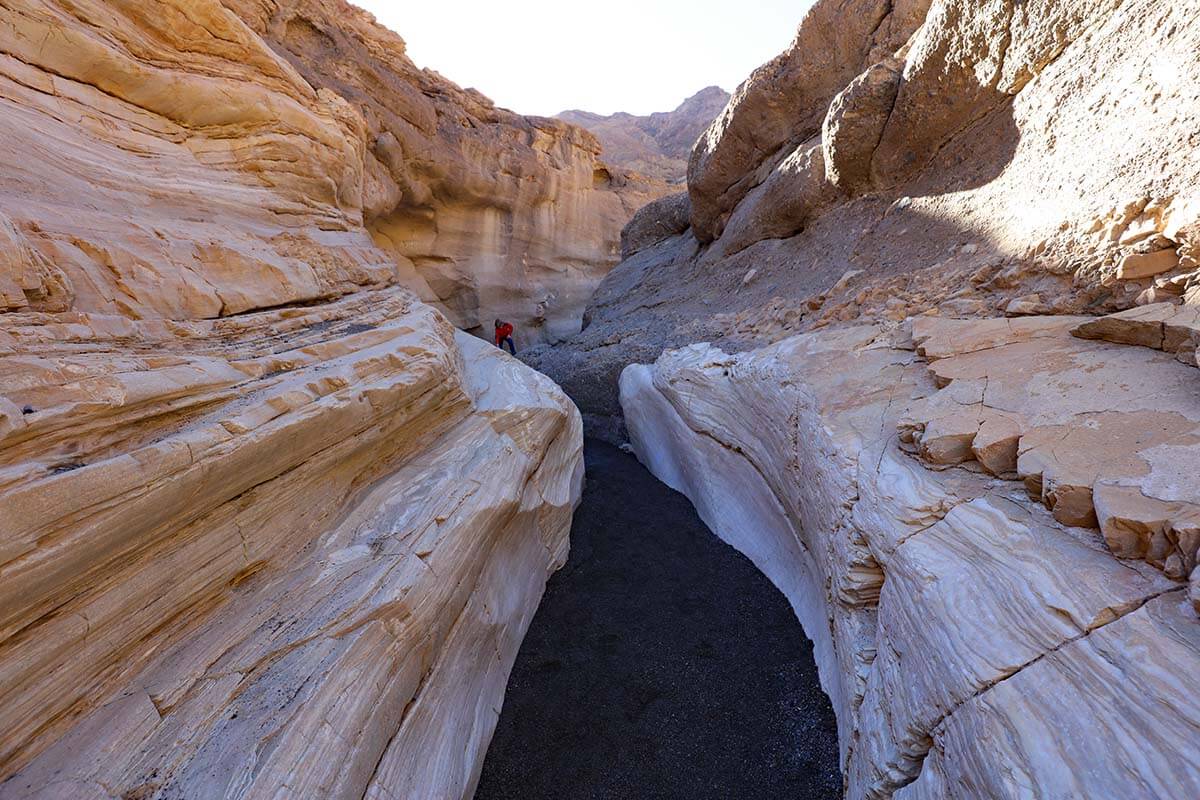
6. Dante’s View
One of the highest easily-reachable viewpoints in the park, Dante’s View is a lookout point offering stunning aerial views of Death Valley. From here, you can see mountain ranges and flat desert valleys stretching for over 110 miles.
The scenery here is truly impressive, giving you an even better appreciation of how much diversity there is in Death Valley.
There is a large car parking and viewing area, so you can see great views without having to walk much at all. However, if it’s not too hot (or too cold and too windy as it was when we visited), you can also climb Dante’s Peak, to the right of the parking. It’s about 10-15 minutes hike to the top and the views should make up for it.
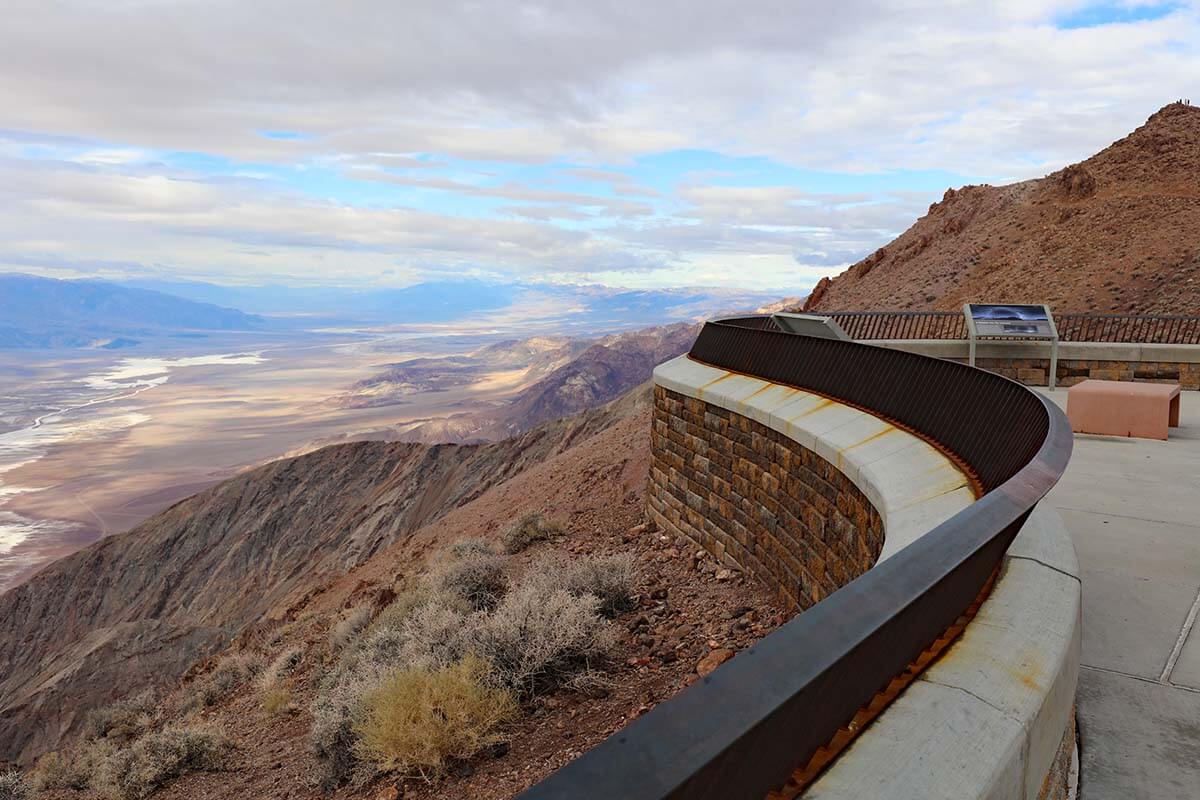
Interesting to know: Towering just above the Badwater Basin, Dante’s View is 5,000 feet higher than the valley floor. That’s a huge difference, not just in terms of elevation or scenery, but also in terms of temperature!
When we were here in January, it was FREEZING cold at Dante’s View with temperatures of just 39 F (4°C) and such a strong wind that we could hardly stand on our feet. We needed winter jackets, gloves, and hats just to walk around at the viewpoint, not even to mention attempting a hike to the peak. In the meantime, it was 65 F (18°C) at Badwater Basin and we ended up in t-shirts after a walk…
How much time do you need: Dante’s Peak is located 13 miles south of Hwy 190. It’s quite a big detour to get here, and driving alone will take you at least 20 minutes one-way. In addition, if you just stop at the viewpoint, you should add about 10 minutes. If you also hike to the lookout on top of the hill, add at least 20-30 minutes extra. Obviously, you will need more time if you decide to do even more hiking in the area.
So realistically, you need at least 1 hour for a visit here. But it’s totally worth it!
Good to know: Also here, the last part of the road is prohibited for vehicles over 25 ft (7.6 m). You can leave your RV/motorhome at the parking lot and walk the last bit, but whether you would want to do this, depends on the temperatures.
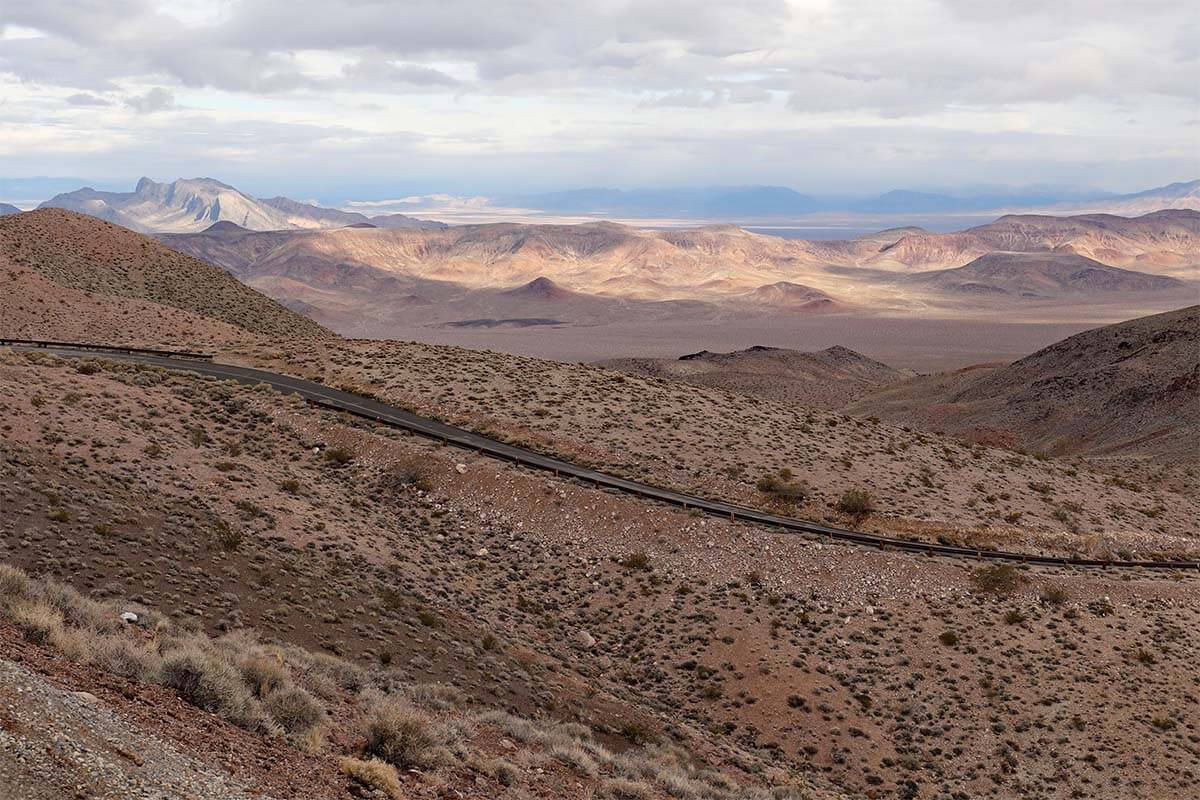
Now that we covered the must-sees in Death Valley, here are a few additional recommendations for places to see and things to do if you have more time.
More Places to See & Things to Do in Death Valley
Stretching over 3.4 million acres (almost 14,000 sq km), you can imagine that there is a lot more to see and do in Death Valley National Park than just the 6 top places mentioned above.
There are countless hiking trails, ghost towns, gold and borax mines (it’s not the best idea to visit them inside though), sliding rocks, and even hot springs and golf (!)…
However, most visitors don’t have the time to explore more, and often it’s simply too hot as well.
Anyway, if you have more time and are looking for more things to do in Death Valley , here are a few additional suggestions.
Ghost towns, machinery, and the remains of the old mining operations
- Harmony Borax Works. This is an old mining operation where you can still see some remains of machinery and buildings from over 100 years ago. It’s a short interpretive trail close to the highway and makes a nice stop just a short drive north of Furnace Creek.
- Furnace Creek. At Furnace Creek, just behind the general store, you can also find some old machinery and interesting objects from the mining days at Death Valley. There is an old train, carts, etc.
- Wildrose Charcoal Kilns. These are old ‘ovens’ used to produce charcoal. They look like cute little houses and make for some nice photo opportunities. However, it’s quite a bit of a detour. Also, the last few miles of the road are a bit rough. When we visited in the winter, we had to skip this because rangers told us that snow chains were needed because of recent snowfall (yes, also this is Death Valley!).
- Ghost towns. In the past, Death Valley had lots of mining sites with small towns built around the mining activity. Today, you can visit some of these ghost towns (Ballarat, Leadfield, Panamint City, Rhyolite), but their conditions vary. Some of them have old dwellings and machinery, but there are also a few where there’s hardly anything left…
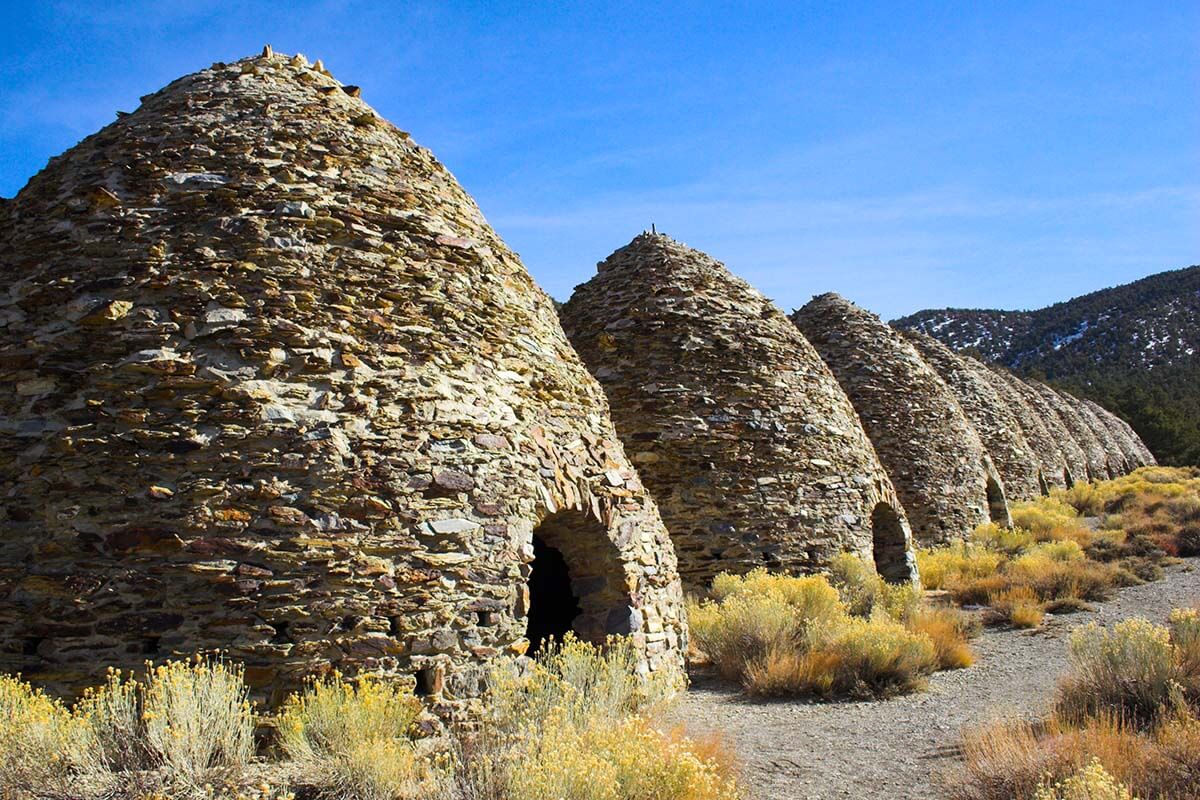
Scenic Views
- Devil’s Golf Course. Crystalized salts have formed some very strange jagged formations, sort of small salt spires. If you want to see some more unique scenery in Death Valley, this can be a nice quick detour on your way to Badwater Basin.
- 20 Mule Team Canyon. This scenic area is located right on I-190 just before you reach Zabriskie Point. There is a short gravel road that takes you into the canyon, which is quite nice (a high-clearance vehicle is recommended, but some people seem to do it in a regular car too). Since it’s a loop road, you get back on the main road again soon. Most people just park next to the main road and walk around a bit.
- Ubehebe Crater. This is a really impressive crater and you can see it straight from the parking area. However, it’s located in the northern part of Death Valley, quite a bit out of the way from the main attractions.
- Father Crowley Vista Point- Rainbow Canyon. This is a nice viewpoint to check out if you find yourself on the western side of Death Valley (e.g. if driving to/from Los Angeles or Sequoia NP).
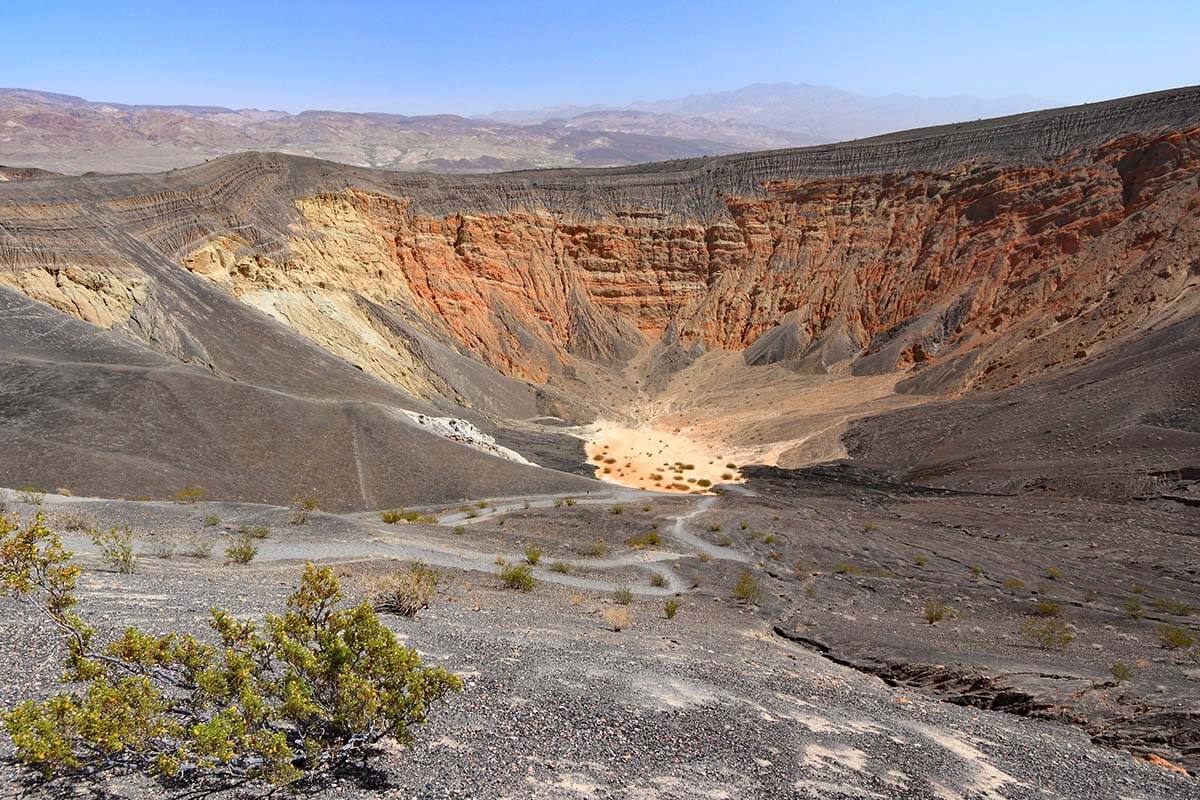
Active things to do at Death Valley National Park
- Horseback riding. There are several places where you can go horseback riding in Death Valley. Especially in the winter months, this can be a great experience and a nice, easy way to explore more surreal landscapes. One of the best centrally-located horse stables can be found at Furnace Creek (next to The Ranch/Oasis Resort ). They offer 1 or 2-hour rides.
- Biking. If you like slow travel, you can also explore Death Valley by bike. Among several other places, rental bikes are available at the above-mentioned resort at Furnace Creek. You can choose between regular road bikes or e-bikes and rent them for half a day, a day, or even a few days. I’d only recommend this if you are visiting in the winter and have plenty of time. There are also bike tours available – you would have to do some additional research on that if interested.
- Swimming. Death Valley has several hot springs. However, most of them are located further away from the main area with the most interesting sights. Anyway, the best places to go for a swim are The Inn At Death Valley and The Oasis/The Ranch Resort at Furnace Creek. Their pools are filled with spring-fed warm water. We were here at New Year and the outdoor pool was warm enough for a swim. It’s not hot though, so perfectly enjoyable in the warmest months as well. However, the pools are only accessible to hotel guests. Another (very simple) accommodation with hot springs is Delight’s Hot Springs Resort in Tecopa, just outside the southeast corner of the park, close to Shoshone.
- Golf. In addition to Devil’s Golf Course (which is obviously not a golf course at all), there is an actual golf course in Death Valley as well. You can find it at Furnace Creek. It’s a bit surreal to see green grass in the desert, but avid golfers will enjoy playing golf on the lowest-elevation course in the world. In the summer, you have to start at 6-7 am or it gets too hot!
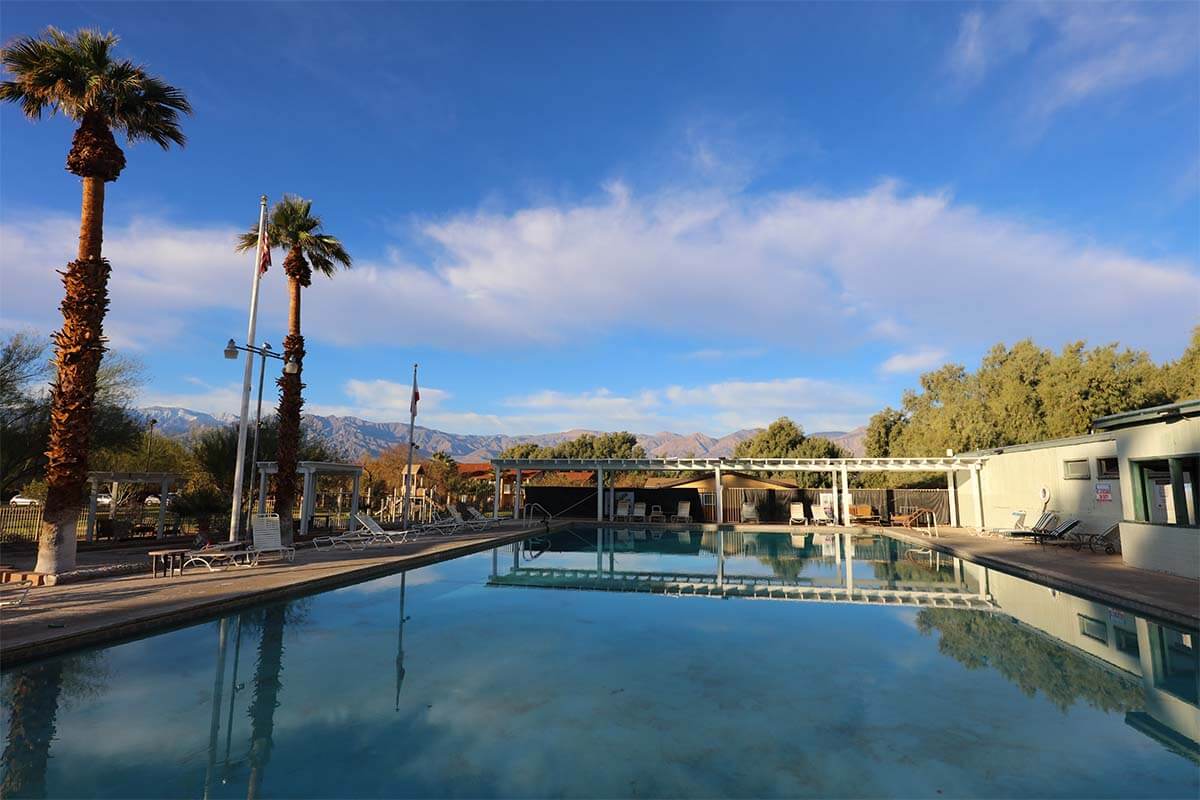
To help you get a better idea of where everything is located, we created this map indicating all the sites mentioned in our article.
As you can see, all the very best places to visit in Death Valley are located rather close to Furnace Creek, in the center of the park.
This area is just a bit over 2 hours away from Las Vegas and so it’s possible to see these top sights in a day (by car or with an organized tour ). In fact, this is one of the best day trips you can do from Vegas !
How to use this map: Use your computer mouse (or fingers) to zoom in or out. Click on the icons to get more information about each place. Click the arrow on the top left corner for the index. Click the star next to the map’s title to add it to your Google Maps account. To view the saved map on your smartphone or PC, open Google Maps, click the menu and go to ‘Your Places’/’Maps’. If you want to print the map or see it in a bigger window, click on ‘View larger map’ in the top right corner.
Practical Information
- Death Valley is the dryest and hottest place in the USA. If you are visiting in the summer, your feet can literally start to burn through your shoes! So adjust your expectations and itinerary based on the season when you visit and don’t do stupid things like hiking in the middle of the day in the summer. Also, always carry plenty of water !
- There is a fee to visit Death Valley and you can get a pass at the visitor center (so not at the entrance of the park). If you have the annual National Parks Pass ( America the Beautiful Pass ), it’s also valid here.
- Death Valley has limited facilities , but you can find fuel and food stores here too. However, everything is very expensive here. It’s best to fill up your tank before you arrive, and you may also want to bring your own snacks/picnic. This will save you money, but also time.
- Because of its size and limited facilities, you need a car (or a motorcycle/RV, etc.) in order to visit Death Valley.
- While the main roads in Death Valley are really good, many side roads are unpaved and in varying conditions. It’s always a good idea to check if your rental car insurance covers gravel roads (most don’t) and it’s even more important to ask park rangers for up-to-date information about the specific places you plan to visit! Also, driving off-road is forbidden!
- When planning your sightseeing at Death Valley, keep in mind that in summer it’s very hot during the day and you won’t be able to do much after 10-11 am. And in winter, the days are short and it gets dark very early (it’s pitch dark from +- 5 pm around New Year).
- You can visit Death Valley in 1 day from Las Vegas , but it’s a long drive (and lots to see when you get there). So be sure to leave early so that you can make the most of your time. If you are only coming for a day from Vegas, consider booking an organized tour . They will bring you to all the top spots in the most efficient way and you’ll be able to rest on your way there and back.
- If you want to, you can spend a night here (or a few, depending on what you want to do). The most conveniently located hotels are The Oasis Resort (aka The Ranch) and The Inn At Death Valley (former Furnace Creek Inn). They are both beautiful resorts with all the amenities you might need. But – like everything else in Death Valley – quite pricey. We stayed at The Oasis/The Ranch when road-tripping between Las Vegas and LA and it allowed us to explore everything at a slower pace.
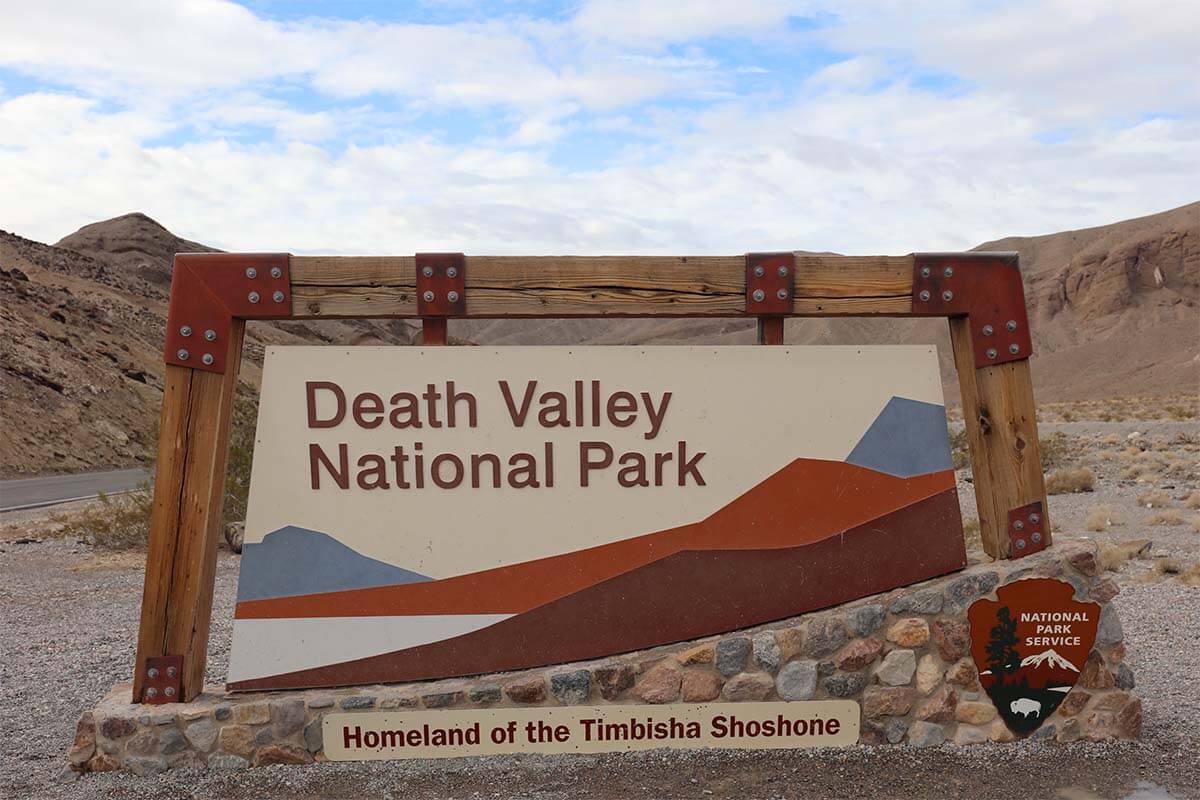
I hope that this guide gives you a better idea of what to expect and what to see in Death Valley National Park. Have a great trip!
TIP: If you are road-tripping in Southwestern USA , you may want to check our other travel guides to a big variety of destinations in the region. Take a look via the links below!
- Best things to do in Las Vegas
- One day in Las Vegas itinerary
- Las Vegas travel tips
- Best day trips from Las Vegas
- One day in Grand Canyon
- Where to stay in Grand Canyon
- Grand Canyon South Entrance
- Grand Canyon in Winter
- Top places to see in Arizona
- Best things to do in Sedona
- Sedona day trip from Phoenix
- Monument Valley
- Grand Canyon – Antelope Canyon – Horseshoe Bend itinerary
- Arches and Canyonlands National Park 1-day itinerary
- Moab itinerary
- Zion – Bryce Canyon itinerary
- Phoenix – Scottsdale Itinerary
- LA Itinerary
- San Diego Itinerary
- Best things to do in Arches National Park
- Best things to do in Canyonlands National Park
- Best hikes in Zion National Park
- Where to stay in Zion National Park
If you found this post useful, don’t forget to bookmark it and share it with your friends. Are you on Pinterest? Pin these images!
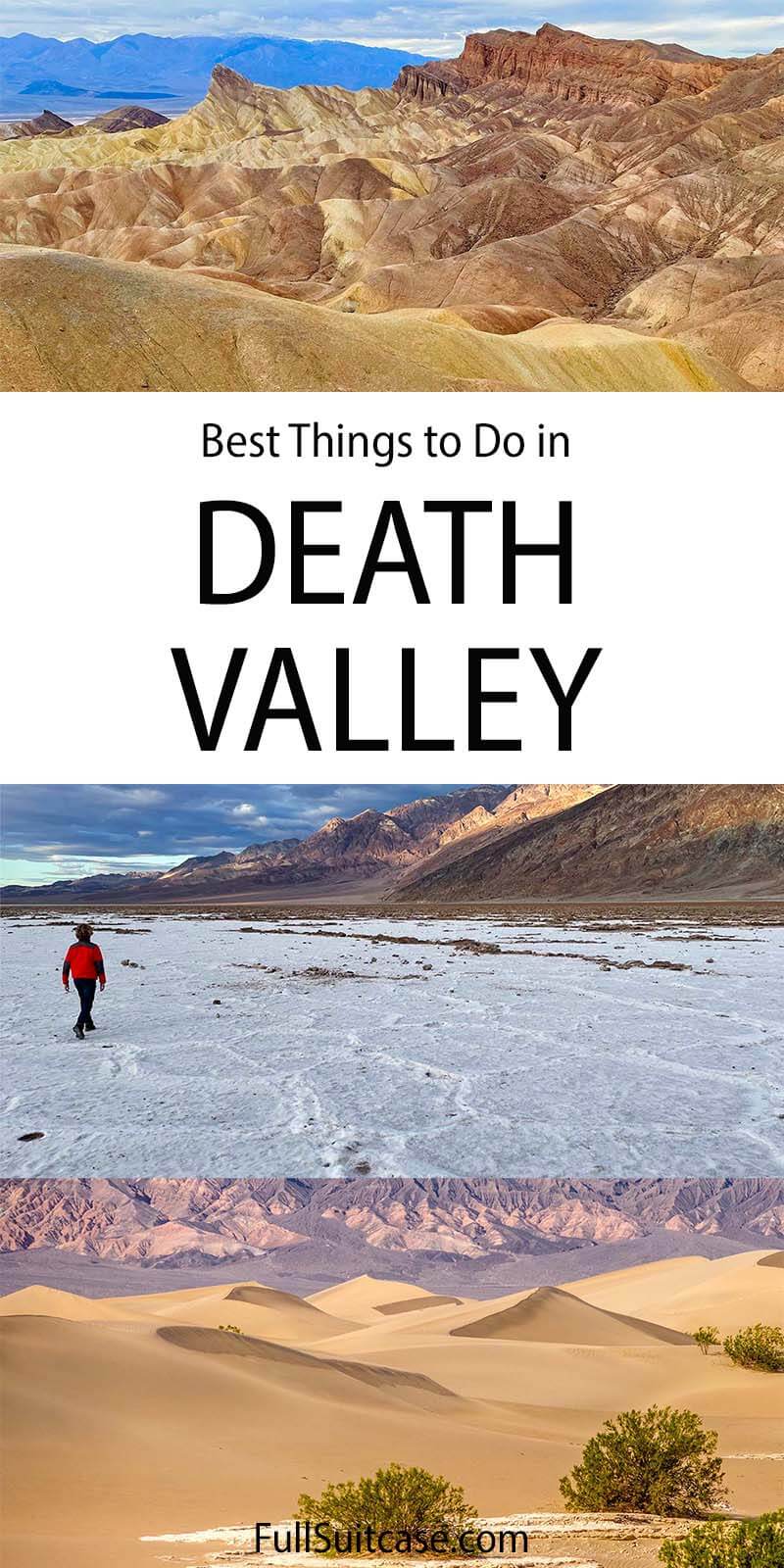
More travel inspiration for USA National Parks:
- Best Things to Do in Yellowstone
- Grand Teton – Yellowstone Itinerary
- Yosemite Travel Tips
- Glacier National Park Itinerary
- Rocky Mountain National Park Itinerary
- Olympic National Park Itinerary
- Acadia National Park Itinerary
- Yellowstone National Park Itinerary
- North Cascades National Park
Seasonal guides:
- National Parks to Visit in January
- National Parks to Visit in February
- National Parks to Visit in March
- National Parks to See in April
- National Parks to See in May
- National Parks to Visit in June
- National Parks to Visit in September
- National Parks to Visit in October
- National Parks to Visit in November
- National Parks to Visit in December
This site uses Akismet to reduce spam. Learn how your comment data is processed .
- Destinations
- Backpacking
- Caving & Spelunking
- Guided Tours
- Luxury Resorts
- On The Water
- Scuba Diving & Snorkeling
- Camping & Backpacking
- Environmental Impact
- Conservation

3-Day Vegetarian Backpacking Meal Plan Ideas

Adventurous Things To Do In Belize
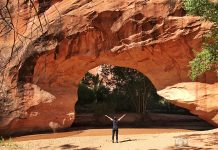
Best Grand Staircase Escalante Hikes
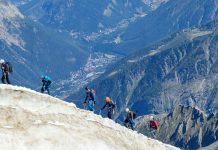
How to Train for High Altitude Hiking
- Death Valley
Guide to Visiting Death Valley
Foreboding, desolate, isolated, and brutally beautiful; Death Valley in the largest national part in the continental US at 140 miles long and 15 miles wide. It is the lowest, hottest, and driest area in North America and with a wide variety of unusual topography and landscapes, Death Valley is desert beauty at it’s absolute best.

I was surprised at how different the northern and southern regions of the valley are from each other. They each have a lot of different landscapes to offer. The northern region is much more isolated and far less crowded, which is more of what I was expecting Death Valley to be like, whereas the southern region has more diversity and the attractions that Death Valley is famous for, which also means more crowds of tourists… just something to keep in mind when planning your trip.
Table of Contents
Why Is It Called Death Valley
Death Valley was named by a group of pioneers known as “The Lost ’49ers” who were lost here in the winter of 1850. They all assumed that they were going to die here in the valley, which was barren with no water and seemed to be never ending. Two of the younger men, William Lewis Manly and John Rogers, lead the pioneers out of the valley over the Panamint Mountains. The story goes that as they left, one of the men looked back, and said “goodbye, Death Valley.”
Where Is Death Valley Located?
Death Valley is located on the California/ Nevada border in Inyo County, California between the arid Great Basin and Mojave deserts. It’s just east of the Sierra Nevada Mountains (which is really beautiful if you’re entering/exiting the park in that direction).
From Los Angeles : 4.5 hrs; Take 14 North out of Los Angeles (from the 101N, to the 170N, to the 5N). You’ll be on 14N almost the entire way. Follow it for 115mi and then go left on 395N. Follow 396 for 74 mi and turn right onto 190E, which will take you into the park. Do not get gas at the station in Panamint Springs just outside the park. It’s $0.70 more expensive than the gas inside the park.
From Las Vegas : 2.5hrs; Take 95N out of Vegas. Follow this for 87 miles and then left onto 373S. Follow this for 23mi and then turn right onto 190W, which will take you into the park.
From Sacramento : 8hrs; Take 50E for 93mi. Turn right onto 89S and follow it for 29mi crossing into Nevada. Turn right onto 395S and follow it for 150mi. If you have a 4×4, you can enter the northern part of the park near Big Pine via Death Valley Road, which is off of Rte 168, just past Zurich. If not, follow 395S for another 58mi and then take a left onto 136E at Lone Pine. Follow for 17mi and then go left on 190E, which will take you into the park. Do not get gas at the station in Panamint Springs just outside the park. It’s $0.70 more expensive than the gas inside the park.
When Is The Best Time To Visit Death Valley?
Early spring or late winter . Death Valley gets extremely hot over the summer – by May temperatures get into the 100s during the day, and with no shade, you’re at the mercy of the sun. During the late winder/ early spring is ideal. The temperatures during the day are in the low 80s and at night the low 50s (tho it may sometimes dip to the mid 30s).
Getting Around
The popular attractions and tourist areas are accessible with a regular car as most of these roads are paved. But, if you really want to see Death Valley, you’re going to need a 4 wheel drive vehicle .
Pro Tip: Gas is cheaper at Stovepipe Wells than at Furnace Creek. Gas prices are comparable to standard CA prices. Do not get gas at Panamint Springs (just outside the park) – the gas station here is $0.70/ gallon more expensive than inside the park.
Jeep 4×4 Rentals
The majority of the valley (including the entire northern region) is accessible only via dirt roads of a various quality levels. Even the “packed” dirt roads will take a toll on a regular vehicle and there is little to no cell service in pretty much the entire park, so you do not want to get stuck!

You don’t want to be this guy: On the road to the Eureka Sand Dunes (10 mile packed dirt road), we stopped to help an Audi sedan with a shredded tire on the side of the road. They had already used their spare tire to replace a flat earlier . It was 1pm and they had been stuck there overnight even though they had already gotten a call out and a tow-truck was on its way… due to be there within the next few hours (we passed it turning in as we were exiting). In this case, a regular SUV would probably have solved the problem, but the “not well maintained” dirt roads absolutely require 4 wheel drive, so why risk it and end up like this guy?
So if you don’t have a 4×4, rent one! Unfortunately traditional rental car facilities (such as Hertz, Enterprise, etc.) don’t guarantee 4wheel drive – believe me, I called all of them when trying to get a car. There’s always that “or similar” clause that allows them to give you whatever “similar” car they currently have in their inventory at the facility – and they don’t guarantee that it will be 4wheel drive.
So, instead you can rent from:
- Farabee’s Jeeps – located at Furnace Creek within the park. $296.71/day, 200 Miles included per day, $0.50 every additional mile
- Better option: : TURO ! $50- $70/day, unlimited miles – this is what we did and it worked out great! It’s basically AirBnB but for cars. You’re renting a specific car of your choosing and you can add-on insurance just like any other rental. We did this in our home town before leaving and even with the extra $100 we spent in gas getting here, it was still cheaper!
Get a Rental From TURO Here
Pro Tip: Pay attention to the mileage limitations before booking. If you’re going on a long trip, make sure to get a car that allows for unlimited miles!
Bicycle Rentals
During our visit there were also a lot of people who were cycling around the more popular attractions on the paved roads. While this is a bit annoying as a driver, I’m sure its beautiful to cycle if it’s not too hot. The general store at the Ranch at Furnace Creek rents 24-speed mountain bikes.
Places to Stay
Where to stay in Death Valley depends on how adventurous you want to be. I’m always an advocate for camping, but during the summer it gets so hot and brutal here, you will need some shelter (which is why I would recommend finding a shady canyon off a dirt road somewhere and sleeping in your 4×4!).
Pro Tip: If you’re outside, be prepared for it to get windy! The winds can come up at a moment’s notice and will sometimes blow all night.
There are only three hotels actually inside the park. They are often sold out far in advance and are rather pricey. If you don’t mind staying outside the park, it will definitely save you a few bucks – in some cases up to $300/night! Pahrump NV and Lone Pine CA are the closest big towns and each have a few options (remember you’re in the middle of no where), in addition to the ones below:
Inside The Park
- Stovepipe Wells Village Hotel – Ave: $150/night
- The Oasis Inn at Death Valley – Ave: $300/night
- The Oasis Inn at Death Valley – Ave: $500/night (but it’s super cute and a true “Oasis”)
Just Outside The Park
- Amargosa Opera House – Ave: $90/night
- Death Valley Inn Motel & RV Park – Ave: $90/night
- Longstreet Inn Casino & RV Park – Ave: $100/night
- Panamint Springs Resort – Ave: $90/night
- Shoshone Inn – Ave: $125/night
- Delight’s Hot Spring Resort – Ave: $100/night
There’s a bunch of really cute places just outside the park that are available on AirBnb for around $50-$80/night. Also a lot of these places will give you more of a taste of the local culture, such as staying in an airstream trailer!
Campgrounds & RV Sites
The majority of the official campgrounds are in the center of the park near Furnace Creek. Campgrounds are open year round and are first come first serve unless otherwise noted. There is no shade in these campgrounds and they’re located on flat packed dirt. You can also choose to camp in the backcountry rather than a campground (see below) just by driving to an area that you think looks good.
Campfires : As a national park, all vegetation is protected, so you either need to bring your own firewood or buy it from one of the general stores. Fires can only be made in designated fire pits and are prohibited during the Summer (June- Sept). All stoves and grills must be gas burning.
- Furnace Creek Campground – reservations available and often sold out – $22
- Stovepipe Wells Campground – Open Sept 15 to May 10 – $16
- Texas Spring Campground – Open 11/13 to May – $16
- Sunset Campground – Open November to May – $14
- Mahogany Flat Campground – Open March to November – free, 4×4 required
- Thorndike Flat Campground – Open March to November – free, 4×4 required
- Emigrant Campground – tents only – free
- Wildrose Campground – free
- Mesquite Spring Campground – $14
- Eureka Sand Dunes – not listed on NPS website, but its on their map and there are fire pits and bathrooms available. 4×4 required.
- Warm Springs – not listed on NPS website, but its on their map and there are fire pits and bathrooms available. 4×4 required.
- Homestake Dry Camp – not listed on NPS website, but its on their map and there are fire pits and bathrooms available. 4×4 required.
Backpacking & Backcountry Camping
Death Valley has over 3 million acres of wilderness and almost 700 miles of backcountry dirt roads that are open to camping. You get pick up a free voluntary permits for backcountry camping at the visitor center or any ranger station.
Rules for backcountry camping:
- No campfires. Stoves and propane grills are allowed.
- You can camp along dirt roads at least one mile away from any paved road or “day use only” dirt road (this applies to the first 8 miles of Cottonwood Canyon).
- Camp only in previously disturbed areas to minimize impact.
- Campsites must be more than 100 yards from any water source
2022 Death Valley Entrance Fees & Permits
If you plan on visiting a lot of National Parks, I recommend getting an America The Beautiful Park Pass . The pass allows you to enter every National Park in the US for one year for just $80.
There is no entrance gate for Death Valley. Park entry fees can be paid at the ranger stations or at any of the self-pay facilities around the park.
- Individual (on foot or bicycle) – Good for 7 Days: $15
- Motorcycle – Good for 7 Days: $25
- Automobile with up to 4 people – Good for 7 Days: $30
- Death Valley Annual Pass – Good for 1 Year: $55
Permits : You get pick up a free voluntary permits for backcountry camping at the visitor center or any ranger station. No other permits are needed for camping, but each campsite does have a fee (see above).
Things To Do
There’s SO much to do here it’s really hard to put everything onto one map, but we’ve tried! Here’s a collection of everything listed on the NPS site plus some extra stuff I found through my own research… all on one nifty interactive map so that you can put together a kick-ass itinerary based on your planned trip route!
Pro Tip: The only places you can expect to have a small amount of cell service is at Stovepipe Wells and Furnace Creek. Plan ahead and know where you’re going (screenshot the map if necessary), you won’t be able to rely on your phone for directions! Here is a printable map .
- Places With a View (red binocular marker)
- Attractions (red camera marker)
- Sand Dunes (red mountains/dunes marker)
- Ghost Towns, Ruins, & Mines (red castle marker)
- Scenic Drives (red car marker)
- Hiking (green markers)
- Easy Hikes (yellow-green hiking marker)
- Moderate Hikes (light green hiking marker)
- Advanced Hikes (emerald green hiking marker)
- Backpacking Hikes (blue-green two hikers marker)
Places With a View
Dante’s view.

Zabriskie Point

Father Crowley Point

Aguereberry Point
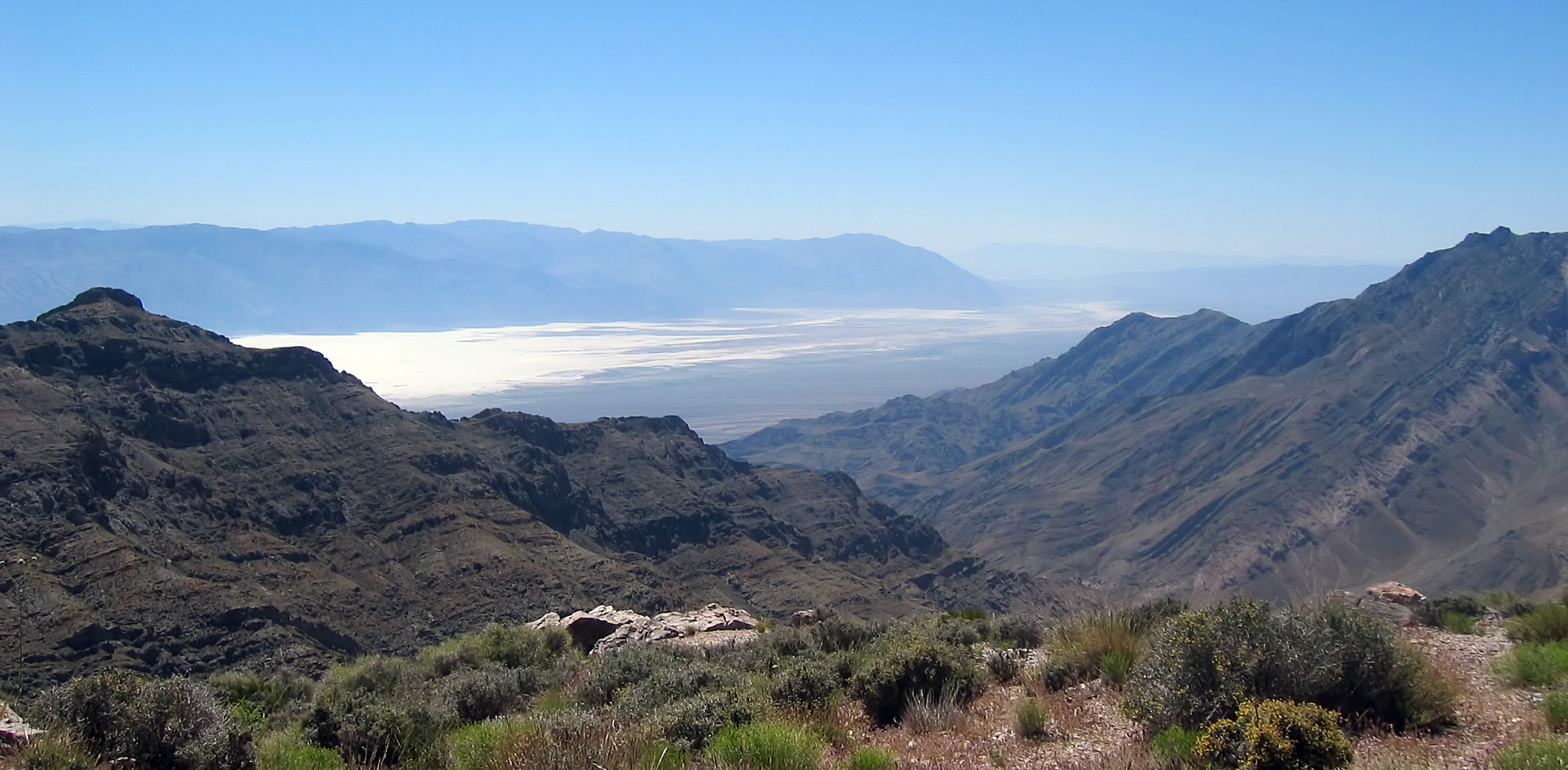
Ubehebe Crater
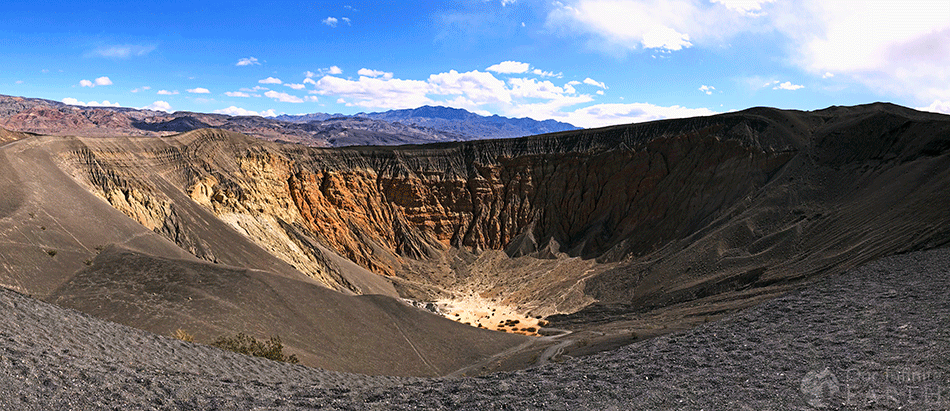

Attractions
Badwater basin.
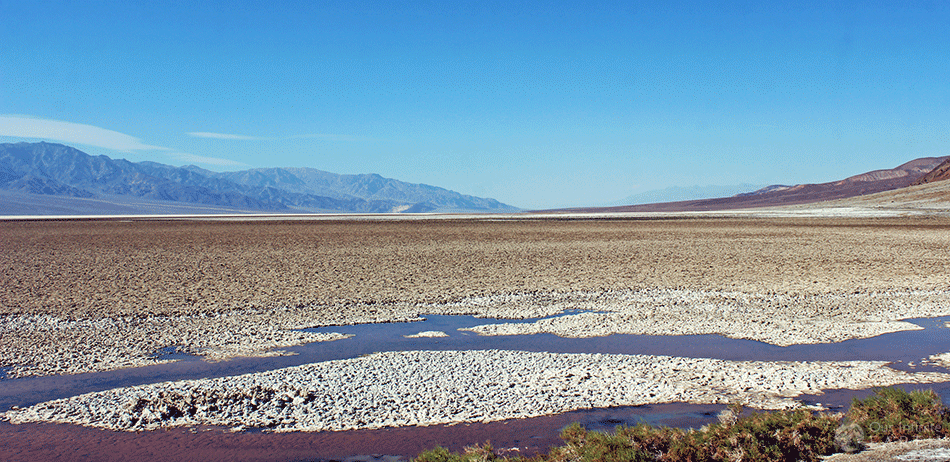
Devils Golf Course
Racetrack playa.
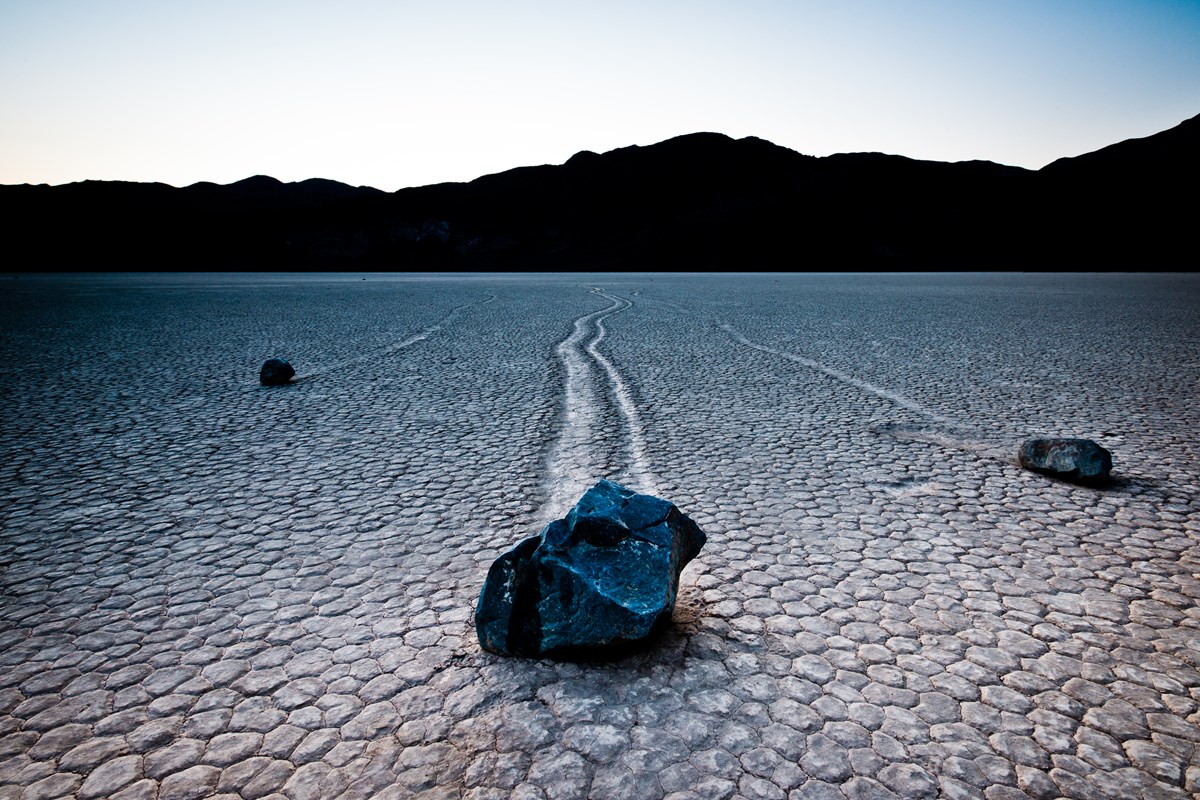
Joshua Trees

Saline Valley Warm Springs
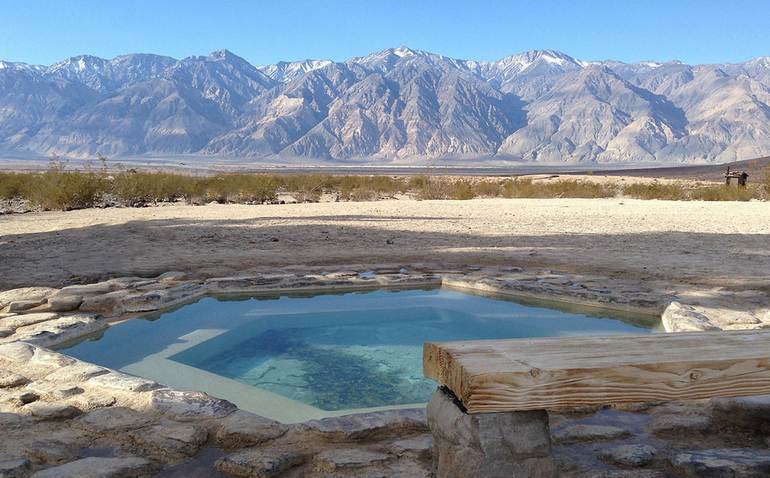
Marble Bath of Saline Valley

Saratoga Spring

Devil’s Corn Field
Mesquite Flat Sand Dunes

Eureka Sand Dunes

Panamint Dunes
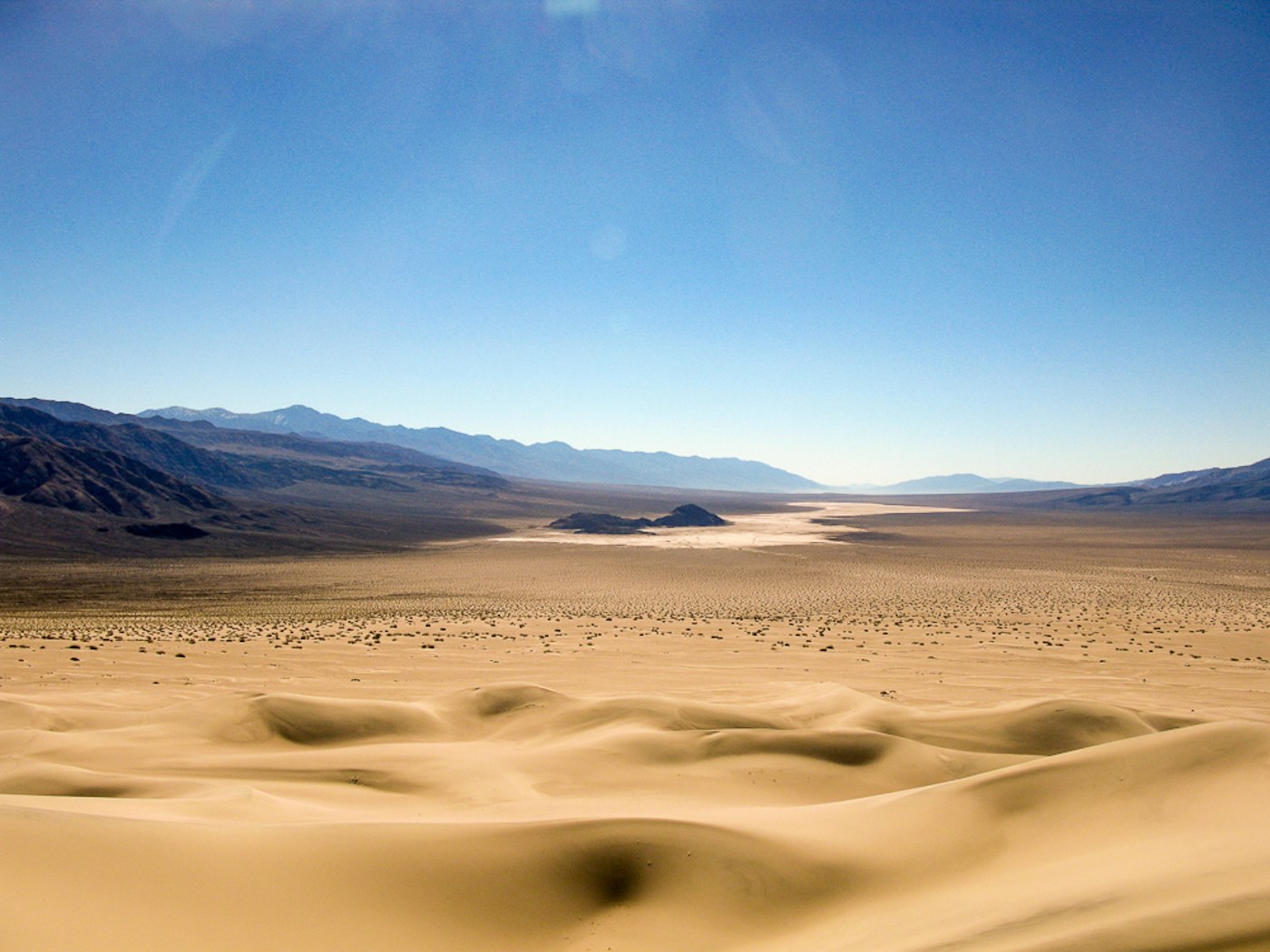
Ibex Sand Dunes

Saline Valley Sand Dunes

Ghost Towns, Ruins, Mines & Historical Landmarks
There are thousands of abandoned mines and landmarks all over the park. This was a thriving area during the gold rush and has countless mines for gold, silver, lead, zinc, Epsom salts, mercury, tungsten, copper, borax, talc, sodium chloride, and manganese.
Scotty’s Castle

Harmony Borax Works
Eagle borax works.

Charcoal Kilns
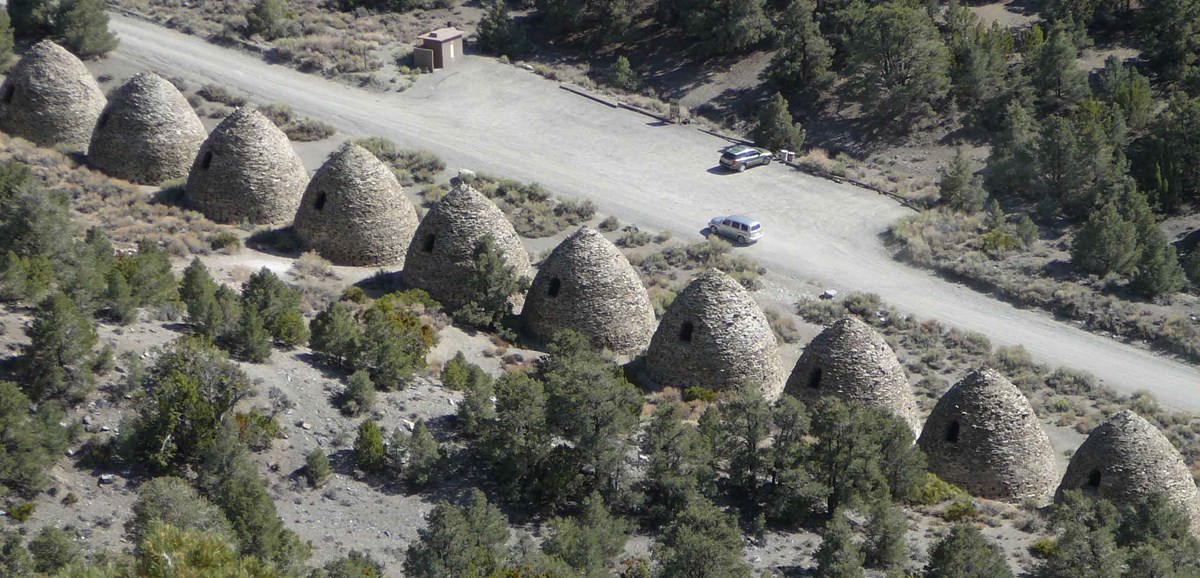
Ashford Mills Ruins
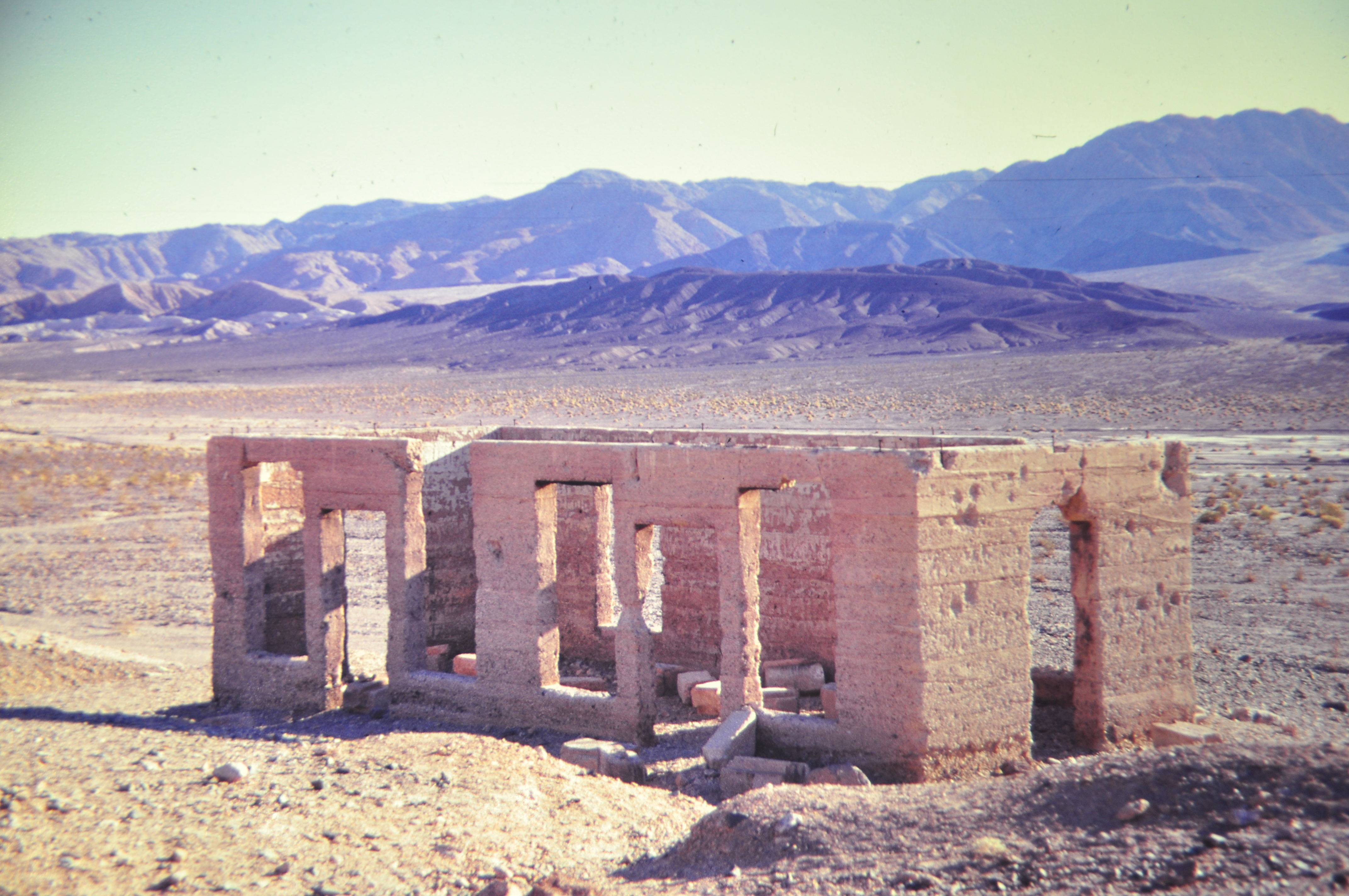
Rhyolite Ghost Town

Panamint City Ghost Town

Ballarat Ghost Town

Leadfield Ghost Town

Old Sulfur Mine

Keane Wonder Mine
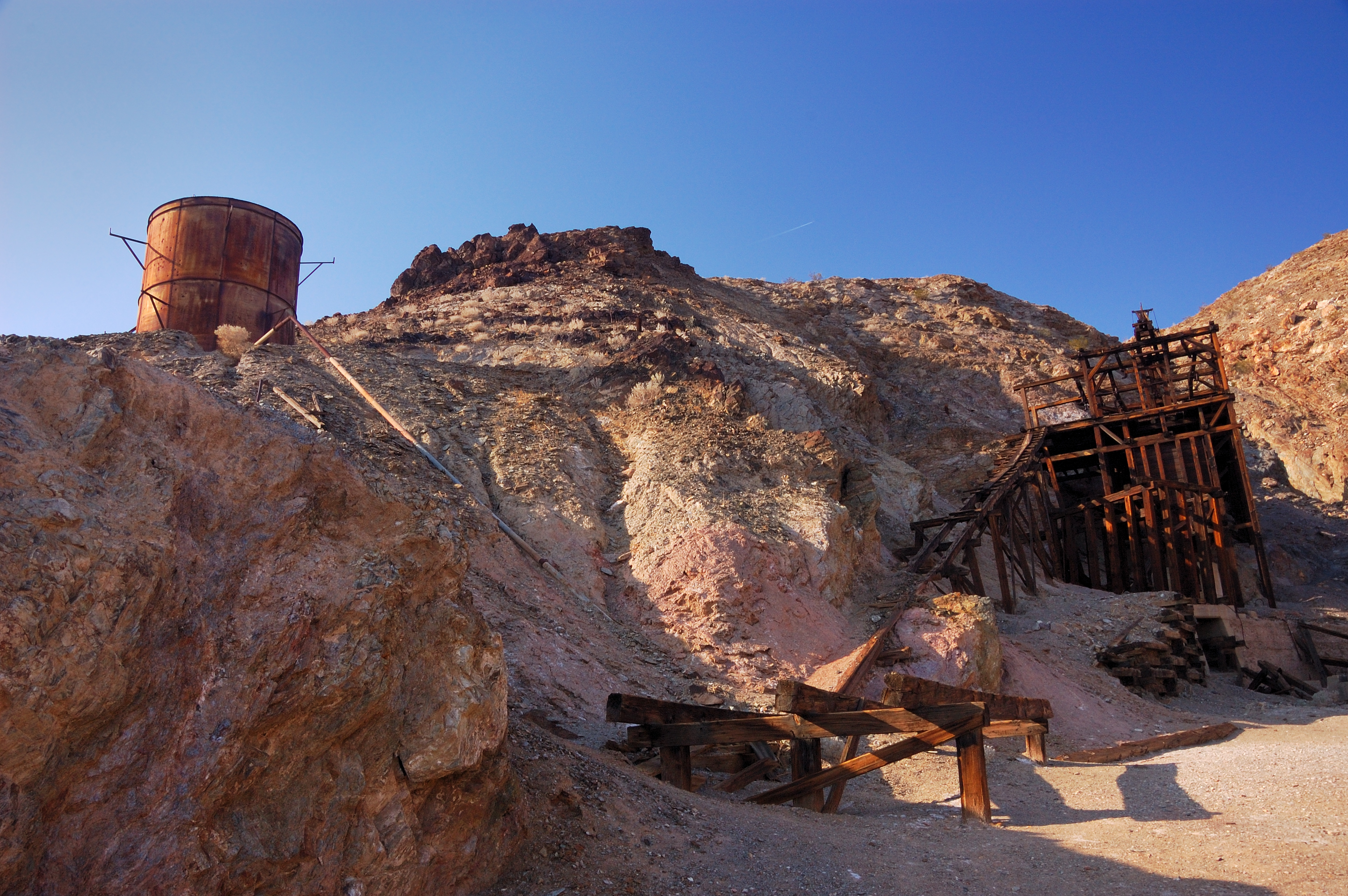
Skidoo Mine
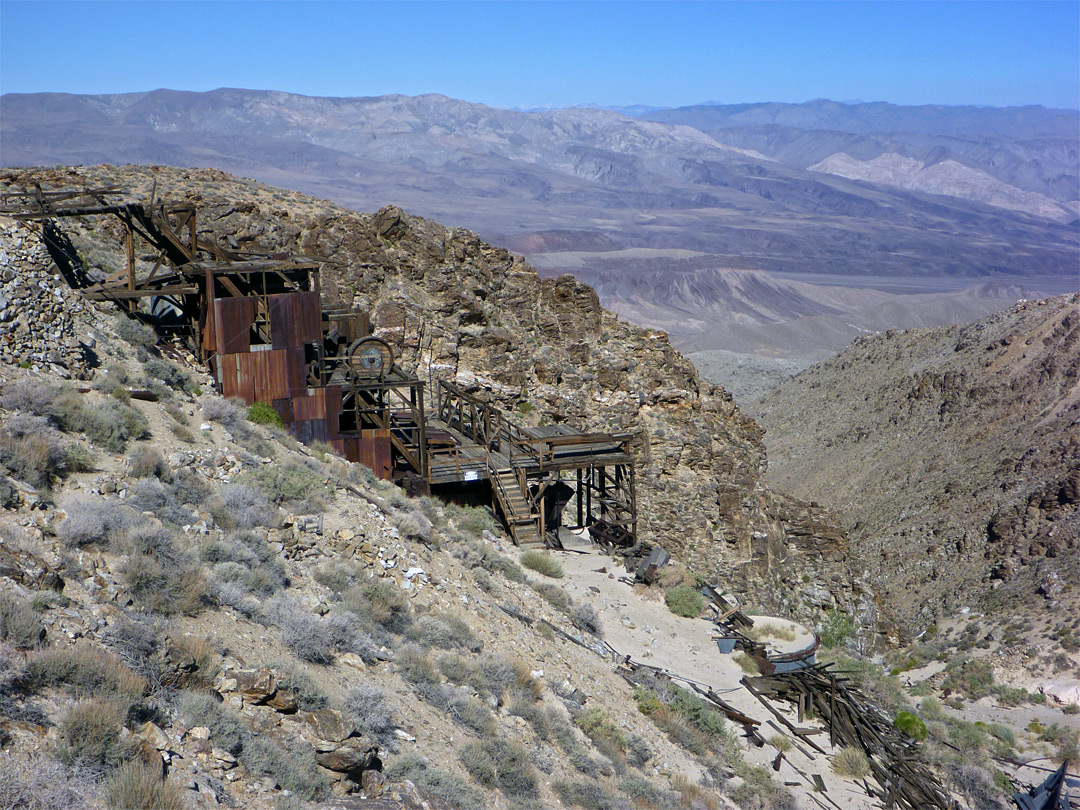
Eureka Mine
Scenic drives, twenty mule team canyon.
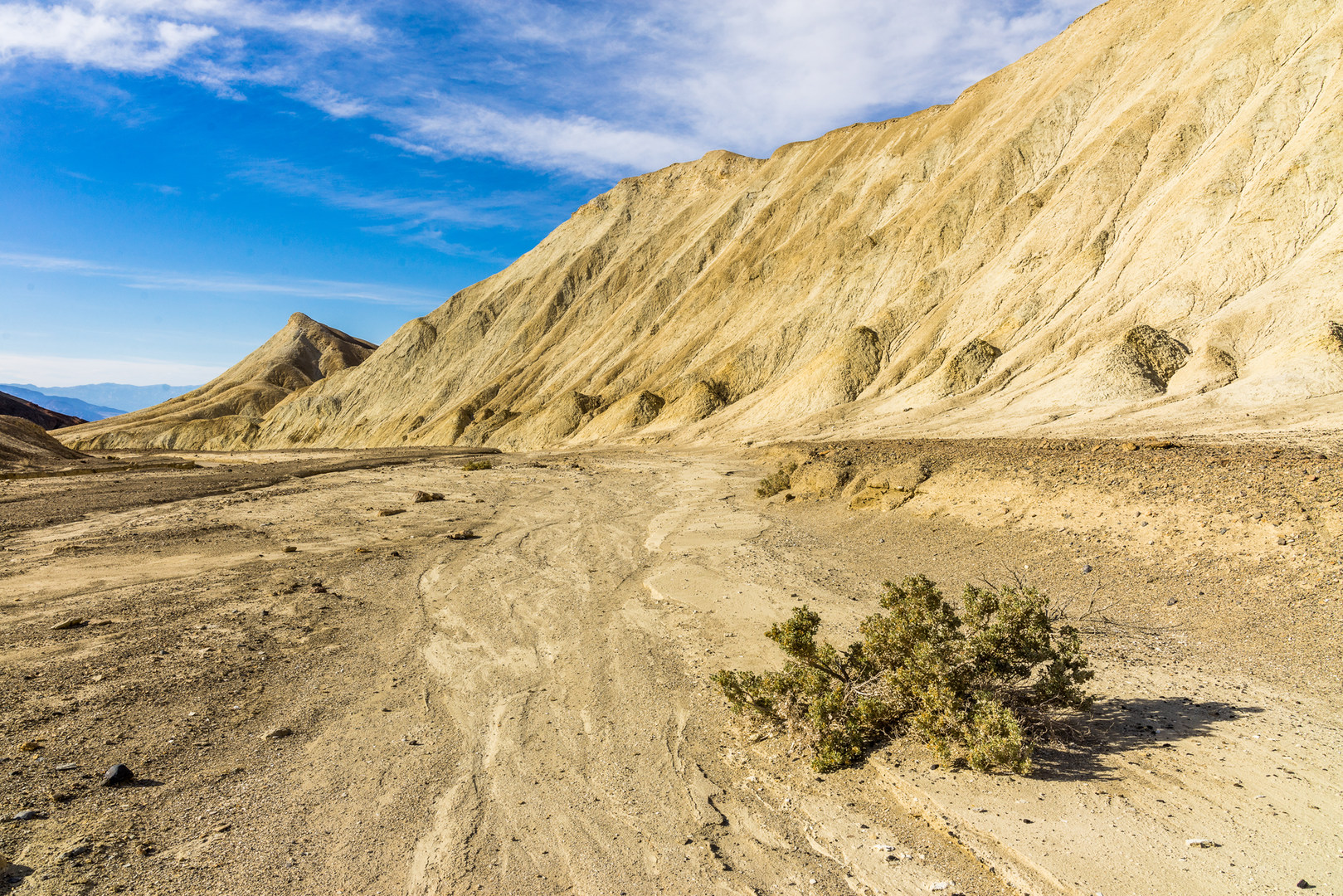
Artists Drive & Palette

Last Chance Mountains

Pretty much any of the above attractions, views, sand dunes etc. all offer hiking options in addition to these “official hikes”.
Natural Bridge Trail

- .5 mile out and back to the bridge.
- Accessible via dirt road only, but packed dirt road, and crowded by tourists.
Salt Creek Interpretive Trail

- 1-mile long boardwalk loop
- Accessible via paved road and crowded by tourists.
Golden Canyon Trail
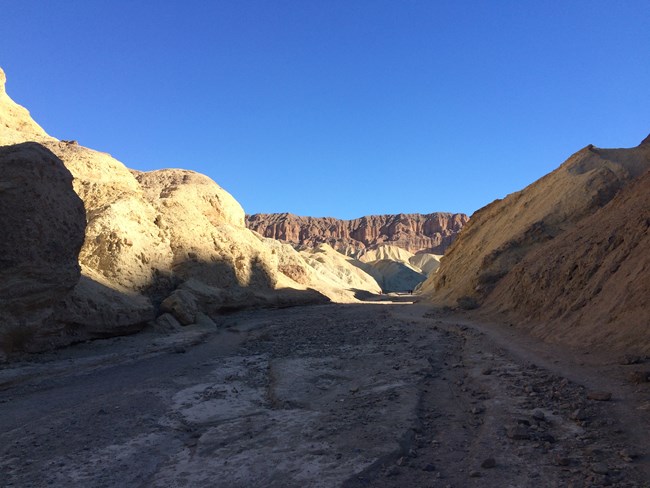
- 3 miles (4.8 km) out and back trip
- More details here .
- Accessible via paved road and also crowded by tourists.
Gower Gulch
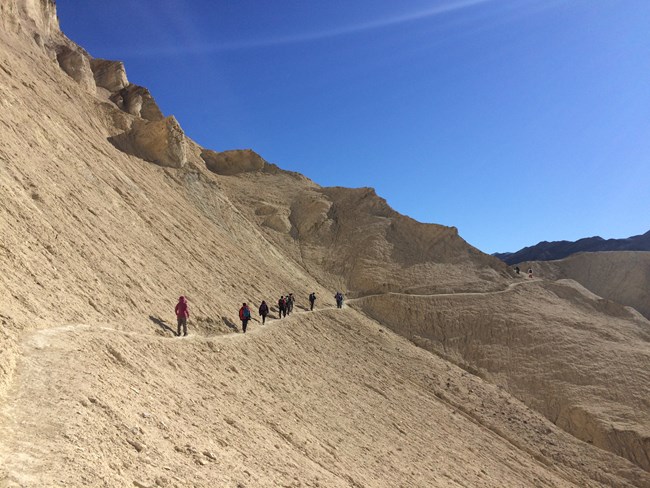
- 4.3 mile (6.9 km) loop.
Badlands Loop
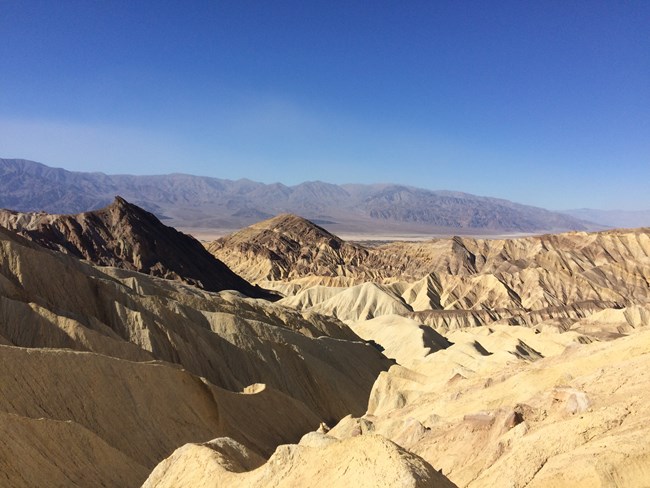
- 2.7 mile (4.3km) loop
- Accessible via paved road (at Zabriskie Point) and also crowded by tourists.
Desolation Canyon Trail
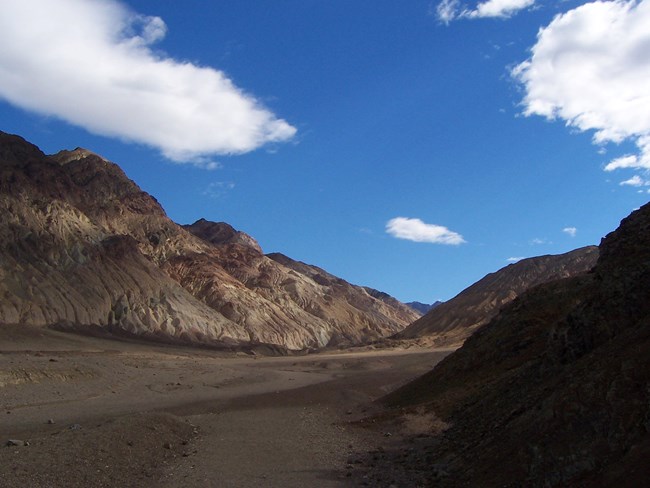
- 3.6 mile (5.8km) out and back
- More details here.
- Accessible via dirt road only.
Mosaic Canyon Trail

- 4 mi (6.4km) out and back
- Accessible via dirt road across from Stovepipe Wells. Crowded by tourists (tho most of them turn around after getting their pictures at the first narrow slot canyon).
Darwin Falls Trail
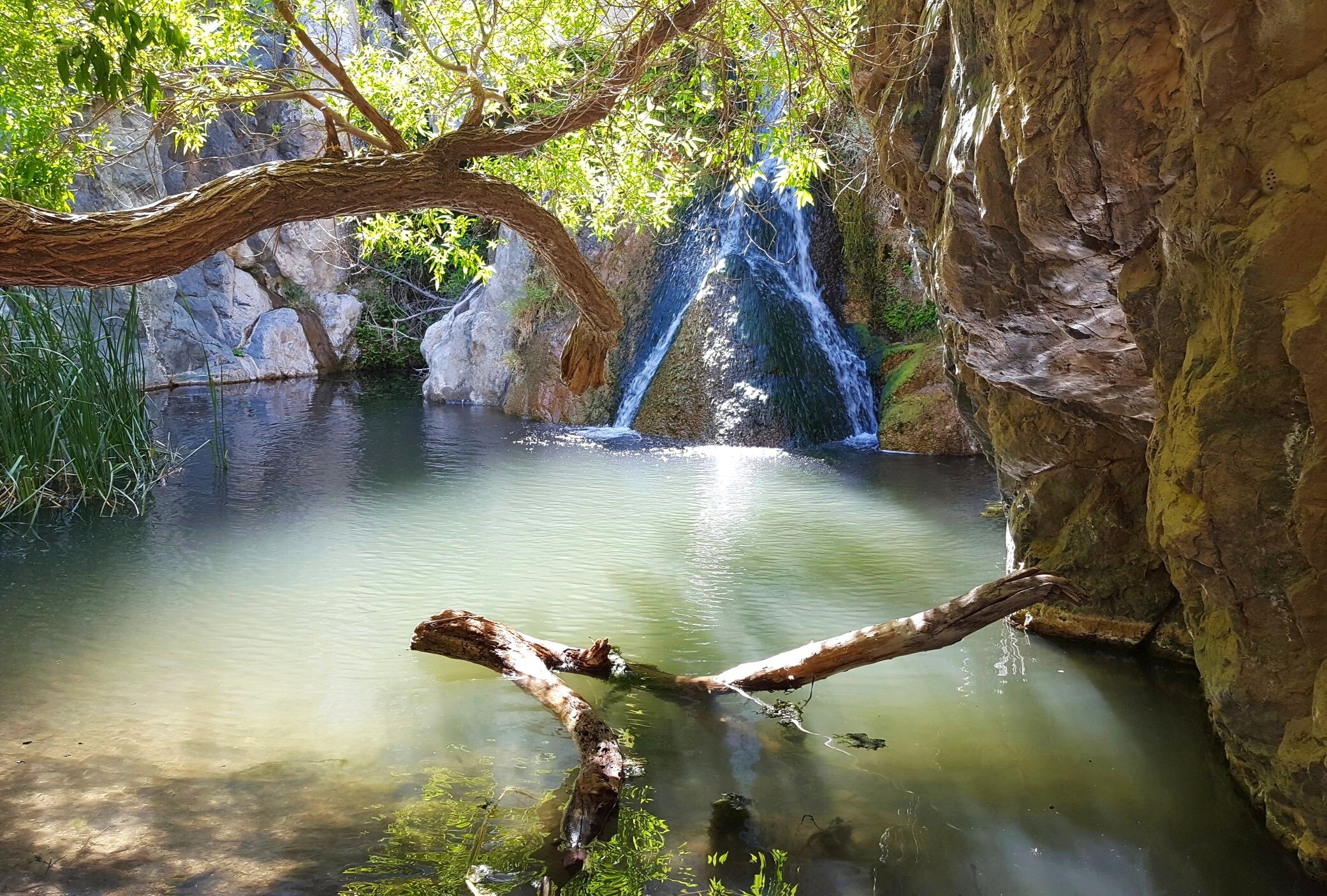
- 2 miles (out and back)
- Accessible via unmarked gravel road.
Lemoigne’s Cabin Hike
- 5 miles (out and back)
- Accessible via bad dirt road – 4×4 required.
Slit Canyon

- Accessible via dirt road.
Hungry Bill’s Ranch
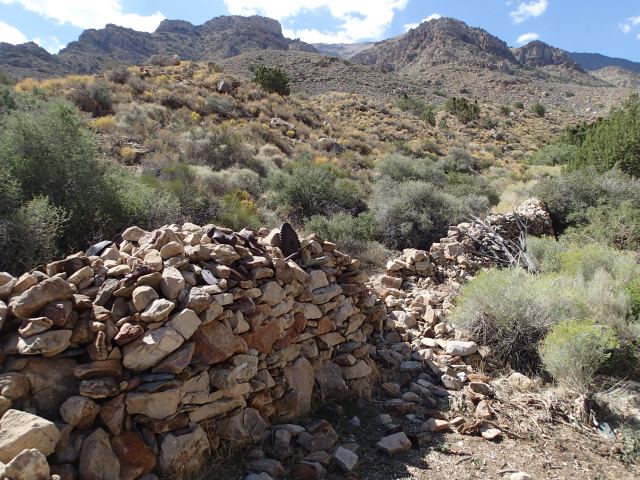
- 2 miles to ranch site from road end; 7 miles to Panamint City.
- Accessible via rough dirt road, 4×4 required.
Fall Canyon
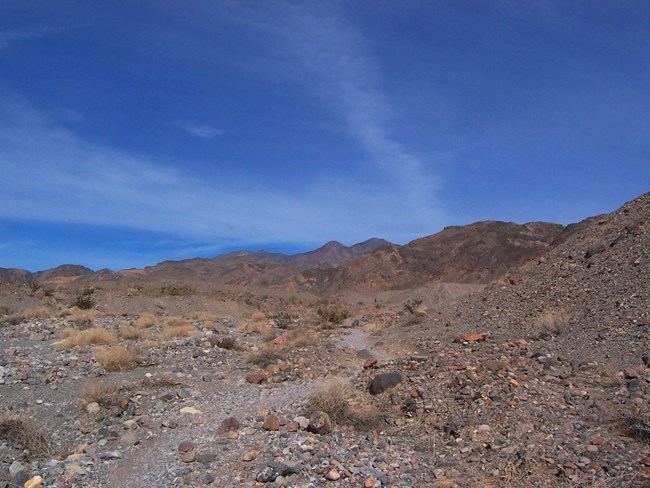
- 6 mile (9.7km) out and back
- Accessible packed dirt road.
Sidewinder Canyon Waterfall
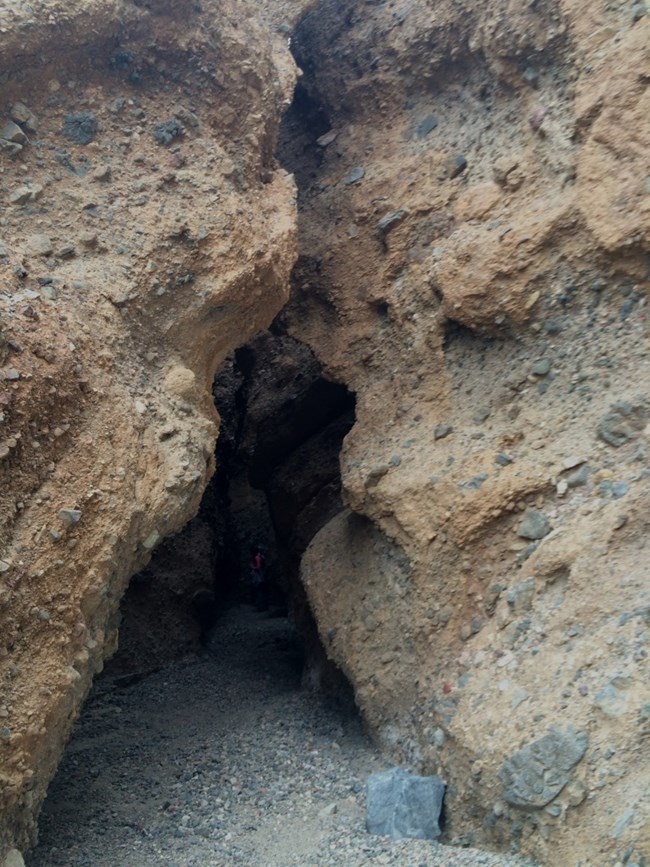
- 5 miles (8.4km) out and back
- Accessible via unmarked gravel access road
Telescope Peak
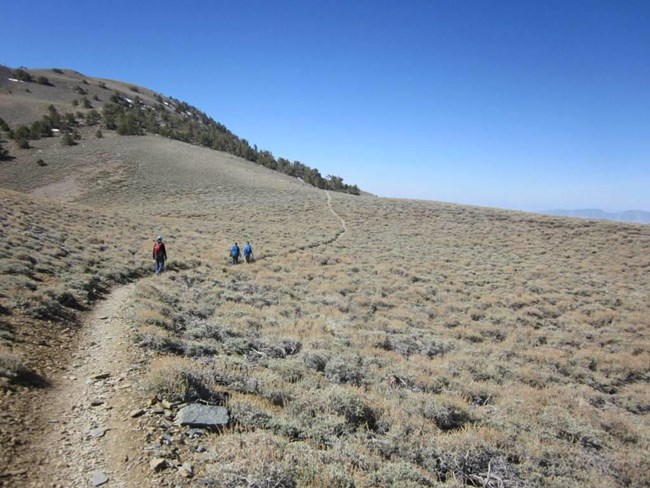
- 14 mile (22.5km) out and back
- Accessible via maintained gravel road.
Wildrose Peak
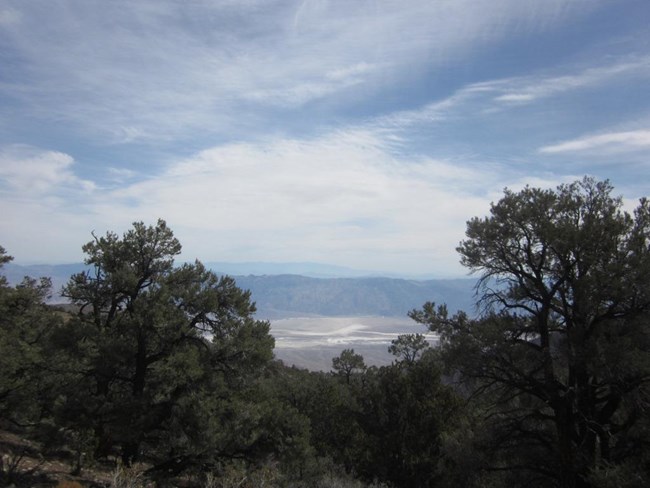
- 8.4 miles (13.5km) out and back
Grotto Canyon Trail
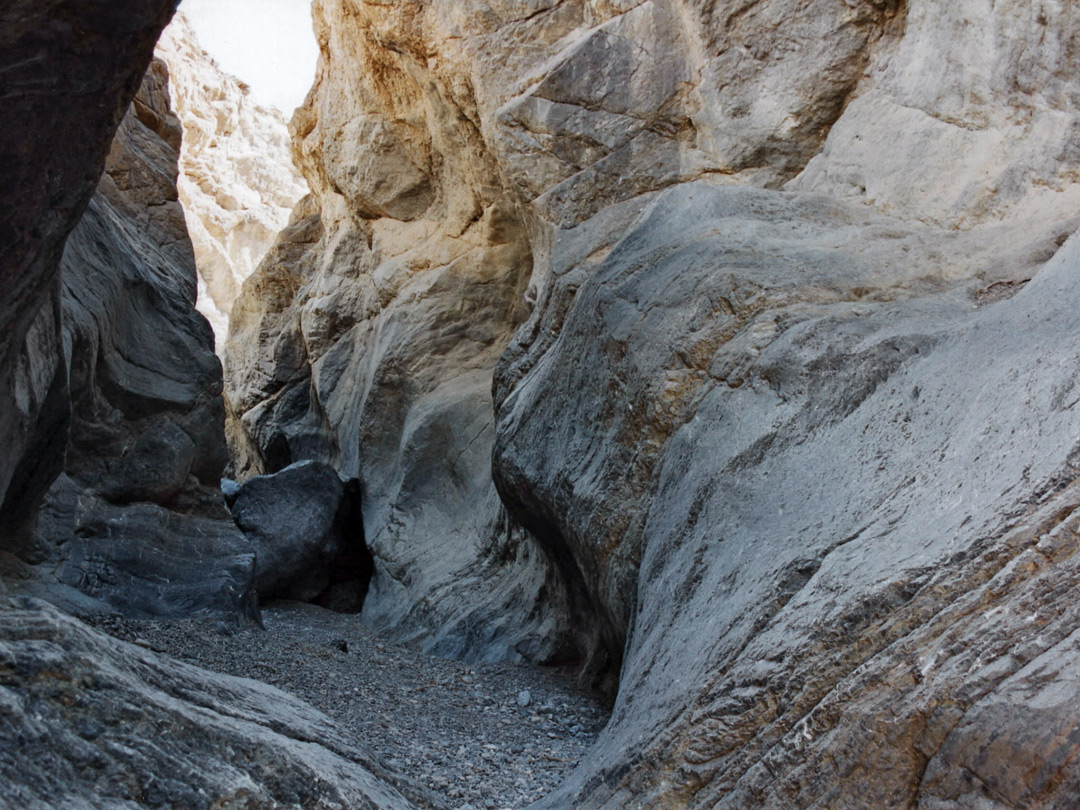
- Accessible via unmarked dirt road near Stovepipe Wells
South Fork Trail Canyon/Mine Camps

- 9.7 miles (out and back)
- Accessible via bad dirt road – 4×4 required.
Surprise Canyon Trail

- 10.3 miles (out and back)
Undertaker Canyon to Widowmaker Dry Falls
Backpacking trails.
You can also backpack the above “advanced” or “moderate” trails as well as long as you camp a mile from a paved road or “day use only road”.
Hanaupah Canyon & Shorty Borden’s Mine
- 3-18 miles (out and back), depending on how far in you drive.
- Rough dirt road, 4×4 required
Cottonwood Canyon & Marble Canyon Loop

- Water: Seasonal Springs
Titanothere Canyon
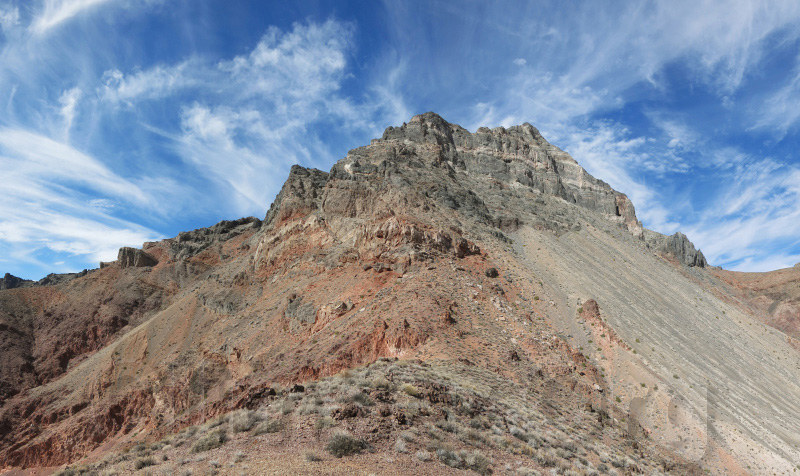
- 4.5 miles to Lostman Spring; 12 miles to Scotty’s Castle Road.
- Water: Seasonal Spring
Indian Pass
No real trail; walk gravel wash and cross-country. Follow wash bearing left (north) staying in drainage nearest ridge; head for low pass in mountains to the east. Last four miles in canyon. 6 miles to springs; 8 miles to pass. Water available in the canyon. Accessible via paved road. Here’s a good resource .
Bighorn Gorge
No set trail. NPS recommends: From the Scotty’s Castle Road, hike down to Death Valley Wash then follow main drainage up alluvial fan to canyon. Several small dry falls are easily passed, but at upper end of gorge an 80 foot dry fall requires scrambling up talus slope on north side to continue beyond. Some additional good info . Accessible via paved road.
Hole in the Wall Trailhead
This isn’t so much a “trail” as a road that leads to several options (including Slit Canyon and Undertaker Canyon listed above) or backpacking. There’s no trails, so you can make your own! Several rugged canyons in Funeral Mountains just above Hole-in-the-Wall can be explored depending on your climbing ability.
Owlshead Mountains
No specific trail, just options to create your own. Through Canyon is one of the largest and passes through to a hidden basin at the heart of the mountains. A possible loop trip is return via Granite Canyon.
Travel Vlog!
Anything you think I should add? Let me know in the comments!
RELATED ARTICLES MORE FROM AUTHOR
Leave a reply cancel reply.
- Destinations Map
- Conservation & Awareness
- Latest Posts

The Coolest Things to do in Death Valley!
The name Death Valley brings with it a mystique, a note of fear. Growing up, I saw media images and heard stories that scared me. Death Valley seemed like one of those places you could go and get lost, and as the name says, die. But the truth is, Death Valley is a beautiful place with a unique ecosphere that is teeming with its own kind of life. There are a ton of things to do in Death Valley, and there are also some super cool things to do in Death Valley.
Death Valley is not only unique in the National Park Service, in its environment of extremes, it is also unique in the world, being in a Unesco International Biosphere Reserve, and an International Dark Sky Park. It is a place everyone should see and experience! There are things to do in Death Valley that cannot be done anywhere else in the world!
Yes, there are certainly dangers in the park, but more often than not, they are caused by foolishness and a lack of preparation. Check out the National Park Service Safety Tips, if you are wondering what risks do exist, and if you are interested in more information about the park’s uniqueness, check out our Interesting Facts about Death Valley .
While Death Valley may be known for being the home of the hottest place on earth, from November through early April the temperatures are typically quite pleasant. Not only can you drive Death Valley Road, you can also get out and explore the surreal landscape and environment, and experience all of the cool things to do in Death Valley, without falling into heat exhaustion! That is the best time to visit Death Valley.
If you are planning to include your time at Death Valley as part of a National Park road trip, you may want to visit Yosemite next as it is the shortest drive, at just over 3 hours. Other options include visiting Joshua Tree, at 4 hours away, Sequoia Kings, at 5 hours, and Grand Canyon at just over 6 hours drive to the south rim.
All the Cool Things to Do in Death Valley, and Nearby
We are not going to talk a lot about those famous places you have heard of. Yes, we will mention them, briefly. If you wanna know about the regular stops, read our Death Valley Day Trip Itinerary. But if you are here, you probably want something above and beyond what everyone else does, we are going to give you some entirely different things to do in Death Valley! We are excited about that!
Be Typical Seeing all the Big Name Attractions

This is one of the most popular activities in Death Valley. Yes, we had to at least mention the most common thing once, since everybody does it! Badwater Basin, Zabriskie Point, Artist’s Pallet, I won’t go through them all here. The truth is, most of them ARE pretty cool things to do in Death Valley, but they are not unique. You should probably see them either way. If you want to know all about them, or you only have a day, check out our Death Valley Day Trip. If you have more time for unusual things, keep on reading here.
Be Immortalized on Social Media
Get some excellent photos and some fun selfies at some of the parks most Instagram worthy, Snap Chattable and TikToking locations. Some spots we suggest- Zabrieski Point, Artist’s Palette, Red Cathedral, Badwater Basin (at the sign and on the flats), Harmony Borax Works, Mosaic Canyon, Devil’s Cornfield, Mesquite Sand Dunes, Teakettle Junction, and Dante’s View. There are amazing photo opportunities throughout the park, with the surreal desert landscape. When you are done you may want to travel of all of the other fabulous Instagram spots in the California desert!
Be Guided on a Ranger Led Tour

Offered only between November and March due to weather, ranger led tours and informational talks take place in various locations, and cover topics from geology to wildlife, to history. While this might not be one of the most unique things to do in Death Valley, the topics themselves are generally unique to the park. Tours are based out of the Furnace Creek Visitors Center, and the Death Valley History Association.
Be Promoted to Junior Ranger (- or help the kids do so.)
The Junior Ranger Program is an excellent part of several US National Parks, including Death Valley. Pick up a booklet at a ranger’s station, and let it lead you through the attractions, and a fun learning adventure. After completing the activities, children up to age 12 are sworn in as Junior Rangers, and awarded a ranger pin. I helped my grandsons achieve theirs at Mammoth Cave National Park.
Be Adventurous in a Slot Canyon

Slot canyons offer one of the most scenic and surreal hiking venues in the desert environment. Most people envision hiking Antelope Canyon, but many people are unaware that Death Valley National Park features several of these stunning canyons. Mosaic Canyon is one of the most popular among hikers, located just outside of Stovepipe Wells, and Titus Canyon, which is accessed from highway 374 before entering the park, is loved by hikers and 4 wheelers alike.
Be Exploring at a Volcanic Crater

There are dormant volcanoes all across the western United States, but there are few craters that are open and accessible. While you can see cinder cones at Lassen Volcanic National Park and Craters of the Moon , Ubehaha crater in Death Valley is much easier hike. The name originated with local Native Americans, and means appropriately, big basket in the rock. Being a Maar volcano, the crater was formed by an explosion of ground water heated by the magma below, and not lava, which accounts for its lower, broader surface.
** The roads to Ubehaha Crater are currently closed due to flash flood damaged. The National Park Service hopes to have them reopened soon.
Be Spooked at a Ghost Town

Anyone with a fascination for abandoned places can’t pass up a good old-fashioned ghost town. There are several boom to bust ghost towns in and around Death Valley with varying degrees of remnants. The most well-known and easily accessible is Rhyolite, outside of the park boundaries, but there are several others within the park that can only be accessed by hiking. Other well known and accessible towns include Skidoo, Panamint, Keeler, and Cerro Gordo.
Be Entrepreneurial at Old Mines
Death Valley and the surrounding mountains are a land of would-be millionaire miners, seeking gold, silver, borax, salt and even talc. A plethora of mines were abandoned and have fallen into varying degrees of ruins. The tools and equipment left behind offer intriguing exploration and photo opportunities. The Keane Wonder Mine, which produced over a million dollars worth of gold, is the most well-preserved and easily accessible.
Be Ecological Seeing Critically Endangered Fish

Death Valley is the natural habitat of 5 different species of pupfish, which are entirely unique to the region, found nowhere else on the planet. Their small habitat makes the particularly at risk due to human developments, and all species are protected. It can be quite exciting to find and observe this tiny fish that only exists here. The easiest to find is the Salt Springs Pupfish, by hiking the boardwalk trail that leads to the headwaters of the spring.
Be Soothed by Natural Hot Springs
There are several developed sites for hot spring soaks within Death Valley. The easiest to access is the Furnace Creek Inn pool, which is piped hot springs water. Saline hot springs offer a more out in nature approach, and are clothing optional, but require 4 wheel access. Nearby towns of Teacopa and Shoshone also have hot springs options. Natural hot springs are heavenly, and definitely one of the most relaxing things to do in Death Valley.
Be Amazed by the Stars
As a Dark Sky Park, Death Valley National Park and the surrounding the communities are committed to protecting the night-time skies and nocturnal animals from light pollution. This makes the park one of the best places in the US to get out and see the stars, so make sure you can spend some time outdoors after dark. If you have lived your life in a relatively urban area, the brilliance of the Milky Way will astound you!
Be Challenged by the Lowest Elevation Golf Course in the World
Yes, there is a golf course in the midst of Death Valley, at the Furnace Creek Resort. It is an 18 hole par 70 course, best for winter and spring trips to the valley. The course was recognized by Golf Digest as one of “America’s 50 toughest golf courses.” It is said that the below sea level elevation results in slightly more gravity and barometric pressure, that results in a distinct difference in ball response from the normal above sea level courses.
Be Educated by the Area Museums

Although the park is not overflowing with museums, there are a few in the area that are interesting and worth checking out. The Furnace Creek Visitors Center has educational displays about the geology and history of Death Valley, as is typical of all National Park Visitors Centers. Right next door is the Harmony Borax Works Museum, which offers an interesting look into the history of the only long-term profitable mining venture in the valley. The nearby town of Shoshone also has a museum with a number of artifacts related to mining and the railroads in the area.
Be Bounced by a 4 Wheeler

Death Valley offers some very gorgeous 4 wheeling roads, that lead to places that cannot be accessed by regular vehicles. There are routes that challenge even the most skilled drivers, but make for a day of fun and beauty. Some of the routes also access remote campgrounds, for those seeking an overnight stay. You can rent a jeep right in the park at Farabee’s, in Furnace Creek.
Be Pop Culture Savvy at the Star Wars Sites

The Furnace Creek Visitors Center can provide a map of filming locations from the original Star Wars movies, which used Death Valley to create the harsh environment of Luke’s home planet Tatooine. You see Luke and the droids wandering across the dunes in the original movie. Later, approaching the inhospitable lair of Jabba the Hut was also filmed in a different location. Shoot, the super Star Wars buffs could replicate the scenes, making it the funnest thing to do in Death Valley! You can be sure someone has already done this, and they give the inside word on the Star Wars locations.
Be Encultured by the Native Shoshones
The native residents of the area are the Timbisha Shoshone Tribe, and paying a tribute to their culture while visiting their tribal lands is appropriate. You can do so at Timbisha Shoshone gift shop and Furnace Creek Cultivation Cente r. Buy native arts at the gift shop, and learn a bit about their culture. Some of the small local businesses are native run as well, such as the Hawaiian Shave Ice. If you venture to the west of the park, the tribal office can be found in the town of Bishop, California.
Be Mesmerized by a Waterfall in the Desert

On the far west side of the park, high in the mountains, you can see the only year round flowing waterfall in the park. It is a striking contrast to the surrounding desert, making it a wonder even for those who are not typical waterfall lovers. Take Old Toll Road off of 190 just south of Panamint Springs, which is accessible by car. The waterfall will be a short hike from the parking area.
Be Awed by the Best View in the Park

People seldom think of the mountainous portions of Death Valley, overlooking a significant aspect of its wonder. There are peaks on both the east and west of the valley offering striking views. But nothing compares to the view from Dante’s Peak, with the salt flats below. The best part is there is no climbing or hiking required to take it in.
Hike One of the Steepest Vertical Rises in the US –
These hikes are for the serious and experienced hikers, but there are trails from the valley floor at Badwater Basin, to some of the highest peaks in the park, including Telescope Peak. Plan for an all day adventure, as this is a 15 mile uphill trip one way, followed by a 15 mile downhill trip. Get further information at the Furnace Creek Visitors Center.
Be Creeped Out at Barkers Ranch –
We know some people have to do the creepy things, so seeing Charles Manson’s last hideout may be the creepiest thing to do in Death Valley. The ranch is on the far west side of the park, but the easiest access is taking Warm Springs Road from West Side Road, in the salt flats. Access from west of the park in the ghost town of Ballarat requires a 4×4. In either scenario, a portion of the trail must be hiked, despite the strange fact that Manson himself drove a school bus to the ranch. Be sure to check road conditions at one of the ranger stations before attempting to access the roads.
Be Exhillarated Surfing the Dunes

Sand boarding has become quite popular over the past two decades in some National Parks and Recreation Areas. As long as the sand isn’t oo hot, it is completelhy a blast, and quite a workout climbing back to the top. While there are at least 6 areas of dunes in Death Valley, boarding is only allowed in Mesquite and Saline Valley Dunes. Mesquite Dunes are readily accessible, but Saline requires a 4 by 4 to access.
Be Entertained at the Armagosa Opera House –
Although not in the park, the Armagosa Opera House has long been one of the Death Valley curiosities. Former Broadway performer Mart Becket came upon an abandoned social hall in the dying town of Death Valley Junction in 1967. The Junction had once been home for the workers of the Pacific Borax Company. Marta purchased the hall, and transformed it into the Opera House. Although a lot has happened in the meantime, performance are again held each week. Check the upcoming performances.
Be Intrigued at the Cerro Gordo Peak Salt Tram –
Located outside of the park in the mountains along the western edge, the salt tram was a technological wonder in its time. Built to carry salt from one side of the mountains to the other, the peak station, and many of the enroute stations, are still entirely intact. Located off the Cerro Gordo to Swansea Road, to ensure access, the safest bet is to use a 4 wheeler.
Be Sweetened by the Treats at China Grove Date Farm
In the nearby town of Teacopa, the date farm is a fun stop that reveals how ingenuity can lead to a profitable enterprise even in inhospitable conditions. The orchard section of the farm is quite beautiful. There is also a very small museum, and a shop where delicious baked goods made with their own home-grown dates, can be purchased.
Be Charmed by the Small Town Shoshone

Shoshone calls itself the gateway to Death Valley, but it is a charming town in its own right. There is a small general store, a cafe with some delicious food, and bar, and a museum highlighting the towns once thriving history with mines and a railroad stop. The town also has a wetlands nature reserve, known to be the habitat of numerous species of waterfowl, its own unique species of pupfish, with bird watching trails.
Be Enlightened at Manzanar Internment Camp –

If you have never heard of Manzanar, it is no wonder. It reveals a side of US history that many are unaware of, or many choose to turn away from. Manzanar is one of several internment camps used to detain Japanese American citizens during WWII. A visit to Manzanar brings a sobering recognition that as a people, we are capable of such fear driven actions against our own neighbors.
Is that all the things to do in Death Valley?
Not by any means! I keep remembering more even as I start summing up this list of cool things to do in Death Valley. But, I have to stop somewhere. If you find you have done all of these, and want even more, leave a comment! I am sure I can can share more ideas. And, don’t forget, all of the traditional activities you might hope for on a National Park are there as well.
Getting to Death Valley
Part of the attraction of Death Valley is its remoteness, but this means there are not any simple ways to access the area. Las Vegas is the closest major city, being about a 2 hour drive, while Los Angeles is about a 4.5 hour drive if traffic is not bad.
Flying into either of these cities and renting a car is the easiest way to get to the park and surrounding areas. If you only want to make a Day Trip, coming from Las Vegas is the best option. But it could make a great Southern California weekend getaway from LA or San Diego.
If you are driving from elsewhere in the US, Interstates 15 and 40 pass closest to the park.
Entrance into the Park
$30 for 7 Days, effective June 1st, 2018. This permit allows all persons traveling with the permit holder in one single private, non-commercial vehicle (car/truck/van) to leave and re-enter the park as many times as they wish during the 7-day period from the date of purchase.
Fee can be paid at self-serve kiosks at major park attractions, or at the any of the Ranger Stations throughout the park. The easiest to access is the station at Furnace Creek.
Lodging Options for Enjoying the Cool Things to Do in Death Valley
Comfortable lodging is available at 4 locations within the park.
- Furnace Creek Inn
- Furnace Creek Ranch
- Stovepipe Wells Village
- Panamint Springs Resort
You can find your perfect lodging for Death Valley here!
Lodging is also available in nearby towns.
There are several different campgrounds within the park, at different elevations and with differing levels of development. Some have full RV hook up sites, while others are tent only. Back country camping is also available. Check the National Park Service website for full details.
Ready to Experience some of the Cool Things to Do in Death Valley??
Death Valley is an incredible and unique place in the world, one that you must experience at least once! If you are more traditional, or in a hurry, use our Death Valley Day Trip Itinerary.
But if you are more adventurous and have a bit of time, we hope these Cool and Unique Things to do in Death Valley included something that appeals to you! And if we missed any, we would love to hear about them!
If you want to let others in on the secret, go ahead and Pin this!

About the Author

You know me, Roxanna Keyes, sometimes referred to as FoxyRoxyK, the founder of Gypsy With a Day Job. I was 50 before I really began to experience all the world has to offer. I really don’t want you to wait so long! That is why we share so many stories about so many amazing destinations. We want to help you plan the trips of your dreams, and make your budget. Be sure to check out our destinations pages, to find the places you want to go. You can plan some amazing trips, with LOTS of things to do. If our stories don’t give you the info that you need, let us know. We will try to get it for you! Help us out and share our stories when you can.
Share it Forward:
Related stories, you might also like:.
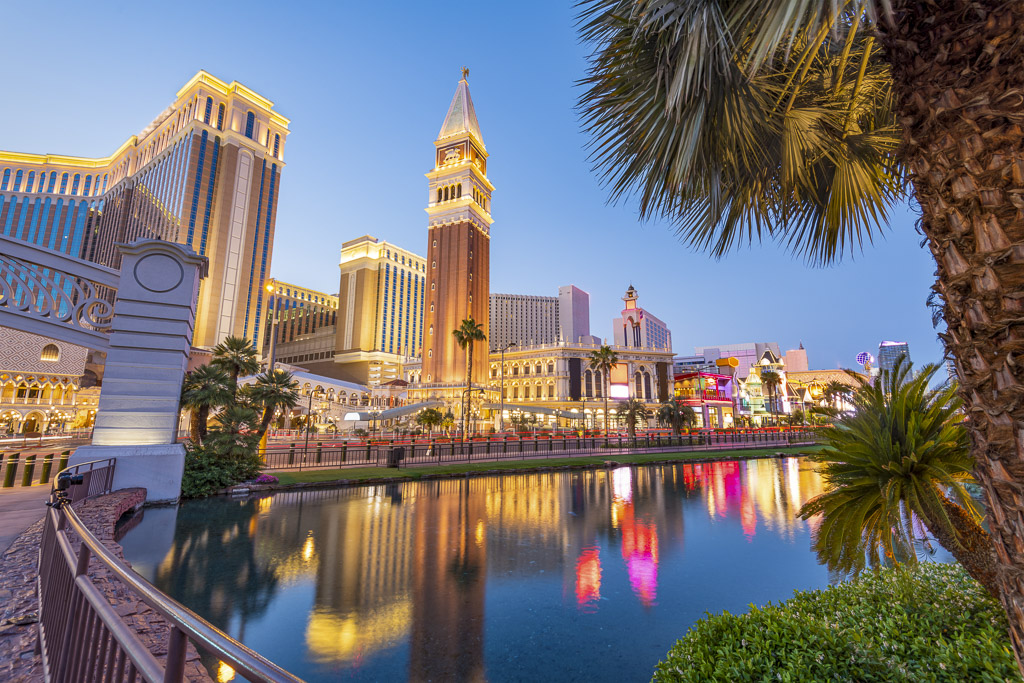
Las Vegas – 57 Free Things to Do for All Types of Travelers
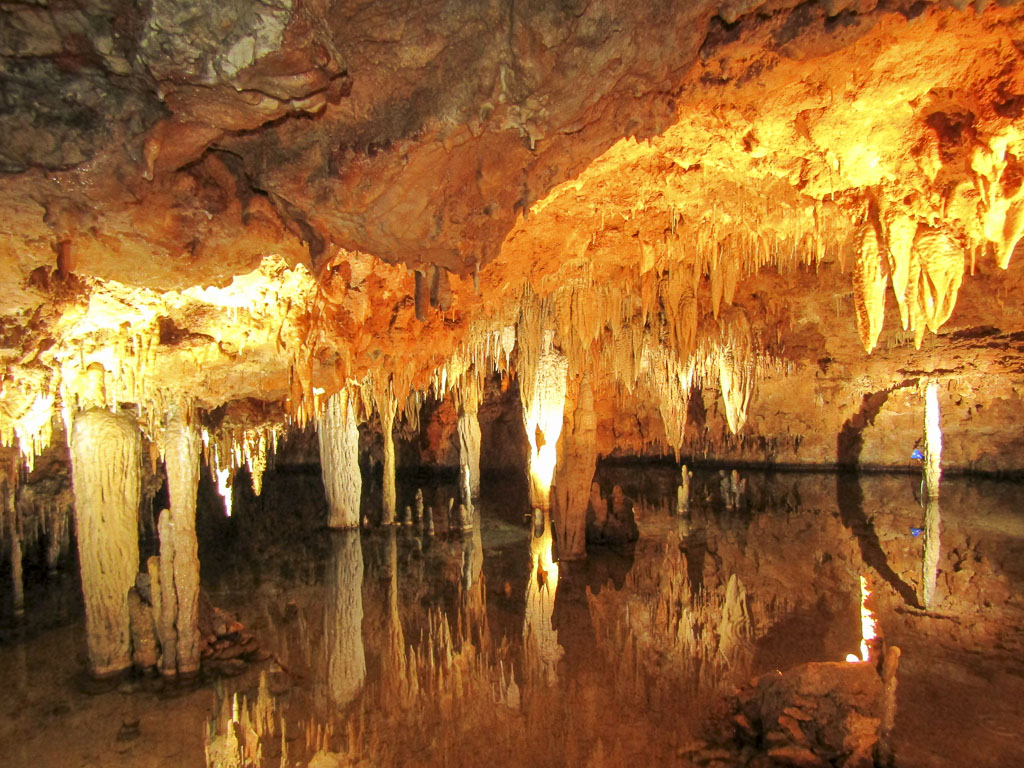
30 Things to Do At and Near Meramec Caverns
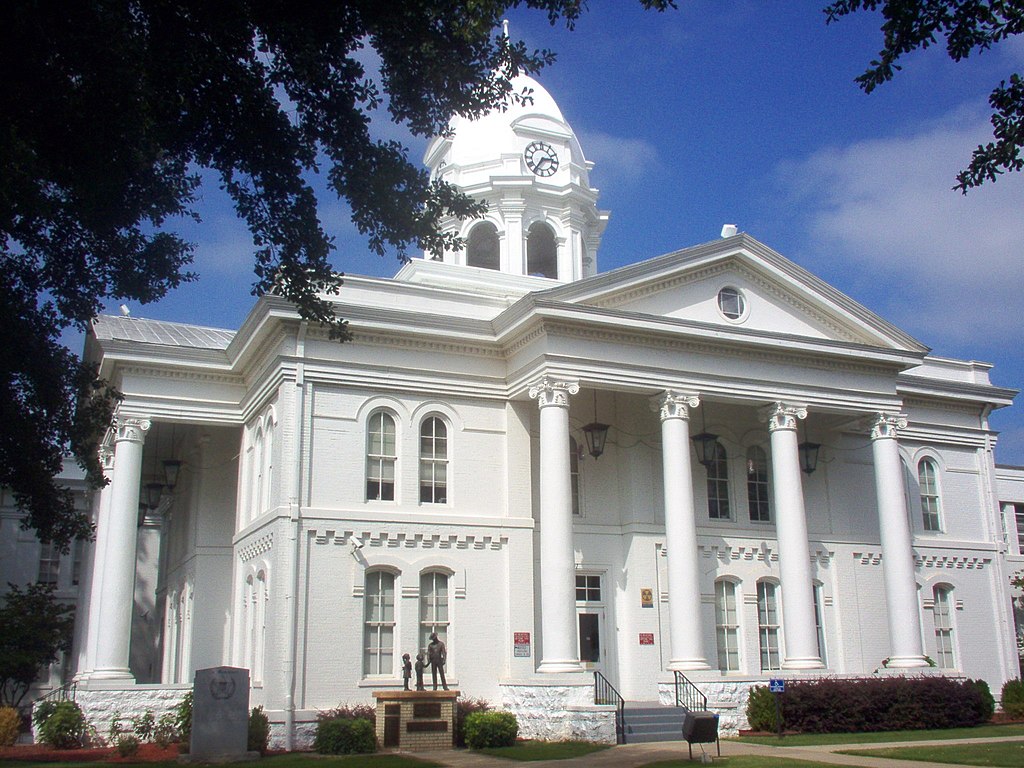
Go Beyond Muscle Shoals, with A Weekend in The Shoals
6 thoughts on “ the coolest things to do in death valley ”.
- Pingback: Death Valley Facts- 25 Cool, Curious, and Fun Facts About Death Valley.
- Pingback: Day Trips from Las Vegas -The Ultimate List of Excursions from Las Vegas
Please list the places in Death Valley area that will have gas. Thanks
Hello Rozella, I apologize as I did not think of it with this article, as I had mentioned them in our related post on a day trip from Las Vegas to Death Valley. I will have to add them to this article when I get time! Inside the park grounds, there are only 3 places where you can get gas, Furnace Creek, Stovepipe Wells, and Panamint Springs. All of these stations are visible from route 190, but expect to pay almost $2 more than normal a gallon. Near the park, the towns of Shoshone, CA, and Beatty, NV, both have gas stations, and also Amargosa Valley, which is the junction of US route 95, and Nevada route 373. Enjoy your visit to Death Valley!
Thanks for this detailed & informative post! I had no idea Death Valley had slot canyons. Definitely adding these things to my Death Valley bucket list!
Thanks for all the suggestions. Will be bookmarking this for our next trip.
Leave a Reply Cancel reply
Your email address will not be published. Required fields are marked *
Sign up to receive our latest articles, when they're released!
Top Things to Do in Death Valley National Park, CA - Death Valley National Park Must-See Attractions
Things to do in death valley national park, explore popular experiences, ways to tour death valley national park.

Death Valley Sunset and Starry Night Tour from Las Vegas

Death Valley Small Group Day Tour from Las Vegas

Death Valley Explorer Tour by Tour Trekker

Small-Group Death Valley National Park Day Tour from Las Vegas

Death Valley Sightseeing Tour with Stargazing and Wine Tasting

Death Valley National Park Self-Guided Audio Driving Tour

Death Valley Day Trip from Las Vegas

Small Group Tour at the Death Valley from Las Vegas + LUNCH

- Death Valley National Park Audio Guided Driving Tour

Death Valley Sunrise & Stargazing Day Tour Group Discount for 2 More People

Top Attractions in Death Valley National Park

Other Top Attractions around Death Valley National Park

Nature and Wildlife Tours
Private sightseeing tours.

Walking Tours
Hiking tours.

Tours & Sightseeing
What travellers are saying.
- Zabriskie Point
- Dante's View
- Artist's Drive
- Artists Palette
- Titus Canyon
- Ubehebe Crater
- Death Valley Sunset & Starry Night Tour from Las Vegas
- Death Valley Small Group Day Adventure From Las Vegas
- Small-Group Death Valley National Park Day Trip from Las Vegas
- Death Valley Self Guided Audio Driving Tour
latest in World News

Iran could hit Israel with 100 drones, missiles as soon as...

Israel kills son of Hamas leader inside his car in West Bank raid

Apple accused of antisemitism for suggesting Palestine flag when...

Massive air attack destroys one of Ukraine’s largest power...

Beautician plunges 170 feet to her death climbing over barrier...

US, South Korea and Japan hold naval drills amid North Korea...

Russian spacecraft, US satellite nearly collided in shockingly...

Israel bracing for Iran to attack within the next two days:...
Body of ‘vampire,’ 22, found bloodless in abandoned italian church after possible ghost-hunting tiktok challenge: reports.
- View Author Archive
- Get author RSS feed
Thanks for contacting us. We've received your submission.
The body of a French woman who was seen dressed like a “vampire” was found drained of blood with stab and gunshot wounds inside an abandoned church in Italy as police speculate she may have been taking part in a ghost-hunting TikTok challenge.
The body of Auriane Nathalie Laisne, 22, of Saint-Priest, near Lyon, was discovered by a hiker in a fetal position with her sweatshirt covered in blood from various wounds — days after her boyfriend Teima Sohaib allegedly killed her inside a deserted church in Aosta Valley, officials said according to Il Gazzettino .
Laisne had a domestic violence case opened in France against the 21-year-old Egyptian Italian who lived in Grenoble, France, which banned him from going near her, the outlet reported.

Police believe her death could be connected to a popular ghost-hunting TikTok challenge in France, according to CNN.
The case is a “classic femicide,” Il Giornale reported an official saying during a press conference. A murder investigation has also been opened in Grenoble.
“It is a classic femicide motivated by motives of possessiveness and control over the victim’s will,” Aosta prosecutor Luca Ceccanti said, according to Il Giornale .
“The person arrested in Lyon is seriously suspected of the crime of premeditated murder and other aggravating circumstances.”
A witness saw the pair dressed like “vampires” and described Laisne as “emaciated” and looking like a “corpse” before her death, the outlet reported.
“They were dressed like two Goths, all in dark. Like those boys who venerate death. I thought: two vampires,” the unidentified witness told the Italian outlet.
“And I also thought something else, for which I now feel very ashamed of: She was so pale, she looked like a corpse. I can no longer sleep knowing what happened.”
Police are also working to determine if Laisne’s death was a “consented murder” — or sacrifice — as she was found bloodless and had suffered a stab and three bullet wounds, CNN said.
Investigators believe she may have been stabbed with a camping knife and bled to death and was then shot twice in the neck and once in the abdomen after she died, medical examiner Roberto Testi and police said, according to the network.
Laisne’s body was found in the church near a bag of pink marshmallows and other grocery items, the outlet said.
Her blood was also scraped off the floor and removed from the crime scene, police said. There were no signs of struggle, CNN reported.
Days after Laisne’s corpse was discovered, Sohaib was arrested in Lyon.
The pair were believed to be traveling around Europe and had asked a resident of a nearby town where there were abandoned villages where they could camp, according to Il Gazzettino.
The abandoned church she was found in was not a part of tourist attractions and was little known even by residents, the Italian paper said.
Share this article:
- Skip to global NPS navigation
- Skip to this park navigation
- Skip to the main content
- Skip to this park information section
- Skip to the footer section

Exiting nps.gov
Alerts in effect, nearby attractions.
Last updated: October 1, 2021
Park footer
Contact info, mailing address:.
P.O. Box 579 Death Valley, CA 92328
760 786-3200
Stay Connected

IMAGES
VIDEO
COMMENTS
Things To Do. Death Valley is a vast national park with over three million acres of designated Wilderness and hundreds of miles of backcountry roads. The park contains an amazing variety of terrain, historic sites, plants and animals for outdoor adventurers to explore. It is your responsibility to leave no trace of your visit so everyone can ...
5. Dantes View. Dantes View. Dante's View offers one of the best overall perspectives of Death Valley. The view from the top looks out over the valley floor, as far as the eye can see, and across to the mountains that line the far side of the valley. This lookout is a little out of the way but worth the effort.
Tips to plan a safe and enjoyable visit to Death Valley in the summer months. Safety. Tips for staying cool, hantavirus, mines, and more. ... November 15, 2023. Historic sites, ghost towns, refuges Explore Nearby Attractions. Grab some food! Restaurants. What roads are closed or damaged? Road Conditions. Enhance Your Experience! Guided Tours ...
21. Do Some Stargazing. As a Gold Tier Dark Sky National Park, Death Valley offers some of the best stargazing and astrophotography opportunities in the country. While you can enjoy stargazing and photographing the night sky year round, the park holds special dark sky events in the winter and the spring.
3. Badwater. 3,058. Bodies of Water. Located in Death Valley, this small salt pond is more than 280 feet below sea level, making it the lowest point in North America. See full details. See ways to experience (13) 2023. 4.
Badwater Basin is one of the most well-known attractions in Death Valley, and arguably the most beautiful! It's the lowest point in North America, resting at 282 feet (85m) below sea level. If you've been to the Dead Sea, you'll know that that goes a lot lower — a massive 1400 feet or 430m below sea level!
Sightseeing- Park Highlights. At over 3.4 million acres, there is a lot to see in Death Valley National Park! In a park this large, deciding which sites to visit can be overwhelming. Click on the locations in the list below to help you decide what to see based on how much time you have. Note that all of these locations can be accessed by car ...
Bodies of Water. Located in Death Valley, this small salt pond is more than 280 feet below sea level, making it the lowest point in North America. See full details. See ways to experience (13) 2023. 4. Artist's Drive. 1,798. Scenic Drives.
21. Find the Famous Death Valley Mud Cracks. Finding the best mud cracks was high on my list of things to do at Death Valley National Park as the photos I'd seen before visiting seemed almost fake. Death Valley is famous for scenes like the ones below - a valley floor beautifully cracked with geometric shapes.
1. Badwater Basin. Of all the things to do in Death Valley, this is definitely the main attraction in the park. Badwater Basin is the lowest point in North America at 282-feet below sea level. There's a small parking area here, a boardwalk, and a trail to the salt flats.
It highlights many of the top Death Valley attractions. Safety Tips for Death Valley National Park: As we mentioned, Death Valley is the hottest and driest place in North America, so: ... And while the site is small, it is officially held on the National Register of Historical Places and is a well-known tourist attraction. The wagons from ...
Devil's Cornfield. Death Valley National Park. Just east of Stovepipe Wells Village, Hwy 190 passes through this plain that is not studded with corn but with clumps of arrow weed, an evergreen used by…. Discover the best attractions in Death Valley National Park including Zabriskie Point, Dante's View, and Mesquite Flat Sand Dunes.
This incredible view at Artists palette is one of the top things to do in Death Valley. Access: One-way paved road, no vehicles longer than 25 feet Facilities: Toilet in car park Time needed: 30 minutes including drive Distance from Furnace Creek Visitor Centre: 14.5 miles (23.5km)/ 24 minutes Another of the best views in Death Valley is at Artists Palette.
2. Badwater Basin. At 282 feet (85.5 meters) below Sea Level, Badwater Basin is the lowest point in North America and one of the lowest elevations on earth. This is the place that made Death Valley famous and is one of the most visited sites in the park. And indeed, Badwater Basin is absolutely worth a visit.
One of the hottest things to do in Death Valley is experiencing the heat at Furnace Creek, the heart of Death Valley National Park. Explore one of the hottest places on Earth with the highest ever recorded temperature at a crazy 134º F (56.7º C) in 1913.
Individual (on foot or bicycle) - Good for 7 Days: $15. Motorcycle - Good for 7 Days: $25. Automobile with up to 4 people - Good for 7 Days: $30. Death Valley Annual Pass - Good for 1 Year: $55. Permits: You get pick up a free voluntary permits for backcountry camping at the visitor center or any ranger station.
15. Seek Out the Star Wars Sites -. The Furnace Creek Visitors Center can provide a map of filming locations from the original Star Wars movies, which used Death Valley to create the harsh environment of Luke's home planet Tatooine. You see Luke and the droids wandering across the dunes in the original movie.
3. Badwater. 3,058. Bodies of Water. Located in Death Valley, this small salt pond is more than 280 feet below sea level, making it the lowest point in North America. See full details. See ways to experience (13) 2023. 4.
Historic sites, ghost towns, refuges Explore Nearby Attractions. Grab some food! Restaurants. What roads are closed or damaged? Road Conditions. Enhance Your Experience! Guided Tours. Park footer. Contact Info. Mailing Address: P.O. Box 579 Death Valley, CA 92328 Phone: 760 786-3200. Contact Us Tools. FAQ; Site Index; Español; Stay Connected ...
Teima Sohaib was arrested after his girlfriend Auriane Laisne was found drained of blood with stab and gunshot wounds inside an abandoned Italian church after possibly doing a TikTok challenge.
Maps. The map shown above can be changed between "park tiles" and "brochure" maps by using the drop down menu in the upper left hand corner of the map. Click on the map type and select either "park tiles" or "brochure". Death Valley National Park maps available from Harpers Ferry Center. For backcountry trip planning we recommend either the Tom ...
Nearby Attractions. Amargosa Opera House. Death Valley Junction, California (760) 852-4441. Amargosa River Natural Area. Bureau of Land Management Tecopa, California. Ash Meadows National Wildlife Refuge. Amargosa Valley, Nevada (775) 372-5435. Borax Museum.